Groundbreaking Women of 2024 2024
Misty Copeland champions inclusivity, Karen Cahn funds entrepreneurs, JetBlue CEO Joanna Geraghty helps women take flight, and more.

MILLENNIALS RETHINK PHILANTHROPY
INSIDE THE BATTLE TO STOP AGING
THE BEST PRIVATE CLUBS
WORTH.COM EDITION 01 | 2024 $18.95








































































more by scanning this QR code or calling 888.970.1865 for more information.
Learn

SPRING 2024 WORTH.COM 02 CONTENTS EDITION 01 | 2024 42 33 TURNING BACK THE CLOCK ON AGING 42 THE NEW BREED OF PRIVATE CLUBS Soho House Barcelona 55 GROUNDBREAKING WOMEN 2024 66 CHANGING VALUES OF WEALTHY HEIRS COVER IMAGE CREDITS ETC




Forecast 110 MIAMI BOUNCES BACK 112 BEST SPORT WATCHES 115 ORGANIC WINES 118 BOOKS & MUSIC 120 WOMAN MASTER TAILOR 122 ELDER JUSTICE Departments Techonomy 96 AI-AIDED WEATHER PREDICTION 100 GEEKS BEHAVING DUMBLY 102 THE NEW ECONOMICS OF YOUTUBE INFLUENCERS 108 GOING ALL-IN FOR GREEN ELECTRICITY 03 WORTH.COM SPRING 2024 96 12 REVIVING STORIED SCOTCH DISTILLERIES 16 A 3D-PRINTED HYBRID HYPERCAR 18 MUSIC FESTIVALS ON THE HIGH SEAS 22 THE TOP PRIVATE JET PRICE PLANS 24 THE BEST FOODS FOR MENTAL HEALTH 74 DON’T EXPECT BIG INTEREST RATE CUTS 78 CAN THE OLYMPICS BE ECONOMICALLY fair? 82 COSTS AND BENEFITS OF REFUGEES 86 SMALLER CITIES GET BACK TO WORK 89 CAN EFFECTIVE ALTRUISM WORK? 92 SMARTER WAYS TO BUY BONDS (TOP) COURTESY OF BENRIACH, (RIGHT) COURTESY OF LOS ALAMOS NATIONAL LAB Trends 12
Jim McCann
Josh Kampel
Paul Stamoulis
Dan Costa
Seán Captain
Eva Crouse
Gabrielle Doré
Nicole Dudka
Christopher Allbritton, Jason Allen Ashlock, Cait Bazemore, Kirsten Cluthe, Bob Diamond, Doug Gollan,
Deborah Grayson, Marshall Honorof, Max Isaacman, Chidinma Iwu, Larry Kantor, Ruthie Kornblatt-Stier, Rob Pegoraro, Sarah Powless, Michael Puttré, Oliver Rist, Jonathan Russo, Meredith Salisbury, Tom Samiljan, Kathryn Tully
PARTNERSHIPS, ADVERTISING & EVENTS
Greg Licciardi
Ron Stern
Kendall Wyckoff
Teddy Gibbs
Heather Hanson
PRODUCT, OPERATIONS & FINANCE
Clyde Lee III
Payton Turkeltaub
Kimberly Anderson-Marichal
Worth helps our influential, successful community better invest their time and money. We believe business is a lever for social and economic progress. From practical financial advice to exclusive profiles of industry leaders, Worth inspires our readers to lead more purpose-driven lives. Through our conferences, digital channels, and quarterly print publication, we connect the people and companies that are building the future. We showcase products and services that are indulgent, luxurious, and sustainable.
WORTH HEADQUARTERS 155 EAST 44TH STREET NEW YORK, NY 10017 INFO@WORTH.COM worth.com CHAIRMAN
CHIEF EXECUTIVE OFFICER
PRESIDENT
EDITORIAL DIRECTOR EXECUTIVE EDITOR STAFF EDITOR ASSISTANT EDITOR CREATIVE DIRECTOR CONTRIBUTORS
VP OF PARTNERSHIPS & DIRECTOR, LEADING ADVISORS VP OF PARTNERSHIPS DIRECTOR OF ACCOUNT MANAGEMENT ACCOUNT EXECUTIVE JEWELRY & WATCH SALES DIRECTOR
HEAD OF MARKETING MARKETING COORDINATOR DIRECTOR OF HOSPITALITY
Our Mission Is Building Worth Beyond Wealth
SPRING 2024 WORTH.COM 04
EDITORIAL

Nestled in the heart of the Lowcountry, Palmetto Bluffs’ 20,000 acres and 32 miles of coastline are yours to explore. Roam through centuries-old live oaks canopied over Mother Nature’s inspired creations and historical landmarks. Here, the land pulls you towards something familiar and inviting – the discovery that home isn’t just a place to live; it’s a place that makes you feel alive.
palmettobluff.com/worth

THE BEST DISCOVERIES ARE MADE CLOSE TO home Discover Ownership 843.258.4233 |
Obtain the Property Report required by federal law and read it before signing anything. No federal agency has judged the merits or value, if any, of this property. This does not constitute an offer to sell or a solicitation of any offer to buy where prohibited by law. The complete offering terms are in an offering plan available from sponsor. File no. H-110005


From Davos to Superbowl
Responsibility played a vital position in both.
BY JOSH KAMPEL
With success comes significant responsibility. Whether it’s the success of technologies like artificial intelligence, the financial success of companies and investors, or the success of athletes and celebrities, each must embrace its significant influence and how they need to model behavior for broader society.
From my time in Davos for the World Economic Forum annual meeting to being in Las Vegas for Super Bowl 58, the last few months have reinforced my commitment to our “Worth beyond Wealth” mantra, focusing on how business, finance, and innovation can be leveraged to accelerate social and economic progress.
While the conversations for the past few years in Davos have focused on climate change, the attention has shifted to artificial intelligence this year. From the ethical and responsible use of AI to the impact on jobs and the economy, executives discussed embracing AI as a tool to improve business and society. Worth convened a group of chief marketing officers who debated artificial intelligence’s impact on jobs. While some argued that AI would create new opportuni-
ties, others felt hiring would slow or worsen. They all agreed that responsible AI relied on humans building systems that embodied proper values and wouldn’t perpetuate unwanted bias. As Silicon Valley has historically operated with a “move fast and break things” attitude, everyone also agreed that technology companies and their executives would need to be more thoughtful in the applications of the technologies they have created.
A couple of weeks later, with “Sin City” as a backdrop for the big game, I had the opportunity to sit with celebrities, athletes, and other successful individuals to discuss how they used their platforms to impact society positively.
Legendary sports agent Leigh Steinberg, also known as the inspiration for Tom Cruise’s Jerry McGuire character, talked to me about the importance of integrity and values in not only how he operates but the players he has represented over the past four decades. They include Troy Aikman, Steve Young, and Patrick Mahomes, among others. Admittedly, he even has turned down clients who he felt were solely focused on maximizing the amount of money
that they made. He has also turned his attention to brain health as he has seen many players impacted by the sport they love, even adding “The Brain Health Summit” to the famous Supe Bowl party he has hosted for 37 years (and that Worth was the media partner of).
Many people I spoke with found their “why,” giving their success and lives even more meaning and purpose. Marine turned comedian Rob Riggle is supporting veterans, and NFL Hall of Famer Terrell Owens has turned his attention to Alzheimer’s, which his grandmother suffered from.
Just before the game, we enjoyed tailgating with a group of celebrity chefs concerned with food waste and food insecurity. As chefs and restaurateurs, they discussed their responsibility to their communities. Chef and Food Network star Bobby Flay told me about his feelings on food deserts and the lack of fresh ingredients available to many families. At the same time, chef Michael Symon commented about kids pointing to gas stations as the places they shop for food. The tailgate itself donated all of the leftover items to the Food Recovery Network, whose mission it is to fight food waste and hunger by recovering perishable food that would otherwise go to waste.
Senior executives to athletes and celebrities, I am excited to see how they leverage their success to improve the world. I look forward to continuing these conversations and encourage you to reach out with ideas or people who should be part of our journey.
All of the video content from Davos and Super Bowl weekend can be found at Worth.com.
— Josh Kampel CEO, WORTH MEDIA josh.kampel@worth.com
CEO’S LETTER
SPRING 2024 WORTH.COM 06








Use the leading donor-advised fund to add flexibility and ease to your family foundation. Follow on LinkedIn: @vanguard-charitable Vanguard Charitable was founded by The Vanguard Group, Inc. in 1997 as an independent 501(c)(3) nonprofit organization. ©2024 Vanguard Charitable. All rights reserved. UNRAVEL THE COMPLEXITY OF CHARITABLE GIVING UNRAVEL THE COMPLEXITY OF CHARITABLE GIVING For a personalized consultation, visit go.vanguardcharitable.org/foundations
From Stem Cells to Stoicism
Some advice for navigating the new longevity landscape.
BY DAN COSTA

We are born wanting to live. And as we do, most of us spend each day holding on for dear life ever more tightly. There are exceptions, some spiritually encouraging, others psychologically depressing, but generally, we all want more life. In this issue of Worth, we explore the frontier of life-extending treatments and therapies in the hope of separating fact from fiction. Science has replaced mysticism and alchemy in promising a path to everlasting life. Although we are a long way from immortality, science is succeeding in helping us live longer and better.
According to the CDC, the average life expectancy in the U.S. is 76.5 years. And yes, as someone well past the mid-point in life, measuring this out to a decimal point (maybe even two) matters to me. Men (73.8) fare worse than women (79.3), and these numbers reflect a brief decline as the effects of COVID pass through the system. The primary factors affecting life expectancy include diabetes, heart disease, and cancer. All of these can be managed, although not eliminated, by a combination of diet, exercise, sleep, stress reduction, and other strategies outlined in last year’s cover story, “Live, Longer,
Better,” available at our website. These solutions are not particularly complicated, but they work.
The life extension techniques described in this issue take things to the next level. From stem cell therapy to off-label drug use, there is an entire industry dedicated to living longer. The treatments are exciting, largely untested, and sometimes very, very expensive. Many procedures are not FDA approved, requiring patients to travel overseas for treatment. But for those who can afford it, more life is worth the price, right?
Before you answer, I want to make two important points. First, we live in an increasingly inequitable country. On a macro level, the top 1% of the U.S. population owns more wealth than the bottom 90% combined. When this gets translated into life expectancy, it becomes much more salient. The wealthiest 1% of men in the U.S. live 14.6 years longer than the poorest 1%, according to research done at MIT. The gap is 10.1 years for women. No doubt, rich people have always lived longer than poor people, but these numbers are worth considering as science races forward.
My second point is more philosophical. The founders, funders, and patients of the life hacking boom are the business leaders who have already won the game of life. Having mastered the markets and dominated the competition, they now want to beat death. But more life is not a better life.
According to stoic philosophers, virtue, wisdom, and acceptance of life’s natural flow are all more important than longevity. The quest for more time should never eclipse a life lived with intention and purpose. As Seneca the Younger wrote, “Life, if well lived, is long enough.” There is a moral hazard in not accepting your mortality.
Fortunately, this issue also features profiles of 24 women who know how to live life well. The honorees on this year’s Groundbreaking Women list have achieved remarkable things in art, business, sports, and academia. Each has taken steps to help others do the same. Karen Cahn’s iFundWomen has raised over $400M for women entrepreneurs and created over 87,000 new jobs. JetBlue CEO Joanna Geraghty is using its Fly Like a Girl initiative to bolster the ranks of women in the industry. Misty Copeland changed the color of her shoes and, in doing so, changed the world.
Many of these pioneers will be on stage at Worth’s Groundbreaking Women Summit on May 9th, 2024, in New York City. It is a oneday gathering of industry leaders, entrepreneurs, and changemakers. We will likely sell out, so register now at worth.com if you would like to attend.
— Dan Costa EDITORIAL DIRECTOR dan.costa@worth.com
SPRING 2024 WORTH.COM 08
EDITOR’S LETTER



















EMAIL Newport@DenisonYachting.com PHONE +1 401.619.1210
Sarah Powless is a freelance writer currently living and working in London. Previously, she has written for various fashion and culture names, including CR Fashion Book, Daily Front Row, Cultured Magazine, and The Columbia Spectator. Her work for these publications covers a broad range of subjects, including style, history, pop culture, technology, sustainability, and lifestyle. Likewise, they have also commissioned her for interviews with various cultural mainstays, fashion week reviews, brand collaborations, and event recaps, covering anything from store openings to charity galas.
In May 2022, Powless graduated from Columbia University in New York City with a BA in history, specializing in the Modern European period. Following this, she has delved into the editorial world and expanded her portfolio to include marketing. This has seen her serving as both a freelance copywriter and paid media specialist on top of her role as a writer.
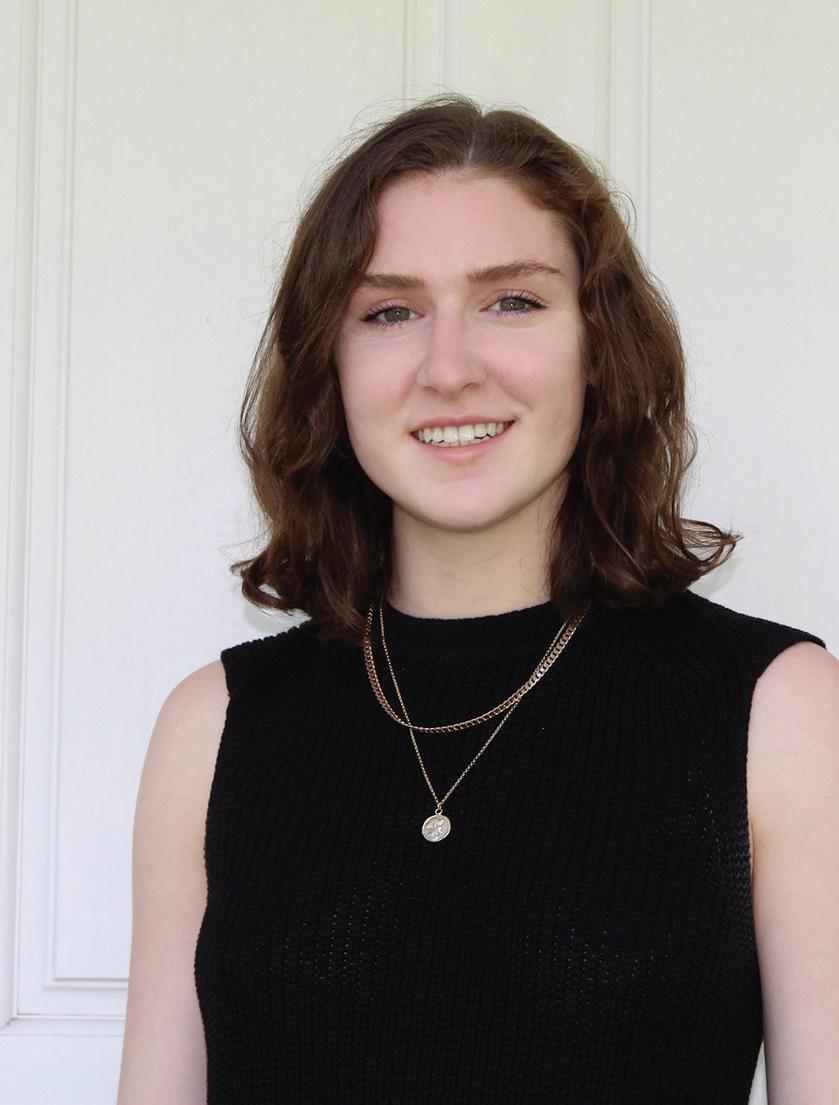
Chidinma Iwu
Chidinma Divine Iwu is a Nigeria-based freelance journalist who spends a lot of time producing data-driven analyses, feature stories, opinion pieces, and reports. Her work centers on developments and trends in the future of technology, gender, culture, and sustainability; and she’s very keen on making her coverage of these beats human centric. Some of her best pieces have been published in the Daily Dot, Forbes Advisor, Shondaland, Paste, the Daily Mail, Container Magazine, and more. She is also a marketing and content strategist who has managed and designed several content strategies for over four years, after discovering her obsession with growing her little humor blog. Her freelance writer community, Crealo Africa, has helped many young African writers find guidance and strong footing in navigating the deeply exploitative market of freelance writing.
If she’s not writing or thinking or advocating for women, Chidinma is either on Netflix or doing some heavy reading. She’s not very keen on books, but bring all your essays, though!

Christopher Allbritton
Chris Allbritton has covered conflicts in Iraq, Lebanon, and Pakistan. As Reuters’s Pakistan bureau chief, he led the coverage of the killing of Osama bin Laden and broke stories on Pakistani cooperation in the U.S. drone war. His work on technology, Islam, the Middle East, U.S. foreign policy, and travel has appeared in Time Magazine, New York Magazine, the Wall Street Journal, the Associated Press, Popular Mechanics, the New York Daily News, the San Francisco Chronicle, Newark Star-Ledger, Singapore Straits Times, and Der Spiegel.
Allbritton is a new media pioneer. In 2002, he founded the award-winning blog Back-toIraq.com, which was among the first to use the crowd-funding model for journalism. He holds an MS in journalism from Columbia University and a BA from the University of Arkansas. For 2008-2009, he was awarded a Stanford University John S. Knight Fellowship.
Allbritton enjoys scuba diving and adventure travel and once journeyed across the Pacific—from Bangkok to Bogotá—by cargo ship.

CONTRIBUTORS SPRING 2024 WORTH.COM 10
Sarah Powless



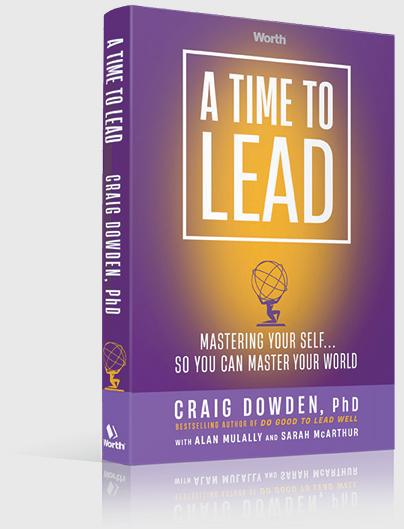
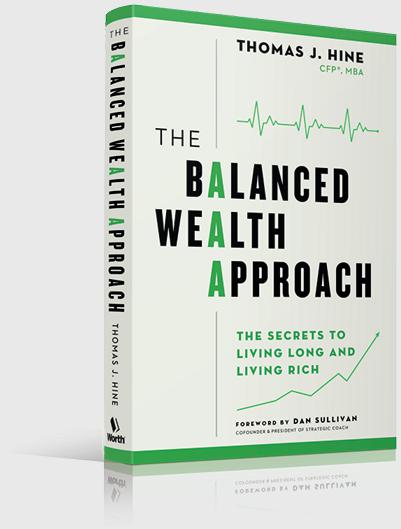


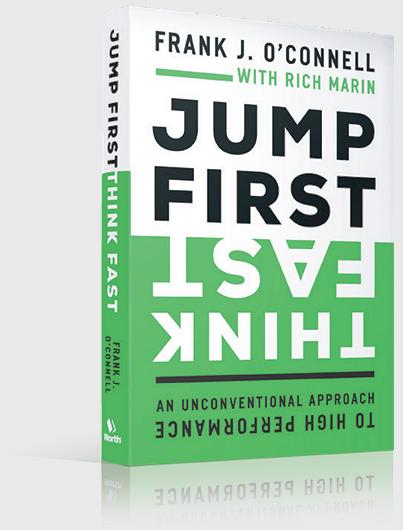
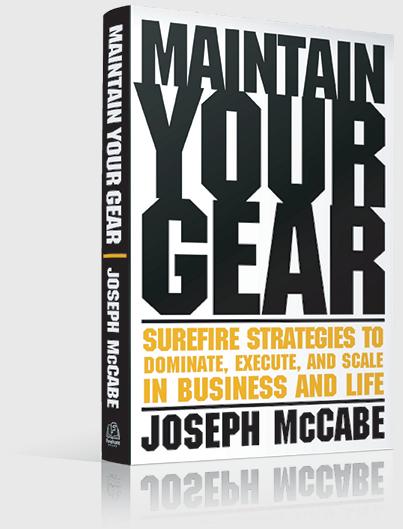
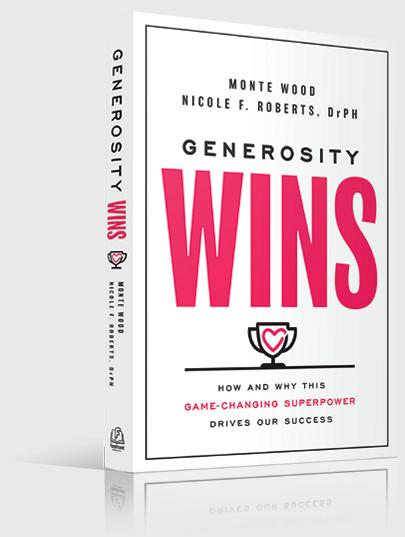


The Taste of Place
Master Distiller Rachel Barrie puts a sense of place in every bottle of Scotch she produces.
BY GABRIELLE DORÉ
It takes so little to say so much. The flick of the wrist, followed by a focused breath and a delicate yet deliberate sip, opens the door to the hidden world inside a “wee dram.” It is a character within a night’s story all in its own right. Scotch whisky has a special place in my memories.
To me, Scotch means going to the liquor store—when I was far too young to be allowed to—with my Papa, staring down the wall of single malts, deciding what we should add to the shelf. And now it’s him sitting at his desk, me in his big leather chair just beside every Friday, choosing which bottle will mark the end of our week. Was it cold or rough? Yes? Then choose an Islay. Do we have something to celebrate? Then choose a Speyside treat. Maybe it wasn’t anything special, so let’s pour something to make it so. Scotch whisky, and its homeland, carry a familial warmth for me.
Luckily, Scotland has called me twice before, and for vastly different reasons. In that tradition, for my third trip, I got to visit three distilleries under the helm of the first lady of whisky, Rachel Barrie.
SCOTLAND
SPRING 2024 WORTH.COM 12 COURTESY OF BENRIACH

My first stop was in the highlands sub-region, Speyside, at BenRiach (Ben-REE-ick) Distillery. Speyside is the country’s largest single malt producer, responsible for more than 60% of Scotland’s output (The Whisky Exchange). Spirits from this region are known for their fruit-forward characteristics with popular notes like apple, pear, and dried fruit.
When we arrived at BenRiach, we were greeted by our guide, Stewart. From his solid-metal bald eagle belt buckle to his rebuilt rally race car
and floral collared shirts, you can imagine the vast valley of stories behind him. He was engaging, passionate, and came with the unique journey of traveling from the production floor to brand ambassador. He knew the ins and outs of not only the brand but could also tell us where each whisky was in the distillelry process just by the smell of the mash or the head of the wort.
BenRiach was built in 1898 by John Duff but closed two years after the Pattison Crash of 1899. The Pattison Crash, aka the Whisky Crash, was the result of whisky producers and brothers, Robert and Walter Pattison, artificially inflating the value of their property holdings and repurchased whisky inventories at elevated prices, which they had sold earlier. When the creditors came knocking, the company collapsed into liquidation due to the excessively exaggerated worth of their stocks. The Pattison Crash is still known today as one of history’s greatest cases of embezzlement and fraud, as it led to global consequences for the Scotch whisky industry.
BenRiach lay mothballed for 65 years until being bought by Seagram Distillers. Today, BenRiach is owned by Brown-Forman and BenRiach Distillery Co. and sits as a jewel in the crown of Rachel Barrie.
“I did medicine first. Wasn’t for me, too much blood and gore, and with the smell of formaldehyde—I thought nah. So, I picked chemistry because I loved creating things,” Barrie quipped with a smile, in her Scottish accent when we spoke.
When she graduated university Barrie “just happened to spot a job at Edinburgh University, on the last day it was advertised, at the Scotch Whisky Research Institute. And that is such a small institute,” she detailed, “I didn’t even know it existed. And I just said, ‘Wow, that is for me.’ Because it combined my hobby, whisky, with my passion, chemistry.”
She would spend the next three years as a whisky analyst studying flavor until moving on to production. In 2003, she became the first woman in world history to be named “Master Blender.” Fifteen years later, she became the first woman of Scotch to be inducted into Whisky Magazine’s Hall of Fame—thus why she is often referred to as “The First Lady of Whisky.”
During our conversation, I asked how she goes about her blending process and what she tries to imbue into each whisky. “It must never be boring,” she began. “It must have an identity and a richness of character and charisma like a person. They have to play a tune on your palette and tell a story with a beginning, middle, and come to an end with a rewarding and alluring finish.”
Of her three distilleries, she describes BenRiach as eclectic. “I experiment at BenRiach. It surprises, it’s got rhythm to it,” described Barrie. As a character, it’s “a lot more new world, than old world.”
After our day at BenRiach, we went to Dowans Hotel in Aberlour. The boutique whisky hotel is situated atop a hill overlooking the beautiful highlands. Consistently, they stock over 500 single malt whiskies, including rare gems such as a 1940 Macallan and 1953 Glen Grant. Each of their 16 ensuite rooms is named after one of the neighboring distilleries. I found myself in “Tomintoul,” with an incredible valley view.
That evening, we headed to dinner at The Station Hotel for their 10-course Still & Stove Tasting Menu with coinciding whisky pairings from the distilleries. Chef Henry Lapington’s flavors were a focused showing of Scotland’s native gastronomy. Each dish was balanced, bright, thoughtful, and acid-centric. Lapington’s mutton dish stands out as it defied the typical stereotypes that come
13 WORTH.COM SPRING 2024
with the protein. It was light, and not the typical palette-killing, richly weighted bomb. I have tried other Scottish chefs’ tasting menus highlighting ingredients native to Scotland; none have ever painted the country’s gastronomical identity this way.
One of the most bewildering creations was the final “chocolate” dessert. Each bite is imbued with a beautifully balanced mocha quality, but there is nothing of the sort in it. Lapington figured out how to combine local ingredients such as malted barley and sunflower in such a way that it evolved the flavors into an imitation of chocolate or mocha.
The following day we headed off to both GlenDronach and Glenglassaugh Distillery.
GlenDronach (Glen-drawnICK) was founded in 1826 in Forgue, making it one of the first licensed distilleries in Scotland. It would remain open for the following 170 years, passing through five hands before being mothballed in 1996 by its thenowners, Allied Distillers (GlenDronach Distillery). It would resume production just six years later, and then be taken over in 2008 by BenRiach Distillery Company Ltd.
Since being appointed master blender in 2016, Barrie has worked to maintain the distillery’s legacy. “GlenDronach means ‘Valley of the Brambles,’” explained Stewart. Thus, Barrie has made a point to maintain a rich vein of dark fruit throughout its whiskies. “It’s very robust and solid. It’s got a real weight to it. But it also has this beautiful fruitness to it.”
Currently, Barrie is increasing the use of Pedro Ximénez sherry casks. “GlenDronach works well with sherry casks. I’m dialing up the use of Pedro Ximénez casks, which are like the ‘king of sherry,’” Barrie detailed. The

“Wherever you are, you’re going to be transported,” quipped Barrie. “I love people in the Midwest, who are nowhere near the ocean when they nose Sandend and go ‘Ah, reminds me of the sea.’”
choice to use predominantly Pedro Ximénez casks for GlenDronach’s Cask Strength Batch 12 has paid off, winning tenth place in Whisky Advocate’s top world whiskies of 2023. But that wasn’t her crowning achievement of the past year.
In December, Barrie was awarded “World Whisky of the Year” for Glenglassaugh’s Sandend from Whisky Advocate. She is proud to see how her “sleeping giant is now up there with the industry giants.”
Glenglassaugh (Glen-GLASSuh) in Portsoy, on Sandend Bay,
SCOTLAND
SPRING 2024 WORTH.COM 14 COURTESY OF BROWN-FORMAN


was built in 1875, brushing up against the edge of Sanded Bay, surrounded by a valley of yellow gorse flowers. “You couldn’t get much closer to sea without being in it,” Barrie describes. It would be open and shut time after time, with its most recent shuttering in 1985. The distillery would lay dormant until Stuart Grant, former distillery manager at William Grant & Sons, came in November 2008 with financiers to “buy back the name and all the casks under it still in storage going back to 1963,” Stewart explained. BenRiach Dis-
tillery Co. bought Glenglassaugh in 2013, where it has now stood alongside BenRiach and GlenDronach for over 10 years.
If you pick up any bottle of Glenglassaugh, you’ll find the words “Shaped by Land & Sea” on the bottle. As we walked with Stewart, he explained that “the minerality of the water is four times higher here than at any neighboring distillery, with 220 mineral parts/million.” This is because the Glassaugh spring filters through a bedrock of lime.
The air of Glenglaussaugh also plays a crucial role. “The wooden washbacks take in the influence of the micro yeast, the microflora, in the air coming off the surf during fermentation,” detailed Barrie. “And that affects the whisky, giving it this incredibly distinctive umami flavor.”
The Sandend single-malt is “a blend of past, present, and future,” explained Barrie. “It’s the sense of place. As a child, I grew up learning to surf in the bay, smelling the coconut of the gorse flower. And then would go and enjoy the sweetness of a tropical fruit drizzle on my vanilla ice cream from the little ice cream shop right in town. I always remembered that taste.”
It should then come as no surprise that if you had to break down the whisky into its main characteristics, it would be coconut, sea salt, vanilla, and a boatload of mouth-watering minerality. “First-fill bourbon casks work so well because they bring out the vanilla and the coconut of the yellow gorse flowers,” explained Barrie. “Then the Manzanilla casks dial up the sweetness and sea salt.”
One brisk morning, Stewart lead a walk down the gorse field onto the bay. He handed me a bunch of the flowers to understand their unique coconut scent. As the morning sun shined on low tide, he took out a bottle of Sanded, had us take a deep breath of the surf and gorse, and nose the whisky. We were standing in Rachel Barrie’s childhood memory.
“Wherever you are, you’re going to be transported,” quipped Barrie. “I love people in the Midwest, who are nowhere near the ocean when they nose Sandend and go ‘Ah, reminds me of the sea.’”
15 WORTH.COM SPRING 2024 COURTESY OF BENRIACH
Innovation at Full Throttle
Additive manufacturing: Czinger’s secret weapon in hypercar innovation.
BY OLIVER RIST
In the rapidly evolving world of hypercars, Czinger Vehicles, a relatively new entrant in the auto industry, is not just making waves but creating a tidal shift with its groundbreaking approach to car manufacturing and design. Founded in 2019 by Kevin Czinger and based in the aerospace hub of Torrance, CA, the company has swiftly positioned itself at the forefront of automotive innovation. At the heart of Czinger Vehicles’ meteoric rise is its flagship, the Czinger 21C, a hypercar that seamlessly blends art with engineering, redefining the boundaries of speed, design, and technology.
Czinger Vehicles made big waves this past year on two fronts. First a super-sexy, record-setting hybrid hypercar, the Czinger 21C. Second, Czinger invented a new manufacturing process combining its 3D printing technology and design software. The upstart automaker has got competitors drooling and may change how the world builds cars. we spoke with Kevin’s son, Lukas Czinger, the COO
of Czinger Vehicles to learn more about how they did it.
“We’re new to the auto market, and we knew that to succeed and get real name recognition in the industry and with customers, you need to do something innovative,” he said. “So we decided not to build the car using components from other companies but make our own.”
And the result is more than im-
pressive. Czinger unveiled the car this past August during the annual Monterey Car Week. Lukas indicated the company wanted to showcase both the car and the manufacturing process. But based on the 21C’s performance, I’m betting most attendees were too busy ogling to get much sense of the car’s underlying tech.
And it’s easy to see why. The car is gorgeous, and it’s got performance stats that back up its rocket-ship looks. The 21C is a little longer than the average hypercar due in part to a hybrid design that marries a twinturbocharged, flat-plane 2.9-liter V-8 engine to a two-motor 800V electrical drive system. The combination delivers around 1,350hp and can push the car to a top speed of just over 270 mph, which puts the 21C in the most elite ranks of the hypercar market. In a cool touch, it’s also reminiscent of a fighter jet when you look inside, as the driver and passenger sit in a single file rather than next to each other.
But once you can stop staring at the car long enough to dig into its design, you’ll probably be more impressed with how it’s built.

AUTO
SPRING 2024 WORTH.COM 16
After he came up with the new tech, Lukas’ father turned it into a separate company called Divergent Technologies, though both Czinger Vehicles and Divergent are housed in the same complex. Lukas joined the group shortly afterwards.
“When I saw what dad was doing, I thought it was cool. I studied electrical engineering in college, which was a good fit,” he says. “I also love cars, so it was an easy decision to work here.” Using the new manufacturing process developed in Divergent lets the company produce components that Czinger says are lighter than those in competing hypercars, but just as strong.
Czinger calls its new process “additive manufacturing,” and it employs a combination of its own 3D printing technology, custom design software based on proprietary machine learning algorithms, and even custom alloys.
The company chose to put the new tech into production in the 21C’s hypercar format first because Czinger felt those vehicles would get the most benefit from the greater
strength of Divergent’s components. That strength and their lighter weight directly translate into the 21C’s performance.
The process isn’t used to build the entire car yet, but it does account for most of it. Currently, Czinger says Divergent produces a long list of smaller parts that Czinger combines to form the chassis and key engine components. “Right now, the largest component we produce that way is the transmission housing, but that’s a big part of the 21C’s performance,” says Czinger.
Initially, however, Czinger said the company didn’t demonstrate Divergent’s capabilities that way.
“While we were developing the tech, we had a concept car we called the Blade, but it wasn’t a hypercar. We just needed something to show investors so they could understand what the result would look like,” he said. “But when we were ready, we applied the Blade’s tech to the 21C and took it to Laguna, where we set a new speed record for a production car. That put us on the map.”
As of late 2023, the 21C is ready for production. Czinger says it will only manufacture 80 cars in the first run, and most all of them are already sold. If you’re still hoping to snag one, the company has dealers globally, including Frankfurt, Germany, London, Tokyo, and North America. The manufacturing run is limited not only because of cost but also customization. “Our customers can build their version of the 21C,” says Czinger. There’s a long list of customizable components, from the exterior look to how the interior is configured.
What Kevin Czinger invented isn’t just a new way of making things, it’s also a better way. According to Czinger, it results in superior parts and less overall waste during manufacturing, which makes Divergent a more eco-friendly company, too.
Both Divergent and Czinger Vehicles have big plans for the future. Czinger reportedly has plans for six new models after the 21C to be delivered by 2030. The only one that’s openly revealed thus far is the Hyper GT. Czinger teased this stylish-looking coupe back in 2022 but says it’s now a confirmed future production model that will use the same engine design as the 21C.

17 WORTH.COM SPRING 2024
Crowd Surfing
Dive into a world where artists and fans connect beyond the music, creating magical moments at sea.
BY KIRSTEN CLUTHE
Going to a music festival can often be a mind-blowing experience, but not all of us are enchanted by the idea of camping out in the Black Rock Desert for a week of primal hedonism. Even in less rustic environments, finding decent accommodations and better-than-average food is often a hassle, not to mention the unpredictable weather. This year, instead of grappling with the elements at Burning Man or Coachella, consider attending a festival at sea.
Music festivals at sea have been around for over a decade. Coachella even jumped on the bandwagon back in 2012 with the Coachella Cruise. Hosting only 2,800 fans, it was the opposite of Coachella in the desert, which now hosts 125,000 people each weekend. Those who were on the Coachella Cruise were able to hang out by the pool with Jarvis Cocker from Pulp, attend a wine tasting hosted by James Murphy of LCD Soundsystem, and join a literary event hosted by Father John Misty. That type of access still exists on board the modern music cruise . At sea, the audiences are manageable, the performances are intimate, and the hallway conversations often include your favorite rock star.
Atlanta-based Sixthman has been holding music festivals at sea since 2001. They collaborate with artists, managers, and agents to redefine the music festival by combining it with a vacation and in the process, break down the fourth wall. Producing festivals with hospitality and the fan experience at the forefront ensures guests return to music cruises year after year. “Super serving is the best way to describe it, for fans and artists alike,” says Mike Simon, a talent buyer for Sixthman. “We cater to exactly the type of experience fans want while being at sea, in a tropical location, on vacation—elevated with multiple stages and fun activities like a live Q&A with the performers or hosting a game with the bands involved.”
Artists benefit from the experience as well, Simon says. “Everyone is there for the duration of the festival, exploring and getting to know each other. By day two and three, the ship becomes home, and the energy in the artist’s lounge is magical.”
Nashville-based singer-songwriter Maggie Rose has performed on several music cruises. “So many of the people I met on those trips have become lifelong fans. The cruises facilitate a really special kind of relationship between artist and listener because there’s more access to one another. One of my favorite experiences was playing on the Cayamo cruise because it was a great fit musically and so many of the people I met were returning from previous years, excited to enjoy a week of perfectly curated music from familiar artists and make new discoveries, like me! I’ve since joined Sixthman for the blues cruise and beach boys cruise.”
The collaborative nature of the festivals also benefits the artists in a way that supports their work. Oftentimes, the headlining artist is programming the festival line up, as was the case for 2023’s Headbangers Cruise. Lamb of God was the host partner, so their management company and agency worked with Simon and his team to develop the show. As Simon explained, Sixthman was helping the artist realize their creative vision for the festival. “The festival is booked with artists that the host talent wants to have on the ship and who they

know their community will be excited to see.” Randy Blythe, the lead singer of Lamb of God, is also a surfer and is already scouting out surfing expedition spots for the next Headbangers cruise. “It’s that elevated experience that fans can only get on one of our boats.”
CEO Jeff Cuellar explains, “Some artists are now creating their own whiskeys, or they have their own beers and different types of things they’re creating. Our environment works so well because we can showcase all that to a dedicated audience. It’s a way to curate a lineup, not only of bands, but also experiences.” But, what about the vacation part? Cruises offer something for everyone
MUSIC
CRUISE
SPRING 2024 WORTH.COM 18

at every price point, and a Sixthman festival, like other themed cruises , is no different. The customer service team is engaged with guests early on to ensure that their trip is tailored to the type of vacation they want to have. If a guest knows that they want to dine in the steakhouse on most nights, for example, they can bookmark that with Sixthman customer service rep, and it will be integrated into their package.
It’s also a vacation for the artists. “The different venues give each show a different experience so it never feels stale, “ says Maggie Rose. “The outdoor daytime pool party set can feel totally different from the sultry evening lounge vibe. It also allows us to switch up our set lists and it challenges us
“The outdoor pool daytime pool party set can feel totally different from the sultry evening lounge vibe,” says Maggie Rose.
to show some repeat concertgoers everything we can. I also love the friendships that I have struck up with fellow artists on the ship and the spontaneous collaborations that come from us all being together. By day three I am greeting guests and artists at breakfast like they’re old friends. I always hit the spa, gym and casino and there is never a chance of going hungry.”
Cruise travel is one of the fastest sectors of tourism, according to the Clia State of the Cruise Industry Report. Post-pandemic, cruise travel has not only been reinvigorated, but cruise lines are attracting younger travelers seeking immersive, bucket-list experiences like seeing
19 WORTH.COM SPRING 2024
MUSIC CRUISE

their favorite band up close in an intimate setting. Wellness and health cruises have also become major priorities for cruise lines, as have themed cruises that go beyond a music festival. Expedition cruising, one of the fastest growing cruise experiences, takes passengers off the cruise ship for guided tours to remote locations via kayaks and submarines. Hospitality brands like Ritz-Carlton Yacht Collection have also expanded into maritime offerings by transforming cruises into resort-like journeys where each state room has a private balcony and world-renowned wineries and chefs offer master classes and sommelier dinners.
The accelerated growth of the cruise industry offers tremendous growth opportunities, according to Sixthman’s Cuellar. “I only see room for growth at this moment. I don’t think there’s an oversaturation. I think there’s space for more, and I’m excited about what we’ve got in store for 2024, 2025, and beyond.”
Sixthman is already diversifying into different entertainment genres, exploring culinary experiences, Broadway performances, and cruises themed around popular TV shows, like the upcoming Hallmark Channel Christmas Cruise -- a chance to vacation with your favorite Hallmark stars. They’re also building immersive cultural activities into cruise itineraries, allowing passengers to connect with the destinations they visit on a deeper level.
For those unsure about taking a cruise or questioning its value, Cuellar and Simon agree—a music cruise delivers an unparalleled experience. Onboard entertainment, access to performers to behind-the-scenes moments are more than worth the plunge when combined with the luxury of a cruise and beach vacation. More than 50% of guests return yearly, reinforcing the value. Cuellar encourages skeptics to take the risk, promising an unforgettable return: “Just let go, take the chance, take the risk. I promise you will not regret it. You will come back.”
UPCOMING FESTIVALS
Cayamo: A Journey Through Song returns for its 16th edition, sailing March 1-8, 2024, from Miami to the gorgeous beaches of Puerto Plata, Dominican Republic and Oranjestad, Aruba aboard our musical haven, Norwegian Pearl. We’ll float through the Caribbean surrounded by beautiful melodies and even better company. Cayamo, March 1-8, featuring Lyle Lovett, The Mavericks, Billy Bragg, Shawn Colvin, and Lucius.
The Broadway Cruise, heading from Miami to Key West and Grand Cayman, March 13-18, 2024 on Norwegian Pearl. Prepare yourself for 5 days of dazzling shows and intimate performances from Broadway’s top talent. Gain tips, tricks and trade secrets through immersive workshops and interactive panel discussions with some of the most inspiring creatives working today. The Broadway Cruise will feature Christian Borle, Kerry Butler, and Reeve Carney
Join this floating blues-rock party on the 9th edition of Keeping the Blues Alive at Sea! Sailing March 18-22, 2024, Norwegian Pearl will cruise from Miami, Florida, through dazzling blue seas to Cozumel, Mexico. Four days and nights of live shows, rare collaborations, and unique activities. Amenities include spa services, complimentary and specialty dining, shopping, and all the frosty beverages your heart desires! Keeping The Blues Alive will featureJoe Bonamassa, Grace Potter, The Marshall Tucker Band, and John Oates
Embark on a delectable journey aboard Chefs Making Waves! Sip, savor, and share in an exceptionally harmonized, all-inclusive vacation round-trip from Miami to Nassau and Great Stirrup Cay on March 25-29, 2024. With your favorite culinary talents in tow, partake in nightly curated seated dinners, catch transformative cooking demos, enjoy featured mixologists, groove to an array of live entertainment, and more. Chefs making waves, include Aaron Sanchez, Andrew Zimmerman, and Anne Burrell
Headbangers Boat: Heavy Metal thrashes through the high seas October 28-November 1, 2024 aboard Norwegian Gem! Sail with pure American metal gods, Lamb of God round trip, Miami to Puerto Plata, Dominican Republic. Prepare for a relentless onslaught of heavy riffs, fierce vocals, and immersive experiences with your favorite metal artists set against the backdrop of the open ocean.
SPRING 2024 WORTH.COM 20





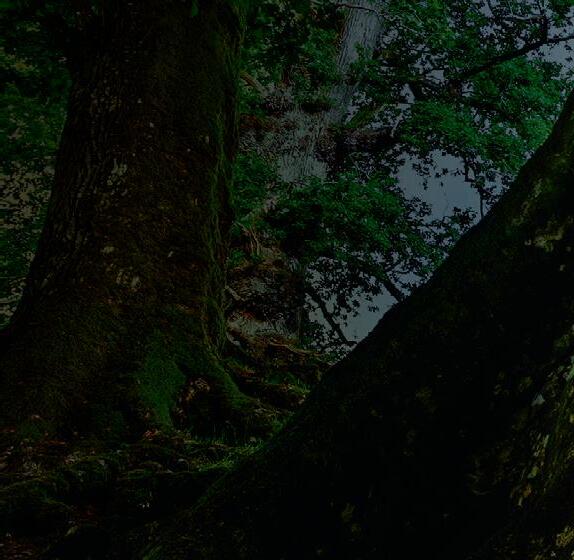






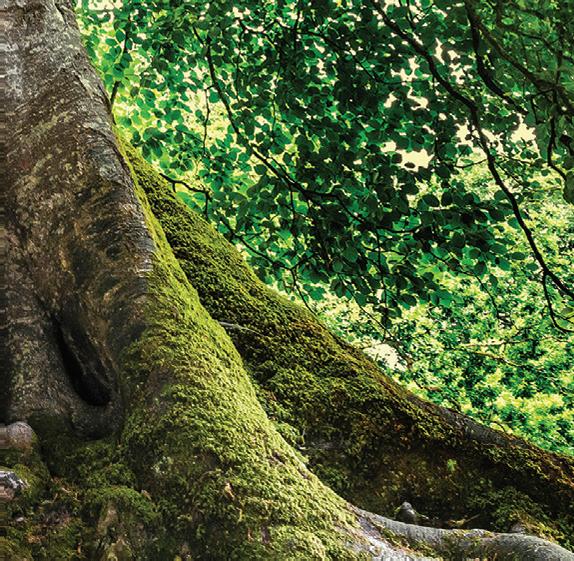

How to Pick the Right Private Jet Pricing Plan
Whether called jet cards, memberships, clubs, or programs, the real choice is between fixed or capped hourly rates or dynamically priced flight plans.
DOUG GOLLAN
After you decide to fly private, you’ll have to decide on the best service plan for you. Private jet plans go by various names—jet cards, memberships, clubs, or programs. However, the differences in plans have more to do with what the providers choose to offer than the terms they use to market their offerings.
Wheels Up’s “membership,” for instance, allows you to make a deposit and provides fixed/capped rates and guaranteed availability—the core attributes of the traditional jet card that Sentient Jet invented in 1999. In VistaJet’s lingo, those terms are called “the Program.” FlyExclusive dubs them Jet Club.
Air Charter Service offers all three jet card options you might encounter from providers. The first offers fixed hourly rates, while the second has capped hourly rates—which can be lower but not higher than the cap. The third plan has prices that are set dynamically, based on demand.
Here’s how the three types of pricing plans can work across the top providers in the U.S.
FIXED HOURLY RATE PLANS
Businesses often favor these programs, as they make it straightforward to budget how much their flying is going to cost. But there are some variables that you must keep in mind.
If the hourly rate for a light jet is $6,400 per hour, that doesn’t mean a 45-minute flight will cost $4,800 (three-quarters of $6,400). Most fixedrate programs tack on taxi time— typically six minutes for takeoff and six for landing.
You also must find out if the 7.5% federal excise tax is included in the rate. You pay the FET for all continental domestic flights, and for the portion of an international flight that takes place over the Continental U.S. Then come possible fuel surcharges. And even if there are not currently any, you should ask if the contract permits them in the future.
Lastly, you need to find out the daily minimums you will be charged for the aircraft size or type you are considering. And ask if taxi time is included in the daily minimum.
On short flights, you may pay less with the provider that has a higher hourly price. Assuming fuel surcharges and FET are included, a program with an $8,000 hourly rate that has a 60-minute minimum (generally the shortest offered), including taxi time, will run you $8,000 for that 45-minute flight. The cost for the same flight with a provider marketing a lower $6,400 hourly rate, but with a two-hour daily minimum, would actually be $12,800.
“It may make sense to join several programs, such as one with 60-minute minimums for short flights and another suited for longer flights. Or use dynamic pricing for high-traffic routes and flexible-time flights to save significant money.”
CAPPED HOURLY RATE PRICING
With capped hourly rates, you won’t pay more than the contracted hourly rate. But you may pay less if you are flexible enough to move your flight to a low-demand part of the day, or even move your travel dates. Wheels Up’s Core Membership and Air Charter Service’s Gold level jet card, for instance, offer capped hourly rates.
You also need to find out if the fixed or capped rates come with guaranteed availability.
With as-available programs, in contrast, your rate is locked in, but you may need to be flexible as to when the provider can fly you. Availability is usually not an issue if you are open to flying on lowerdemand midweek days.
Two last points on fixed and capped hourly rates.
First, find out how long they apply. Typically, you will get a rate lock of 12 months. However, some contracts allow the provider to change rates with as little as 14 days’ notice. You also have to check peak-day terms, which have longer lead times for booking and can include surcharges. Or in some cases, providers switch to the next pricing type.
DYNAMIC PRICING PLANS
With dynamic pricing, rates vary based on when and where you are going. These programs will often promote that they don’t have peak days, daily minimums, fuel surcharges, or charges for taxi time. Rather, the price they quoted will factor in all those components.
PRIVATE JETS
SPRING 2024 WORTH.COM 22
If you check out Vista Global’s FLYXO.com website, you can see it in action, where prices can double on some dates, based on supply and demand. This method also takes into consideration repositioning, such as flying an empty airplane to you before your flight or on to its next customer or back to base after it drops you off.
Dynamic pricing works best when you are traveling between two airports that have a high level of private jet activity. A flight somewhere under three hours, between low-traffic locations such as Yakima in Western Washington and Kansas City, is prone to be about double the cost of a similarduration flight from New York to Miami—cities likely to have customers at the ready before and after your flight.
When using dynamic pricing, the willingness to go to a nearby airport, say Palm Beach instead of Boca Raton, could save a couple thousand dollars on repositioning. But prices vary every time.
Flyers tend to be a bit shy about dynamic pricing. In a survey of subscribers to buyer’s guide Private Jet Card Comparisons (where I’m founder and editor-in-chief), 50% said they prefer fixed or capped pricing, vs. 5.5% who prefer dynamic pricing. The remainder said they are not sure.
You may find it makes sense to join several programs, based on your flying needs: one with 60-minute minimums for short flights and another that is better suited for longer flights, for instance. Or you could end up using dynamic pricing for high-traffic routes and flexible-time flights where you can save significant money.
Keep in mind that most dynamic pricing programs requote if there is a mechanical problem or sick pilot. That can mean paying more than your original price. Many fixed- and capped-rate cards provide the replacement aircraft on the original terms. Other factors, such as whether or not deicing is included, may also impact how much you are paying in the end.
CUTTING THROUGH TERMINOLOGY
Flying privately is like a time machine in how quickly it gets you there. It is a 100% improvement in terms of airport experience and convenience. In many ways, the most arduous part is making sure you are speaking to the right providers, based on your needs.
Most of all, remember that what companies call their programs doesn’t make a difference. It’s how they price your flights that matters.

23 WORTH.COM SPRING 2024 GETTY

7 Nutritional Hacks for Depression and Anxiety
The natural cures for anxiety and depression may be hiding in your microbiome.
BY DEBORAH GRAYSON
At any moment in time, approximately 26% of Americans are struggling with a diagnosable mental illness. So, if you have dinner with three friends, the odds are one of you is not doing well. Most common are depression and anxiety, with a 29% chance of receiving a depression diagnosis in a lifetime, and a 31% chance of experiencing anxiety. Many people suffer from both.
Unfortunately, most of us don’t make the connection between the way we feel and labels like depression and anxiety. We assume that having low energy and being unmotivated or anxious is what everyone experiences.
Dr. Uma Naidoo, a leader in the new field of nutritional psychiatry, Harvard professor, and director of the ground-breaking Nutritional & Lifestyle Psychiatry Program at Massachusetts General Hospital, told Worth, “A family member might tell them they’re acting differently, withdrawn, or losing weight. The same with anxiety. Someone may be waking up with a pit in their stomach and not tie it to anxiety.”
Dr. Drew Ramsey, also a nutritional psychiatrist, and author of Eat to Beat Depression and Anxiety, feels the words ‘depression’ and ‘anxiety’ are bandied about so heedlessly and in so many different contexts, that, not surprisingly, they mean different things to different people. When he and Dr. Naidoo use the words, they refer to diagnoses consistent with the DSM-5, the Diagnostic and Statistical Manual of Mental Disorders, which is the bible used by mental health professionals.
FOOD HACKS
SPRING 2024 WORTH.COM 24 GETTY
A poor diet can cause more than the triumvirate of diseases everyone can recite verbatim–obesity, diabetes, and heart disease. Also, multiple studies conducted over the last 20 years have demonstrated a connection between a poor diet and mood disorders like depression and anxiety. The problem is that most of us haven’t been paying attention to these studies.
ACCORDING TO NAIDOO, HERE’S WHAT THE SCIENTISTS HAVE FOUND
Sugar. There’s an astonishingly high correlation between sugar consumption (from foods and sodas) and depression. The reason may be that sugar impedes the body’s ability to make a protein (BDNF) that is essential for brain growth, development, and stress management.
High-glycemic-Load Carbohydrates. Carbs that are easily turned into glucose (sugar) in the body. This includes anything made with white flour (like bread and pasta), white rice, and potatoes. However, low-glycemic index carbs, like beans and most fruits, are not damaging. Several large studies have shown a correlation between consumption of high glycemic load carbs and depression.
Artificial Sweeteners. Not surprisingly, these compounds which are hundreds of times sweeter than sugar, have multiple negative effects on the brain. Aspartame (think Diet Coke) inhibits dopamine and serotonin. Sucralose causes mice to develop the same gut bacteria tied to depression in humans.
Bad Fats. This includes trans fats, which were banned in the U.S. in 2020, and saturated fats. It also includes many fried foods because even ‘good’ fats, reused many times and kept at high temperatures, can become harmful.
Caffeine and alcohol (if anxiety and/ or sleep are concerns)
THE GUT MICROBIOME IN ANXIETY AND DEPRESSION
Everywhere we turn these days, people are talking about the gut microbiome, the living organisms in the digestive tract that help break down food. We now understand they do much more than that. They create and respond to neurotransmitters that, via the vagus nerve and the circulatory system, are in direct conversation with the brain. Joe Weiss, Gastroenterologist, and Clinical Professor of Medicine at the University of California San Diego, told Worth, “First, you must understand that there are over a trillion species of microbes, and they are everywhere, not just in the gut. They’re floating in the air. We all have unique species on our skin, in our lungs, eyes, ears, etc. They’re even inside cells in the body.” This connection starts when we are embryos. The same cells that become the brain and spinal cord travel through the body to form the enteric (gut) nervous system.
The ones in the enteric nervous system are responsible for most of the body’s serotonin. “Everyone thought serotonin worked only in the brain.
We now know that only 5% is in the brain. Over 90% is made in the gut and stays there,” he added.
Other heavy-hitting neurotransmitters made in the gut include dopamine (pleasure, addiction, Parkinson’s if too low, schizophrenia if too high), adrenaline (fight or flight), GABA (calmness, ability to focus), and acetylcholine (memory and cognition).
The above is why psychiatrists like Drs. Naidoo and Ramsey know they can improve many psychiatric conditions with what amounts to a prescriptive diet. Their recommendations overlap because both are using the results of high-level studies to shape their advice.
Leafy Greens. If Dr. Ramsey’s mantra was summed up in three words, it would be “eat leafy greens.” He’s so passionate about this that he’s even published a recipe book entitled Fifty Shades of Kale. He’s softened his
stance a little in the decade since the book was published. He now concedes that people who don’t like kale can expand their options to Swiss chard, broccoli rabe, collards, and spinach, all of which contain folate, a B vitamin necessary for the creation of neurotransmitters.
Rainbow Fruits and Vegetables. Dr. Ramsey’s favorite color in this ‘rainbow’ is the reddish-purple created by anthocyanins, an especially nutritious flavonoid (food pigment). Berries contain a lot of anthocyanins so I asked Dr. Ramsey about acai and blueberries, two fruits that have attained superfood status. He was dismissive, saying, “The reason I don’t rely on them is they’re expensive, they’re fetishized, and they’re unreachable to the average consumer. Most importantly, they miss the point. They’re no better than any other berry. All berries tend to be interesting and good for you.”
Seafood. Primarily fatty fish (for their omega-3 fatty acids) low on the food chain (to avoid mercury.) Dr. Ramsey points out that farmed salmon is dyed pink so he only consumes wild salmon. Also good are bluefish and mackerel. Vegans can get omega-3s from algae, although it is not as concentrated as in fish.
Nuts, Beans, and Seeds. A study on depressed and anxious college students in Australia a few years ago showed significant mood improvement in those who, among other things, added a serving of nuts to their diet each afternoon. Beans are an excellent prebiotic, indigestible fiber that feeds healthy large intestine bacteria.
Meat. The first controversial category on this list. Dr. Ramsey was a vegetarian but now believes that moderate consumption of ethically raised meat (grass pastured) is healthy, sustainable, lower calorie than grain-fed meat, and contains numerous essential nutrients including a nourishing fatty acid profile.
25 WORTH.COM SPRING 2024
FOOD HACKS
Eggs & Fermented Dairy. It’s doubtful that anyone was surprised to see leafy greens on the list. We all know we should eat our vegetables, but many readers probably bristled at the often-maligned foods: eggs and dairy products. However, both psychiatrists told Worth that studies confirm choline (eggs) has been linked to decreased anxiety. Along with choline, eggs are high in high quality protein and B vitamins. Examples of fermented dairy include yogurt and kefir.
Dark Chocolate. The item everyone has been waiting for. It turns out that (dark) chocolate is brain food. A study using U.S. government data from over 13,000 adults showed a 57%(!) reduction in depression in those who ate dark chocolate. However, if the study is to be believed, this group was eating an average of eight ounces of chocolate a day. If you’d
like a return for a smaller investment that won’t expand your waistline, less than an ounce a day of dark chocolate reduces salivary cortisol, a stress and anxiety marker.
Although both nutritional psychiatrists agree about which foods are mood enhancers, Dr. Naidoo has a slightly different approach than Dr. Ramsey. In her bestselling book, This Is Your Brain on Food, she focuses on specific foods for specific mental disorders.
For depression, she suggests probiotics (fermented dairy, miso, kimchi), prebiotics (legumes), omega-3 fatty acids (fish, dark leafy greens), and the Mediterranean diet (fruits and vegetables), almost all foods on Dr. Ramsey’s list.
Neither doctor is expecting us to adopt a flawless diet. According to Dr. Naidoo, “It’s about exploring a diversity of foods which help your gut,
which helps your mind.” So, if kimchi isn’t your thing, don’t worry. Just increase other foods on the list.
Dr. Naidoo believes anxiety is best controlled by cultured and fermented foods, tryptophan (as a supplement, not from foods), dietary fiber, and omega-3s. The latter two have an anti-inflammatory effect and inflammation is correlated with anxiety. She told Worth, “Poor diet leads to gut inflammation which leads to impairments like depression and anxiety, which often leads people to eat a poor diet. It’s a negative feedback loop.”
A sufferer of anxiety herself, Dr. Naidoo has just published a new book completely devoted to the subject, Calm Your Mind With Food.
I highly recommend both doctors’ books. They’re clear and easy to understand. Most importantly, they’re compelling. I’ve changed my diet since reading them. Maybe you will too.

SPRING 2024 WORTH.COM 26 GETTY

The Art of Charleston
From opera to dance to theater to painting, popular music and more, this small Southern city is enjoying an artistic renaissance that’s attracting global attention.
BY RICHARD BRADLEY
Home to the Charleston Symphony and host to frequent performances of opera, dance, theater and music, the Martha and John M. Rivers Performance Hall at Charleston’s Gaillard Center is one of the most beautiful performance spaces in the United States. But on this pleasingly warm night in mid-December, the action at Gaillard is taking place outside, in the building’s courtyard, underneath a charming European-style tent known as the Spiegeltent, where an audience of about 200 adults has gathered to watch a spectacle that really wouldn’t work in the big room.
Tonight’s entertainment is an English burlesque troupe called Underbelly, a group of attractive young men and women, all impressively curvaceous and/or ripped. As one by one they stride across the round, circus-like stage, they are funny, flirty, and bawdy. Before very long, they are also, mostly, undressed—like, for example, the buxom brunette who seductively tosses her
black lace bustier over my face. (That’s what you get for sitting front row at a burlesque show.) I peel it off in time to see her clamber into what looks like an oversized martini glass, splashing about in its contents before she deftly scissors over the side and drops cat-like to the stage. Meanwhile, a stagehand has retrieved her bustier from its perch on my shoulder.
You might expect to see such Bacchanalia in New York or Chicago or Los Angeles. But Charleston? When visitors think of Charleston, they think Lowcountry, high culture: The small South Carolina city has become a must-visit destination for lovers of architecture, food and history. Visitors stay in one of Charleston’s many outstanding hotels, tour the impressive Gibbes Museum of Art or the Charleston Museum, shop on King Street, and eat very, very well. Others stay a night or two in town before heading to nearby Kiawah Island or another of the area’s romantic barrier islands.
PARTNER CONTENT
Omar at the 2022 Spoleto Fesival
27 WORTH.COM SPRING 2024
PHOTO BY WILLIAM STRUHS
They do not typically come for burlesque. In fact, until now, they may never have come for burlesque.
But perceptions usually lag reality, and the reality is that Charleston is fast becoming one of the most diverse, vibrant and innovative art scenes in the nation. On any given day or night there, you can hear Charleston’s Emmy-winning jazz quintet, Ranky Tanky, playing at the Gaillard; watch an original performance of Broadway’s The Lehman Trilogy at the intimate, 112-seat PURE Theatre; check out Chris Stapleton and Margo Price at Credit One Stadium; see the work of artist Fletcher Williams III at the International African American Museum; hear a performance by Charleston Chamber Music in the historic Dock Street Theatre; catch a show by rising alt-country group Red Clay Strays at the Riviera Theater, a renovated Art Deco movie palace; participate in an interactive opera by Holy City Arts & Lyric Opera; or visit the stunning gallery of painter Jonathan Green, whose gorgeous work chronicles the power and the story of South Carolina’s Gullah culture. Visitors who wish to embrace art even further stay at the charming Vendue hotel, which showcases the work of local artists and even hosts an artist-inresidence.
And all that is without even mentioning Spoleto Festival USA, a 17-day artistic smorgasbord that takes place in Charleston every spring.
There may be no other American city of its size—Charleston has about 150,000 inhabitants—with an equivalent outpouring of creative culture. And all signs suggest that Charleston’s arts have room to grow.
“Right now, Charleston is a foodie capital,” says Mena Mark Hanna, Spoleto’s general director and CEO. “It’s a destination city. But its next iteration is going to be as an artistic center and a creative capital.”
To understand the origins of Charleston’s thriving arts scene, you have to consider the origins of Charleston itself, the dialectical relationship between the health of Charleston’s economy and the vigor of its cultural life. You also have to appreciate the enduring legacy of slavery in South Carolina and the profound contributions of African Americans.
Founded in 1670, Charleston was a hub of the African slave trade almost from its very beginning. From the early 18th century until the newly formed United States abolished the slave trade in 1808, slavers transported an estimated 125,000 Africans to Charleston, where many would be sold at the now infamous Gadsden’s Wharf. Most of the enslaved Africans would be forced to work growing cotton, indigo and rice on plantations across the state. Their enslavement was brutal and barbaric; an estimated one-third of the Africans brought to Charleston died within a year of their arrival. But for whites, the slave trade produced wealth unrivaled anywhere else in the colonies. By 1776, according to historian Amrita Chakrabarti Myers, 90 percent of the richest people in the American colonies lived in Charleston.
Seeking to replicate European culture, South Carolina slaveholders used their wealth to patronize the arts. Their homes and plantation mansions were the grandest in the colonies, stocked with commissioned portraiture, imported furniture and Chinese porcelain, protected by wrought iron railings forged by slaves.


In addition to the slave trade, the resulting demand for imported goods made Charleston a center of global maritime commerce.
“You cannot talk about American history without talking about Charleston,” says painter Jonathan Green. “And you can’t talk about Charleston without talking about England, France, Portugal, Spain, Italy and Africa.”
The desire of white colonial Charlestonians to fashion a life of ease and sophistication extended into the world of public art; the city’s Dock Street Theatre was the first structure in the colonies built specifically for use as a theater. In 1736, the year of its opening, Dock Street premiered an opera called Flora, thought to be the first production of an opera in the New World. (Most colonists were more concerned with survival than libretto.) The tragic juxtaposition—an economy based on brutality, its profits channeled into high art—can’t be overstated.
28 PARTNER CONTENT
SPRING 2024 WORTH.COM
Burlesque under the Spiegeltent at the Charleston Gaillard Center
Art displayed at the Vendue Hotel
PHOTO BY AMOS ADAMS



The American Revolution and the Civil War challenged white Charleston in physical, psychological and economic ways, and of course the latter finally brought an end to slavery. During Reconstruction, Charleston struggled to recover economically during the transition to a free labor economy. The city’s maritime economy, already waning before the Civil War, declined precipitously afterward. Not until the opening of a naval base in the city in 1901, and the subsequent construction of railroad lines into Charleston, did the city begin to develop a new economic foundation.
In the 1920s, with its population and its economy growing, Charleston entered a period of artistic creativity now known as the Charleston Renaissance. The newly founded Preservation Society of Charleston devoted itself to saving the city’s historic architecture. Local writers were producing works of history,
poetry, theater and fiction. Most prominent were Dubose and Dorothy Heyward, who wrote the play Porgy, which George and Ira Gershwin and Dorothy Heyward later adapted into the classic “folk opera” Porgy and Bess
Perhaps the most influential contributors to the Charleston Renaissance were its painters, especially Alfred Hutty, Alicia Ravenel Huger Smith, Anna Heyward Taylor, and Elizabeth O’Neill Verneer. Focusing on the architecture, landscape and people of Charleston and the surrounding Lowcountry, they helped to define Charleston’s identity; their work promoted the city to outsiders and fueled growth in tourism. Many of those who came as visitors would eventually stay as residents.
In the decades after World War II, Charleston’s economy stumbled again, confronting its biggest challenge in 1993, when the federal government closed the nearly century-old naval base. But the most important event in Charleston’s modern history was the 1975 election of progressive Democrat Joe Riley as mayor. A visionary leader, Riley focused on rebuilding the city’s economy while addressing its painful racial history. He would serve ten terms as mayor and play a huge part in the city’s rebirth as a cultural crucible.
For one thing, Riley believed that Charleston should have an arts festival—specifically, an American version of an Italian festival known as Festival Due Dei Mondi (“The Festival of Two Worlds”). An Italian composer named Gian Carlo Menotti had founded the festival in Spoleto, in central Italy, in 1958, and hoped to bring it to America. With its international flavor and appreciation for the arts, Charleston seemed a natural home. Skeptics argued that such a festival would lose money and undercut the local arts community, but Riley loved the idea.
“What I knew—what I believed—was that a great arts festival, a world-class, world-renowned arts festival, if it was held here, would produce so many positive changes for the city,” he told the Charleston Post and Courier in 2015.
Riley was right. With funding from private donors, the city, and the South Carolina state government, Spoleto was launched in 1977. Since then, it has become a pillar—probably the pillar—of cultural life in Charleston. For 17 days every May and June, across multiple venues, featuring artists from all over the world, Spoleto typically stages more than 100 performances— opera, dance, theater, music of all varieties. It’s an astonishing outburst of very hard work and vast creative energy. Now, as it approaches its 50th anniversary, Spoleto attracts visitors from around the globe, fosters an artistic ecosystem, and elevates Charleston’s reputation for cultural sophistication.
Spoleto succeeds in part due to its ambition, especially in opera, which is the festival’s mainstay; while Spoleto isn’t afraid to be popular, it is never middlebrow. In 2004, for example, festival head Nigel Redden oversaw the production of The Peony Pavilion, an 18-hour Chinese opera, in Chinese, that required four days to complete. If festivalgoers didn’t like The Peony Pavilion, they could take in performances by Alvin Ailey American Dance Theater and Mikhail Baryshnikov. “Nigel was incredibly adept at pushing the avant-garde,” says Mena Mark Hanna, who succeeded Redden as general director in 2021. “You have an audience that has a thirst for experimentalism because of Nigel’s legacy.”
29 PARTNER CONTENT
WORTH.COM SPRING 2024
PHOTO COURTESY OF SPOLETO
USA
Mena Mark Hanna
FESTIVAL

Hanna, the founding dean of Berlin’s Barenboim-Said Akademie, is continuing that tradition while adding his own priorities: challenging the legacy of colonialism in high art and fostering inclusion at every level of festival production. He was an ardent champion of the opera Omar, based on the life of Omar Ibn Said, an enslaved Muslim from West Africa transported to Charleston in 1807. Originally commissioned by Redden, Omar was potentially awkward for Charleston—after all, Said was sold on Gadsden’s Wharf, about a mile from where the opera premiered. But Omar played to packed houses and won rave reviews, winning the 2023 Pulitzer Prize for Music.
This year Hanna is producing the world premiere opera Ruinous Gods, about the heartbreaking journeys of refugee children. “It’s a very difficult piece, but it’s told so beautifully that it draws you in,” he says. Hanna looks for art that has a timeless quality, and he thinks Charleston helps provide that dimension. “You’re going to see something modern and provocative, but afterward you’re walking along 300-year-old streets,” he explains. “There is magic in that.”
Much of Charleston’s cultural boom stems from the fact that the city embraces newcomers. It’s a self-confident place that isn’t
afraid to reach out to larger cities to attract talent. Simultaneously, Charleston has become an enticing locale for creative types who want to escape big city stress but still live somewhere where the arts are practiced at a high level. One example is Lissa Frenkel, president and CEO of the Gaillard Center, who came to Charleston in 2021 after running the Park Avenue Armory, an experimental performing arts space on Manhattan’s Upper East Side.
“What I experienced when I came down here is that the community was exploding in growth,” Frenkel says. “There was this huge amount of people coming into Charleston from all around the country because it has this artistic reputation, and you can come and see artists that you expect to see in New York and Los Angeles.”
Leah Edwards, who, with her husband Dimitri Pittas, founded Holy City Arts & Lyric Opera in 2020, came to Charleston from New York in 2015. Both were successful singers there, Edwards in Broadway roles and Pittas in opera productions throughout North America and Europe. “We came down here for 48 hours in January—it was 65 degrees and there were dolphins jumping in the bay,” says Edwards. Charleston felt to her like a place where you could raise a family in a safe and nurturing environment, while
SPRING 2024 WORTH.COM 30 PARTNER CONTENT
Opening Ceremony of Spoleto Festival USA


also being a city that could support the fledgling opera company she and Dimitri wanted to found. They soon returned to stay.
Sharon Graci, who cofounded PURE Theater in 2003, made her way from western Pennsylvania to Charleston, where she met her husband (and the other PURE cofounder) Rodney Lee Rogers, a filmmaker from North Carolina. “I think the living’s a little easier in this little Eden-by-the-sea,” says Graci. “And if you are into the arts, you will find an outlet for that love here in Charleston.”
Beyond that influx of new energy, a city’s artistic scene requires other crucial ingredients: devoted benefactors, engaged audiences, performance facilities, community leadership, and the support of city government. Charleston has those attributes and one more: a knowledge that it can, and should, tackle the most difficult subjects. Even before the racial unrest that swept the country in 2020, Charlestonians recognized that their city had a moral obligation to address its past; Joe Riley, for example, began promoting the idea of an African American museum in 2002. The 2015 mass shooting at Mother Emanuel AME Church served as a tragic reminder that the past never really goes away, but the fact that the city didn’t erupt in violence
following the shooting testified to the amount of racial healing that had already begun. The arts community had—has—its own part to play.
At PURE, says Sharon Graci, “we did not need the tragedy of George Floyd to remind us that our communities are made up of more than the typical demographic of who comes to the theater. We program for how Charleston looks.” One recent example: a production called The Elaborate Entrance of Chad Deity, a play about race, capitalism and professional wrestling. At the Gaillard Center last fall, Lissa Frenkel produced Finding Freedom: The Journey of Robert Smalls, the story of a South Carolina man born into slavery who escaped bondage during the Civil War and later won election to the United States Congress. With the help of local sponsors, the show was performed gratis before 6,000 low-income students from regional schools.
When Charleston insurance executive Lee Pringle decided in 2012 that he wanted to create a classical music orchestra featuring only Black musicians, “I was focused on how much my ancestors had contributed to the genre of classical music—but weren’t seen as contributors.” Now the Colour of Music-Black Classical Musicians Festival has been performing in Charleston and cities around the country for over a decade. Occasionally, Pringle gets asked why all his performers are Black—wouldn’t it be enough just to have an integrated orchestra? But Pringle is determined to show audiences the depth and breadth of Black classical musicianship. And “because Charleston has such a unique place in American history, I didn’t want my mission to focus on anybody but the people from my community.”
Among many other productions, Omar and the upcoming Ruinous Gods demonstrate how Spoleto can challenge its audiences. But Hanna emphasizes that controversy is not an end in itself. “You don’t want to be transgressional just for the sake of being transgressional,” he says. “You also want to capture the incalculable joy of human expression.” A festival like Spoleto, he says, should prompt conversations that aren’t defined by our political trenches. Often, you do that simply by making people feel. “Art is about the irrational expression of love, joy, humanity and transcendence,” Hanna says. “It makes our heart skip a beat.”
I thought about that while at the Gaillard for a winter performance by students from the Charleston County School of the Arts, a respected arts academy whose graduates populate Charleston’s cultural life. On stage, performing holiday music before a sold-out house of families, friends and fans, the young musicians and singers were strikingly poised, their youth belying their expertise. At one point the conductor announced that, before the next song, the audience would have to learn a bit of sign language—holding hands high, palms facing out, wiggling them back and forth to signify clapping. Then about a half dozen young men and women, all deaf, took center stage. Guided by teachers standing amidst the audience, they signed the glorious hymn “Silent Night” while the student orchestra played its music.
When they finished Silent Night, the audience leapt to their feet and raised their hands in love and wonder. As the performers smiled and looked bashfully at their shoes, the silent applause continued on and on and on. Here in Charleston, our hearts had skipped a beat.
31 WORTH.COM SPRING 2024 PARTNER CONTENT
Colour of Music Festival
“Inlet Bounty” by Jonathan Green

SPRING 2024 WORTH.COM AGE HACKING
GABRIELLE DORÉ VIA MIDJOURNEY
The Wild Science of Growing Younger
Reversing
aging isn’t just a crazy-billionaire fever dream. From the mundane to the revolutionary, many ways exist, or may exist, to soften aging and extend healthy lives.
BY SEÁN CAPTAIN
There are a lot of hyperbolic and crazy-sounding theories and assertions in the vast movement to counteract the inexorable march from the quick to the dead. Xprize founder Dr. Peter Diamandis thinks we may one day upload our consciousness to the cloud. As such, the 62-yearold is doing everything he can to keep his body healthy in the meantime and maybe reach “longevity escape velocity”—continuing to extend his life long enough to take advantage of ever-more life-extending methods. His business partner—motivational speaker and entrepreneur Tony Robbins—says that stem cell injections he received in Panama (because it’s illegal in the U.S.) not only repaired a torn rotator cuff but rejuvenated his entire body. Halfbillionaire Bryan Johnson reportedly spends about two million dollars a year on testing, taking more than 100 drugs and supplements, and—for a time— infusing his teenage son’s blood plasma. And they are not alone. Jeff Bezos, Yuri Milner, and other tech titans are reported to have together poured about $3 billion into Altos Labs, a startup promising to reprogram human cells to their youthful state.
33 WORTH.COM SPRING 2024
BY
IMAGE
But the most extreme theories and practices are a veneer over a vast body of laboratory and clinical research, and even DIY biohacking, indicating it may be possible to at least slow the aging process. Could most of us live to or beyond 120 years, considered the uppermost limit of human lifespan? Some advocates, including those with university research labs, think so. Others call it bunk.
Rejuvenation efforts also promise to brighten the twilight years by allowing people to live longer and be healthier and more vigorous. Picture 80-year-olds with the body of a 60-year-old. Proponents refer talk about not only extending lifespan but also what they call healthspan.
“It’s this biology of aging that makes us get Alzheimer’s or cancer or heart [disease] or diabetes,” says Dr. Nir Barzilai, director of the Institute for Aging Research at the Albert Einstein College of Medicine. “Aging is the mother of those diseases…You deal with the mother, and you don’t have those kids.”
After speaking with a dozen experts or advocates, reading four books, parsing over 30 research papers, and absorbing popular press coverage—I know two things about the possibility of slowing or reversing aging. First, anyone can do a few cheap, simple things (like exercise) to improve their longevity prospects. Second, several new tactics, technologies, and tools might someday work.
It’s worth looking deeper at these ideas—but with a skeptical eye. That’s especially true because proponents and detractors may have a financial stake in the success or failure of new therapies. The quest for longevity is not just a matter of science but of money, personal philosophy, and personal rivalry.
Jump down this rabbit hole with me—tracing longevity science and speculation from the simple to the startling.
“Longevity escape velocity is the notion that you can continue to extend your life just long enough to take advantage of ever-more life-extending methods.”
We’re Already Living Longer
Life extension is not a new phenomenon. Since 1800, average life expectancy has roughly doubled globally. Much of this was the statistical result falling infant mortality rates. But the ability to live longer has still grown significantly, as has quality of life in older years.
Most of these gains came from basic advances like improving nutrition and sanitation, cutting pollution, and developing vaccines. People can also vastly improve health and longevity with simple lifestyle changes—eat better, exercise more, sleep enough, spend time with friends, handle stress, and avoid nasty substances (especially cigarettes). These so-called six pillars of health are equivalent to dipping a toe into the fountain of youth.
“First and foremost is exercise,” says Diamandis. “The second thing is minimizing sugar in your diet…The third thing is getting sufficient sleep. You know, these are the basics.”
Advice on those basics forms the core of his latest book, Longevity: Your Practical Playbook. It’s a less-intense counterpart to 2022’s Life Force, his collaboration with Tony Robbins. That book includes pillar-of-healthtype advice and goes deep into topics such as stem cell injections and gene therapies. (The book, whose proceeds go to charity, states: “The author and publisher specifically disclaim all responsibility for any liability, loss or risk, personal or otherwise, which is incurred as a consequence, directly or indirectly, of the use and application of any of the contents of this book.”)
Beyond that toe-dip of lifestyle changes, the fountain of youth gets increasingly deep, murky, and even treacherous—with possible deal-breaking side effects from losing muscle mass to developing cancer.
Trying to Define Aging
The hallmarks of aging are obvious. As Hamlet described, a few “old men have gray beards, their faces are wrinkled, their eyes [are] full of crust and gunk, and…they both lack wisdom and have weak thighs.”
But those are symptoms on the macro level. Humans are vast amalgams of cells (from 28 to 36 trillion in adults). In 2013, researchers proposed a new set of hallmarks. The list began with nine and grew to 12 in 2022. Most focus on critical mechanisms inside cells: proteins misform, DNA degrades, energy systems malfunction, nutrition suffers. Other hallmarks manifest among cells: communication breaks down, old and diseased cells poison their neighbors, tissue-renewing stem cells disappear. A few, like inflammation, range across the body.
AGE HACKING
SPRING 2024 WORTH.COM 34
THE 12 HALLMARKS OF AGING
1. Genomic instability: accumulated damage to protein-coding DNA and RNA
2. Telomere attrition: protective caps on DNA degrade
3. Epigenetic alterations: pattern of turning genes “on” or “off” changes
4. Loss of proteostasis: malformed proteins created in the cells
5. Disabled macroautophagy: cells lose the ability to recycle worn-out components
6. Deregulated nutrient-sensing: cells fail to regulate based on nutrient availability
7. Mitochondrial dysfunction: energy-producing cell components become abnormal
8. Cellular senescence: diseased cells excrete inflammatory substances
9. Stem cell exhaustion: reservoirs of tissuerenewing cells plummet
10. Altered intercellular communication: a dialogue breakdown has body-wide effects
11. Chronic inflammation: an over-reactive immune response
12. Dysbiosis: the balance of microbes in the gut changes
“I think they’ve been very useful,” says Matt Kaeberlein, who ran an eponymous lab that studied aging at the University of Washington from 2006-2023. “But I think they also cause the field to become narrow and very focused, when there’s still a lot of biology we’ve never explored and don’t understand.”
Even if incomplete, the hallmarks move towards a framework for measuring aging. A person comprised of healthy cells is likely to be a healthy person. The best example of that is a baby.
Dr. Robert Hariri recounts the story of a child who had surgery in utero and showed no scars after birth. “That suggested, obviously, that in the process of building this fetus into a newborn, there’s continual, very functional renovation and renewal of the tissues to a state of optimum biology,” he says. The third author of Life Force is the CEO of a startup, Celularity, developing stem cell therapies.
But whatever may happen at the micro level has to manifest at the macro. Charles Brenner, who heads research on diabetes and cancer metabolism at City of Hope, focuses on the obvious. “If you couldn’t climb the stairs when you were a smoker, and you quit smoking, and then you were able to climb the stairs without being out of breath, that’s a convincing functional improvement,” he says.
Diamandis also wants functional proof. His 27th and latest Xprize has raised over $100 million for awards to teams that can show, in clinical trials of 65-to-80-year-olds, significant improvement of muscle, cognitive, and immune function. (Nir Barzilai serves on the advisory board.) Over 200 teams from about 40 countries had preregistered by early February.
The Hierarchy of (Possible) Rejuvenation
Methods for extending lifespan progress from very practical to highly speculative.
They start with the six pillars (or similar prescriptions). Exercise combats aging mechanisms, including the tendency to lose skeletal muscle mass that begins as early as age 30. “Our glucose disposal depends upon our skeletal muscle mass, our quality of life, and our resistance to accidents and falling,” says Brenner. “As you degrade the ability to do glucose disposal, you tend to get fatty liver and insulin resistance and prediabetes [and] diabetes—which feeds into the increases that we’re seeing in liver cancer. And it is also linked to increased rates of cognitive impairment and central nerve degeneration.” Yep, muscle is key.
Building muscle requires a lot of protein. Layne Norton, nutrition researcher and founder of wellness company Biolayne, recommends at least 0.7 grams of protein per day for every pound of body weight. That’s a mouthful; many advocates recommend at least one gram per pound.
Many other nutrients are critical. “I’ve probably been, the last two decades of my life, vitamin D deficient, vitamin B 12 deficient, omega 3 deficient,” says Matt Kaeberlein. “There’s some low-hanging fruit…those can have a big impact on people’s healthspan.”
Even socializing helps. It boosts the “love hormone” oxytocin, which can lower heart rate, blood pressure, and levels of the stress hormone cortisol. It may also lower unhealthy blood glucose levels. “Social engagement and mental activity is really important,” says Brenner.
Techniques that further build upon the pillars get increasingly involved, uncertain, and potentially dangerous. Here’s an abbreviated hierarchy.
First come quasi-natural remedies that build upon pillars such as nutrition. They include various supplements, which may improve metabolism or other cellular functions. Another tack is limiting calories overall or fasting for chunks of the day.
Then comes the first tranche of pharmaceuticals—current medications repurposed for off-label uses. The big names are metformin—a diabetes drug—and rapamycin—which suppresses the immune system from attacking organ transplants.
Researchers, such as Kaeberlein, are also hunting for brandnew drugs aimed at specific mechanisms that may affect cellular health.
35 WORTH.COM SPRING 2024
Other remedies propose injecting stem cells to rebuild tissue. These including embryonic stem cells derived from fetuses, adult cells regressed to their fetal state, and stem cells harvested from human placentas.
After incorporating another person’s cells comes rewiring your own. Not only does DNA degrade with age, but the way it’s read to provide protein-building instructions—known as epigenetics—also changes. Restoring proper epigenetics could restore youthful cells—or trigger cancer.
Quasi-Natural Remedies
Beyond essential nutrients that maintain cells, can others renew them? Among the key candidates are supplements that boost NAD, or nicotinamide adenine dinucleotide. “NAD is the central catalyst of metabolism,” says Brenner. It facilitates functions, including the breakdown of glucose and the production of energy-delivery molecules in the cells’ mitochondria. It may also help repair DNA. Levels of NAD decline with age, but Brenner discovered that a vitamin, nicotinamide riboside (NR), can boost NAD levels.
SUPPLEMENT CONTROVERSIES
Brenner quickly discloses his financial interest: a side gig as chief scientific advisor for ChromaDex, which sells NR under the name Tru Niagen. (He’s also founder or cofounder of three other companies promoting NR.) Other companies also sell nicotinamide riboside and another potential NAD booster, nicotinamide mononucleotide, or NMH. A prominent promoter of the latter is Harvard researcher David Sinclair.
Sinclair’s involvement goes back to a 1997 study, in which he found that NAD can help regulate a family of proteins called sirtuins, which improve epigenetic health and boost longevity in yeast. One result was the explosion of interest in resveratrol (found in red wine, and many supplements) to activate sirtuins. (Sinclair claims no financial interest in companies selling resveratrol, NR, or NMH.)

In a 2022 Twitter thread, Brenner called Sinclair’s 1997 report, “a very nice paper,” then tore into its implications, saying it doesn’t even apply to all types of yeast cells—let alone human cells. Brenner has been a strident critic of many of Sinclair’s claims.
Other supplements might help restore healthy epigenetics, says Shelley Berger, director of the Epigenetics Program at the University of Pennsylvania. “There are some very good scientists that have been involved in some of the supplements that are affecting [epigenetics],” she says. When ask for examples, Berger replies, “I’m not going to advertise anything, in particular.”
Supplements are a charged topic, with much controversy over what works and what’s snake oil—and significant tensions between researchers and retailers. “There are so many claims by so many different products,” says Diamandis, co-founder (along with Tony Robbins), of Lifeforce, which sells supplements and meds for off-label uses.
The extreme case for supplements is serial tech entrepreneur Bryan Johnson, who swallows dozens of pills. “When I look at each one of the supplements, I understand why he picked those,” says Barzilai. “In his mind, if he’s taking all of them together, they’ll be additive, or even synergistic…And he’s missing the fact that some of them are antagonistic to each other.”
SLASHING CALORIES
“The hallmarks of aging cause the field to become narrow and very focused, when there’s still a lot of biology we’ve never explored and don’t understand.”
The complement to absorbing more nutrients is consuming fewer calories. “There’s one intervention where you can get 50% lifespan extension in a mouse. And that’s caloric restriction. And that comes from an experiment that was done in the 1990s,” says Kaeberlein. But those conditions were extreme. Mice rations were cut by 40%. And while they lived longer on average, many experienced physical stress and immune system weakening.
Starting in 2007, a massive multi-year clinical trial called Calerie analyzed whether caloric restriction could work in humans, at humane levels (ranging from 12% to 30% cuts). A 2022 analysis of the data found that even lighter dieters showed several signs of better
AGE HACKING
SPRING 2024 WORTH.COM 36 IMAGE BY GABRIELLE DORÉ VIA MIDJOURNEY
health, including reduced inflammation, and higher production of immune system T-cells and energyproducing mitochondria.
Another dietary option is intermittent fasting or time-restricted eating. It may or may not involve fewer calories overall, but limits when you get them to a few hours a day. A 2022 study in mice hints that such a routine could suppress genes involved in inflammation and improve protein production, among other effects.
But fasting is tough and has downsides, says former intermittent faster Diamandis. “My primary goal has been putting on muscle mass. And to do that, you need a significant amount of protein in your diet,” he says. “And you can’t absorb all of it in one sitting.” It’s one of several instances where methods intended to extend lifespan may undermine its foundation—muscle.
Off-label Medications
Much of modern pharmacy is not about discovering new drugs but new uses for those already on shelves. That’s a major antiaging trend focused on two cheap generics: metformin and rapamycin. (It’s relatively easy to find doctors to prescribe such drugs for off-label use.)
“Metformin affects all hallmarks of aging, not just glucose levels or diabetes,” says Nir Barzilai, citing his own research, among others’. “Its benefits extend to various health aspects, including immune function, and it has been shown to reduce hospitalizations and mortality from Covid-19.” Also on the list of potential benefits: combating cancer and inflammatory diseases, and improving the health of the “gut microbiome”—the mix of bacteria in the intestines.
Charles Brenner doubts all this. “Metformin is a very useful drug for type-two diabetes,” says the diabetes researcher. “But it’s not been shown to provide benefits to people without type-two diabetes.”
There’s room for disagreement, in part, from lingering mystery around metformin. Even if it does work against aging, no one can say precisely how.
“If you ask five different scientists, you’ll get seven different answers,” says physicist-turned-journalist Andrew Steele, author of the book Ageless: The New Science of Getting Older Without Getting Old Metformin comes from goat’s rue, an herbal remedy used for centuries to treat ailments including arthritis, flu, and “excessive urination” (possibly a symptom of diabetes). “Metformin—that’s probably the last of the old-school drugs that were just tried,
but we don’t really know how they work,” says Dr. Sundeep Khosla, who studies age-related effects on bone at the Mayo Clinic.
One undisputed effect is metformin’s ability to lower blood glucose levels (although how it does that is still unclear). Perhaps that is enough to impart antiaging effects. One (unproven) theory is that metformin mimics the possible age-extending effects of caloric restriction.
“That’s ridiculous! It’s not glucose dependent at all,” says Barzilai. He points to studies comparing metformin to other glucoseregulating drugs. The patients on metformin had better overall health outcomes, even though they had worse glucose control than those on other drugs. (Researchers didn’t rule out that the rival drug might somehow harm patients.)
But Barzilai acknowledges the uncertainty. “If you’re asking me, ‘But which of the hallmarks of aging is it attacking first?’ I don’t know if I can tell you,” he says, adding that the effects can also vary from organ to organ.
Adverse effects are also uncertain; but once again, muscle loss is a concern. “In fact, there are data showing that it blunts the beneficial effects of exercise in adult people,” says Brenner. That risk persuaded Diamandis to switch to berberine, a supplement that may lower blood sugar. (His company, Lifeforce, does sell metformin.)
“It’s extraordinarily safe,” says Khosla. But he adds that there is “just a very low risk” of a buildup of lactic acid in the blood, which can result in anything from sore muscles to organ failure. “I think there’s such compelling observational data, and some clinical trial data, for beneficial effects of metformin, that by all means [more research] should be pursued,” he says.
That’s what Barzilai aims to do with a clinical trial called TAME, Targeting Aging with Metformin. Such trials are challenging because they aren’t aimed at addresses a specific disease—as the U.S. Food and Drug Administration likes.
“The reason I’m doing TAME is to force the FDA to accept the concept that we can prevent a bunch of age-related diseases,” says Barzilai. “We don’t really care what disease you’re going to get. Whatever it was, we’re going to prevent it.”
If he can get the money. Two funders have dropped out, and another cut his pledge by two-thirds. But with about half the money in place, Barzilai aims to start the study this year. (He says he has no financial interests in any metformin-related work.)
RAPAMYCIN
Like metformin, rapamycin is another drug that nature gifted without an instruction manual. Discovered in soil bacteria on Easter Island, it’s a powerful immune-suppressant for organtransplant patients. Studies also show that it can fight cancer.
Unlike metformin, rapamycin has a clear target in cells—inhibiting an enzyme family called mTOR, the mammalian target of rapamycin. “Rapamycin…improves mitochondrial function, autophagy [recycling materials in cells], how cells deal with nutrient sensing and the utilization of nutrients,” says Yousin Suh, who researches reproduction and genetics at Columbia University. “They even control the gene expression program.”
37 WORTH.COM SPRING 2024
Studies dating to 2009 seem to show rapamycin extending the lives of elderly mice. More-recent studies hint that it can slow aging in mice and rat ovaries. Suh and a team of researchers are now several months into a human clinical trial with a catchy acronym: VIBRANT, or Validating Benefits of Rapamycin for Reproductive Aging Treatment.
“The ovary ages the fastest in the human body,” says Suh. “The reproduction function declines, already in women in their 30s, with a rather drastic decline, which culminates in menopause around age 50.” Women who develop menopause later live longer and are healthier in their older years, she says—as are their brothers.
If rapamycin does slow the aging of ovaries in women, it could directly soften or delay the overall aging process, says Suh, and it might hint that rapamycin extends the healthspan for men, too.
It may also have that ever-present negative effect. “Rapamycin and rapalogs [derivatives] are inhibitors of something that helps you maintain your skeletal muscle mass,” says Charles Brenner, referring to chemical processes kicked off by exercise.
And of course, rapamycin can suppress the immune system. But Suh’s test subjects will receive a lot less rapamycin than transplant patients, and they are starting from a much healthier point.
“Organ transplantation patients’ use of rapamycin gave a bad rap to rapamycin because of the particular conditions,” says Suh. Some studies show that low doses of a rapamycin derivative could even help the immune system in older people.
While formal human studies are limited, informal experiments by longevity hackers and doctors willing to prescribe to them are legion. To see if they could learn from these hackers, Kaeberlein, Suh, and other researchers set up an online survey that attracted around 300 people who took rapamycin off-label and almost 200 who had never taken it. Dosages were all over the place, and the study relied on what people claimed their health effects might be.
“The reason I’m doing the TAME trial is to force the FDA to accept the concept that we can prevent a bunch of age-related diseases.”
But the results were still interesting. Rapamycin takers overall reported less abdominal cramps and pain, muscle tightness, eye pain, depression, and anxiety. Also, those who got Covid-19 didn’t seem to get as sick or develop long Covid. One notable side effect was mouth sores—which was expected, based on other studies.
The most significant practical result of the study was helping Suh decide on safe doses for younger participants in the VIBRANT trial on ovaries. Still, she doesn’t recommend making a habit of such informal studies. “Of course, you have to do the right, randomized, double-blinded clinical trials to evaluate the efficacy of the drug and on the outcome,” she says. (Suh is an advisor to longevity-focused venture capital firm LongeVC.)
Charles Brenner agrees. “I think it’s worth figuring out how to do those trials,” he says. “I’m not sure that rapamycin and metformin for the general population are very likely to provide positive results. But there certainly is a community of people that would like to see the trials done.”
Brand-New Medications
Whatever their actual effectiveness, metformin, rapamycin, and other off-the-shelf drugs are just the start. “The next phase, I think, there’s going to be much more mechanism-specific drugs,” says Khosla, “where we truly understand what the molecular or cellular target is.”
ZOMBIE KILLERS
He’s starting with drugs called senolytics. “The idea is that as cells age and get DNA damaged, they increase and become cancer. But nature evolved the senescence mechanism,” says Khosla. Senescent cells are essentially zombies. They no longer grow or divide to spread their mangled DNA into cancerous growths. But they still harm the body by excreting inflammatory agents.
Senolytics attack proteins that help keep zombie cells alive. True to form, the first batch of senolytics are repurposed medications or other substances—such as the anticancer-med Dasatinib and quercetin, the bitter-tasting chemical in apple peels. Khosla helped identify such substances and is testing some of them to clear senescent bone cells. (Other senolytic treatments aim to boost the immune system’s natural ability to remove senescent cells.)
“Senolytic drugs have good effects, but they also have bad effects,” says Khosla, such as the risk of bleeding. There’s another potential danger. If senescence prevents cancer, can messing with this mechanism increase the cancer risk? It’s an open question.
“I think what you want to do is basically continue to modify these drugs, so you can get the beneficial effects without these adverse effects,” says Khosla. He names an in-development medication called UBX1325, designed to clear senescent cells that cause a vision-destroying swelling of the retina. “That’s probably the closest to a drug where we know how it works, that’s actually showing some efficacy,” he says.
AGE HACKING
SPRING 2024 WORTH.COM 38

CASTING A WIDE NET
The counterpart to carefully crafting new drugs is to throw molecular spaghetti at the wall. To date, about 1100 drugs have been tested to extend lifespan. Using automated testing, Matt Kaeberlein reckons he can increase that 100-fold, with a project called the Million Molecule Challenge.
In it, petri dishes filled with tiny worms are each doused with a different chemical, and a camera equipped with computer vision records how long the worms continue moving around. If the worms in a particular dish are especially spry, the corresponding molecule becomes a candidate for further study.
“Figure out what gives us the biggest effect on lifespan, then figure out how it’s working,” says Kaeberlein. He couldn’t get funding for such a study in academia— what researchers deride as a “fishing expedition.” So he went private, co-founding Ora Biomedical to do the challenge. He’s still raising money but has started the testing. (Kaeberlein is also CEO of longevity-focused healthcare company Optispan and has equity in supplements company Novos and epigenetics startup Moonwalk Biosciences, among others.)
The for-profit aspect raises concerns about trustworthiness. “That’s why I’ve been at Mayo for 35 years, because I don’t have my own startup, because that’s not my mindset,” says Khosla. “You really have to have the fundamental biology and never overpromise.”
Brenner has financial interest in NAD-boosting products. Sinclair’s latest declaration of financial interests (from 2022) lists 43 company affiliations. Diamandis says that he has invested in more than 100 biotech and health tech companies and advises more than 30. He and Robins have written longevity advice
books promoting their companies, such as Fountain Life and Lifespan. Does that compromise their objectivity? I ask Diamandis.
“I am not being objective,” he says. “I am investing in the companies that I think are the most important and exciting to move the needle over.”
Stem Cell Injections
That brings us to the third member of the Fountain Life and Life Force (the book) trio: Dr. Robert Hariri. In 1986, Hariri published the results of an odd test—transplanting diseased blood vessels from old rats into younger ones. “I could…put it into a young animal and come back in a month. And it was indistinguishable from a young vessel,” he says. “I was setting up an opportunity for that vascular template to be repopulated by young cells.”
He then looked for other sources of young cells—and found them in the placenta that nourishes a developing baby. This medical waste is an abundant source of stem cells—which he believes can be injected into other people to repair and rebuild older bodies. (Or, if someone’s parents bank their frozen placenta with one of Hariri’s companies, they could later get injections of their own cells.)
“Every stem cell thinks it’s in a fetus,” he says. “The beauty of the fetal system is it’s in a continual state of regenerative energy, and it’s designed to basically build that newborn and retard or prohibit any events which would damage the quality of the newborn.”
Crashes in stem cell reserves, anywhere between age 20 and 40, are a hallmark of aging. Hariri envisions countering this with some cadence of stem cell replenishment treatments throughout life.
Some stem cell therapies have been going on for decades. A key example is bone marrow transplants—often given to cancer patients, either to swap out defective blood-making cells (in the case of leukemia), or to replace marrow damaged by chemotherapy.
SKEPTICISM AND ALARM
But many in the aging research community need more clarification about effectiveness and safety for antiaging purposes. “There’s very little hard evidence that they truly have clinically meaningful effects,” says Khosla. “The trials haven’t had adequate controls or adequate follow up.”
Hariri offers a personal case study. “I have two horribly torn rotator cuffs in my shoulders,” he says. “Rather than choose to have a total shoulder replacement with a prosthetic, I’ve chosen to use regenerative therapy. It’s given me benefits that I wouldn’t get from other approaches.”
Although he’s CEO of Celularity, a U.S. company developing stem cell therapy tech, Hariri had to go to Mexico and Panama for treatment, since such procedures aren’t currently allowed in the U.S. (Valued at $1.25 billion when it went public, Celularity’s market cap was about $100 million in February.)
He’s joined by fellow co-authors Robins and Diamandis in making such a trek. (Diamandis serves as director of Cellularity, which he describes as one of his major financial holdings in health tech.)
39 WORTH.COM SPRING 2024
BY
IMAGE
GABRIELLE DORÉ VIA MIDJOURNEY
Ageless author Andrew Steele discounts anecdotal results as subject to the wishful-thinking placebo effect. “So even if you do go to one of these clinics, you get an injection of something, and you come back and feel better, that isn’t necessarily proof that what they put inside you is what they said it was,” he says.
Hariri says he won’t recommend overseas clinics to his patients, but doesn’t discourage them from doing their own research and deciding to visit one. “People make choices today on what restaurant they go to, what doctor they go to, which hair clinic they go to, based upon what other people’s experiences are,” he says. According to Diamandis, Fountain Life (of which he and Hariri are founders) does recommend its members to the Regenerative Medicine Institute in Costa Rica for stem cell treatments.
Hariri, Diamandis, and Robbins all say they advocate clinical trials in the U.S. Fountain Life and Cellularity are pursuing FDA approval to start trials at a facility in Florida this year. Hariri is aiming to have FDA-worthy test results by 2026.
Reprogramming Cells with Epigenetics
Why get young cells from other people if you can return your own cells to their youthful vigor? That’s the promise of epigenetic reprogramming.
“All kinds of different cell types originate from one cell originally,” says Shelly Berger of U Penn. “So, the turning on of certain genes to lead to a brain cell or a skin cell or a liver cell is important…And so you can imagine that the loss of that information, when it goes awry, could lead to some big, big problems.”
People talk colloquially about turning genes “off” or “on.” But what’s really happening is winding up or unwinding strands of DNA. Some enzymes in the cell wind genes into spools, known as chromatin, blocking RNA molecules from reading the instructions for producing proteins. Other chemicals unspool the chromatin, making the genes readable.
“Even if you go to one of these clinics, get an injection of something, and come back feeling better, that isn’t proof that what they put inside you is what they said it was.”
(This isn’t the only component of epigenetics, but it’s a key part.)
Pollution, radiation, bad diet, lack of exercise, and other stressors can damage both DNA and epigenetic mechanisms. Shelly Berger and colleagues are studying a therapy for nerve cells, using an unspooling enzyme called Acetyl Co A synthetase. “That leads to turning on genes that are involved in learning and memory and creating new circuitry in the brain,” she says.
Another take on renewing the epigenome is getting the most hype—and money. And it has a link to stem cells. In 2012, Shinya Yamanaka won the Nobel Prize for developing a way to convert an adult cell—one specialized for brain, muscle, or bone—back into an “undifferentiated” cell, which can turn into anything. These “induced pluripotent” stem cells, are one arm of stem cell therapies. Yamanaka discovered (and lent his name to) four proteins, called transcription factors, that drive this transformation.
In 2016, researchers at the Salk Institute announced that the right mix of Yamanaka factors, administered in the right cadence, could take the process just partway. It converts a cell not back to its undifferentiated form but just back to a younger version, with a youthful epigenome.
They demonstrated these results in whole mice, as well as samples of human cells, which both showed reversal of many aspects of aging. The work was led by Juan Carlos Izpisua Belmonte—who would go on to play a major role in the multibillion-dollar antiaging crusade.
But the biggest name in cellular reprogramming is David Sinclair. While many proponents speak haltingly about reversing aging—rather than just slowing it—Sinclair and his team are unambiguous. “Our work has led us to identify reprogramming factors that we believe will enable us to reset a cell’s epigenetic status and reverse its age,” reads the Sinclair Lab website. (Sinclair declined an interview but did answer questions over email.) That philosophy is right in the title of his 2019 bestselling book, Lifespan: Why We Age – and Why We Don’t Have To
(In January 2023, Brenner published “A Science-Based Review” of Lifespan and the accompanying podcast. It reiterates his Twitter critique of the sirtuin and resveratrol theories, and adds warnings about epigenetic reprogramming.)
In 2020, Sinclair and a gaggle of researchers published a paper claiming to have improved vision in mice suffering from glaucoma, using Yamanaka factors to give damaged optic nerve cells regenerative ability. They claimed similar results in individual human cells. “That’s a nice paper,” says Shelly Berger, who was not involved in it.
But the blockbuster came in a collaborative study from January 2023 (which included Berger). Many news articles about the study feature a side-by-side photo of treated and untreated twin mice— one grizzled and gray, one bushy and ebony. One article alluded to Benjamin Button. An interview with Sinclair in the Harvard Gazette was titled, “Has the first person to live to be 150 been born?”
Delivering Yamanaka factors is tough. It requires loading them into viruses that then infect the cells. But a Sinclair collaboration reported last July that “cocktails” of much simpler
AGE HACKING
SPRING 2024 WORTH.COM 40
substances, called small molecules, can imitate what Yamanaka factors do. “This new discovery offers the potential to reverse aging with a single pill,” wrote Sinclair, in July, on what was still called Twitter.
No surprise: Charles Brenner is skeptical. It starts with the dangers in the older process of using Yamanaka factors to create stem cells. “You have to realize, the vast majority of the treated cells either die or go down some very undesirable lineage,” he says, “including teratomas, and malignancies.” Malignancy is spreadable cancer; teratomas are freakish growths in which the wrong kind of cells grow in the wrong places. Imagine hair and teeth growing in your pelvis. (That’s a real-life human case, though not associated with cellular reprogramming.)
Numerous reprograming studies either explicitly say that cancer didn’t occur or don’t mention it as a result. Sinclair says that a reprogramming study from 2020 didn’t find elevated rates of cancer in mice. But that’s not proof enough for Brenner. “I don’t think that healthy humans will ever be enrolled in an ethical clinical trial of Yamanaka factors, because the risk of cancer will be too great,” he says.
Kaeberlein agrees that cancer is a concern but is also cautiously optimistic. “Conceptually, given how it works, and what’s been done so far…it’s possible that we could get to the point where we’re talking about doubling, or even more, the healthy lifespan of a mammal—of a mouse, for example, and maybe someday in people,” he says.
But he’s not impressed by the current evidence and says that the tests of the reprogramming “cocktails” provided only preliminary indication that they might work. “Here’s where the hype has gotten ahead of the reality,” he says. “And unfortunately, this has been intentionally presented in a dishonest way, I believe.”
Though lesser-known than Sinclair, Izpisua Belmonte, of the original 2016 reprogramming study, is emerging as one of the most-powerful players in antiaging. In 2022, he launched reprogramming company Altos Labs, which has attracted about $3 billion in funding from Silicon Valley captains. It’s also attracted top talent—such as Morgan Levine, formerly of Yale, and Steve Horvath, formerly of UCAL, who have developed (controversial) methods for measuring cellular aging. “There may be some hype, but it’s taken very seriously,” says Berger. “There’s a lot of work being done, and Altos is serious.”
Altos is the biggest, but not the only, massively funded antiaging company. Others include Retro Biosciences, which is working on cellular reprogramming as well as other technologies and has raised $180 million, according to Crunchbase; and drug-discovery company Recursion Pharmaceuticals, which has attracted over $665 million. David Sinclair is a cofounder of Life Biosciences, which works on epigenetic reprogramming and has been funded to $206.8 million.
Such companies and their backers most inspire the trope of the crazy billionaire who wants to live forever. While several billionaires (and other very wealthy people) are backing the antiaging movement, technologies like epigenetic reprogramming are far too nascent to conclude whether or not these supporters are crazy.
Fountain of Youth, or Fount of BS?
If you’d hoped for a conclusive destination at the end of this journey, I’m sorry. But in place of answers, we have a framework for evaluating the many questions that emerge. Science has a good sense of what healthy aging should look like. And objective research can begin to explore if any far-fetched ideas mimic that, without bad side effects.
What the spectrum of players agrees on—from Charles Brenner to David Sinclair to Tony Robbins—is that we already know many ways to combat aging. Do better eating, sleeping, exercising, and just living a full life.
Can “eating” extend to swallowing supplements that boost cell health? It seems likely with some pills—but not nearly as many as are hyped in social media, podcasts, and a Google search. Can healthy diet extend to eating less or on weird schedules? Possibly.
Some medications might slow down some aspects of aging. Or perhaps the side effects of these meds just substitute new health problems for the ones proponents aim to fix. You might wait for more info on that before you swallow.
Can we inject foreign cells to repair our bodies or inject chemicals that reinvigorate our own cells? This seems to work in mice, worms, or petri dishes. But people without vested interests say we need much more evidence. That’s going to take a long time.
Can you trust supplement advice from someone whose company sells supplements? Are they promoting therapies to promote their business, or vice versa? Or both? Would you trust medical advice from a motivational speaker? But what conflicts does even a university scientist, with a commercial side business, suffer? Consider not just what people are saying, but why they might be saying it. Perhaps it’s deception, or just wishful thinking.
For so much of antiaging or reverse-aging science, the old academic refrain applies: “further research is needed.”
Until—or if—better evidence emerges, anyone can goose their chances for living longer and better by maintaining a healthy lifestyle. That might be the first step in reaching escape velocity to a fantastically long life. But even if not, it helps you make the best of whatever life nature affords you.
41 WORTH.COM SPRING 2024

MEMBERS ONLY
Culture, connection, and community: Meet the next generation of private clubs.
BY KIRSTEN CLUTHE
PRIVATE CLUBS
SPRING 2024 WORTH.COM 42

The private club scene has undergone a remarkable transformation in recent years, shifting its traditional exclusivity to embrace a younger, more diverse membership base. With the rise of a new generation of professionals seeking connection and “bucket-list” experiences, private clubs worldwide are redefining themselves to stay relevant and appealing. This shift is not just about luxurious amenities and exquisite spaces; it’s about lifestyle.
Traditionally associated with an older, more established crowd, the new generation of private clubs offers networking, professional development, and wellness as reasons to join. The ethos of The Ned Club, for example, is “to create a space for like-minded professionals to meet, work and have a good time.”
State-of-the-art amenities and thoughtful event programming are also main attractions, from cooking classes and wine tastings to exclusive fitness and wellness retreats. Clubs also implement policies encouraging membership from various backgrounds, professions, and cultures. This inclusivity reflects the societal shift towards embracing diversity and fosters a richer and more dynamic member community. Soho House, arguably the club that motivated a younger generation to join the private club movement in the late 90s, offers an “Under 27” membership, helping to increase the generational mix of members. Blackbird House in Los Angeles, founded by Bridgid Coulter Cheadle, is designed as a co-working and wellness club for women of color.
Mark Somen, a strategic advisor for hospitality consulting firm Craft House, says that, aside from club amenities, the personalities behind some of the most popular clubs can also be a draw. New York’s Norwood Club, which closed in 2022, had an infamously popular host in Alan Linn, who founded the club in 2007. (Disclosure: I was a member of Norwood for many years and miss it terribly.) “Alan was the perfect maitre d’ and host,” says Somen. “Warm, funny, charismatic, and didn’t take himself too seriously. Most people who joined were there because of Alan and returned because of Alan. It’s personalities like that who make the club.”
The shift towards tech integration, innovative experiences, and a focus on inclusivity is redefining the purpose of private clubs in the 21st century. As these exclusive institutions evolve, they ensure their continued relevance and play a crucial role in shaping major cities’ social and professional landscapes worldwide. No longer just exclusive hideaways for the elite, they are becoming hubs for the ambitious and creative minds of a younger generation.
Here are our picks for the best clubs to join in 2024.
43 WORTH.COM SPRING 2024

PRIVATE CLUBS SPRING 2024 WORTH.COM 44


Aman
NEW YORK CITY
Aman New York, a jewel in the prestigious Aman portfolio, invites a select few through its exclusive Aman Club. This global loyalty program offers an unparalleled level of access and privilege to its members. The New York City location presents a sophistication oasis where members and their guests enjoy exclusive access to dedicated lounge spaces and priority reservations at the exquisite restaurants—Arva and Nama—as well as the Cigar Lounge and Wine Library. The three-story Aman Spa is a haven of tranquility providing priority access for Aman Club members and their guests. Overseen by a dedicated private office, the Aman experience is curated and facilitated to perfection. Membership is quite exclusive, granted only by invitation or referral, and there’s currently a waitlist at the Aman New York location. As the Aman Club extends its presence globally, with upcoming spaces in Miami Beach and Beverly Hills, the allure of this elite club continues to transcend borders, promising an unmatched level of luxury and distinction.
Cost to join: $200,000 initiation fee and a $15,000 annual membership fee
The Aster
LOS ANGELES
A combination boutique hotel and private club, The Aster sits in the heart of Hollywood. Views from the rooftop include the Capitol Records building and the Hollywood Hills, and you’re just blocks away from some of the most iconic see-and-be-seen joints in LA— Musso & Franks, Frolic Room, and TAO. Designed as a place to immerse oneself in LA’s creative scene, the private club features a lounge, a cinema, a sound studio, a dining room, a bar, and meeting and workspaces. Curated programming for club members includes educational talks, community dinners, film screenings, wellness workshops, master classes, DJ sets, live music, and unique performances.
Cost to join: Under-33 memberships are $2,800/year; individual memberships start at $3,600 annually.
45 WORTH.COM SPRING 2024
The Battery
SAN FRANCISCO
A contemporary social club and boutique hotel nestled in the heart of San Francisco, The Battery marks the 10th anniversary of its founding along with that of Battery Powered, a memberled philanthropic program. Founded in 2013 by Michael and Xochi Birch, The Battery has become a pivotal hub for fostering face-to-face connections, offering a safe space for dialogue, and contributing to the city’s post-COVID resurgence. The Battery Powered program has been instrumental in organizing initiatives addressing pressing social and environmental issues, donating over $31.5 million to over 240 grantees since 2014. The program, known for its impactful grants, engages members in informed giving decisions, focusing on themes representative of significant contemporary challenges. And if that weren’t enough, The Battery boasts a 1,600-bottle wine cellar with unique labels from around the world, curated by The Battery’s original Wine Director, Christophe Tassan. Tassan is one of only 16 “Meilleurs Ouvriers de France” sommeliers worldwide.
Cost to join: $2,400/year
Casa Cipriani
NEW YORK CITY
Located within the iconic Battery Maritime Building in New York City, Casa Cipriani invites members into a world where timeless elegance and Italian sophistication converge. With its roots deeply embedded in the renowned Cipriani family legacy, this private club offers a sanctuary that marries Old World charm with contemporary allure. The interior, curated by the esteemed Thierry Despont, reflects meticulous attention to detail with marble floors, opulent Venetian chandeliers, and fine art adorning the space. Members of Casa Cipriani are not merely patrons; they are embraced by the iconic Cipriani hospitality, ensuring a culinary journey that reflects the highest standards of Italian gastronomy. The panoramic views of the Statue of Liberty and the Hudson River waterfront offer a breathtaking backdrop that invites members to stay awhile.
Cost to join: $2,900 (Under 30); $3,900 for an Individual plus annual fees.

PRIVATE CLUBS
SPRING 2024 WORTH.COM 46


Core NYC
NEW YORK CITY
The Core Club NYC has quickly become one of the hottest private clubs in the country— founded by Jennie Enterprise in 2005 with a mission to provide more than just a swanky place for executives to gather. Beyond the elegant interiors and sophisticated amenities,
Core Club fosters a dynamic environment that encourages networking, collaboration, and intellectual exchange. When the club was getting started, Enterprise invited some of the most brilliant people she knew to be among the first group of members, then asked them to invite others who were equally exceptional.
Core Club has become a beacon for those who appreciate the synergy of success, cultural sophistication, and the unparalleled allure of a private club experience in New York City, San Francisco, and Milan.
Cost to join: Memberships start at $15,000 for an individual and extend to $100,000 for a family. Annual dues range from $15,000 to $18,000.
47 WORTH.COM SPRING 2024

PRIVATE CLUBS SPRING 2024 WORTH.COM 48


The Ned Club
LONDON
The Ned, founded in London in 2017, has emerged as a distinctive player in private clubs, seamlessly blending historic grandeur with contemporary flair. The London property is nestled within the opulent confines of a Grade I-listed former bank building. The newest locations include New York City, where the club is housed in The Johnston Building, built in 1903; and Doha, where the club inhabits the former site of the Ministry of Interior, overlooking the Arabian Gulf. A collaborative creation by Soho House and Sydell Group, it offers a multifaceted experience encompassing lavish accommodations, world-class dining, and an array of exclusive amenities. Members of The Ned Club find themselves immersed in a meticulously curated environment featuring a spa, rooftop pool, and a diverse array of restaurants and bars that cater to the most discerning tastes. The Ned Club stands as a testament to the enduring appeal of private clubs
Cost to join: $5,000/year
Nexus Club
NEW YORK CITY
Located in downtown NYC, Nexus Club is a private social club designed with families in mind. It’s an elegant, multi-use space with chic lounges, private meeting rooms, private and shared dining areas, and a holistic wellness center. The Kid’s Club is a dedicated space where children and teens can hang out. The club offers programmed activities and oversight care (prearranged), which makes Nexus Club an attractive space for working parents. Among its unique attractions are the pieces of locally sourced art that adorn the walls and spaces of the club, and culinary director Bill Reininger (also the GM), who spent three years in Paris serving as the executive sous chef of Frenchie Hospitality’s three restaurants. Nexus Club NY is also part of the Nexus Luxury Collection, and members can access reciprocal Nexus resorts worldwide, including London, the Bahamas, and Orlando, Florida.
Cost to join: $20,000 per family and $12,500 in yearly dues
49 WORTH.COM SPRING 2024
CLUBS
ONDA
INTERNATIONAL
Can’t decide which club is right for you? ONDA may just be the answer. ONDA, meaning “wave” in Italian, is not just a private club; it’s a global membership network redefining how individuals connect, collaborate, and explore exclusive spaces worldwide. Launched in 2018 by hospitality entrepreneur Luca Del Bono, ONDA provides an innovative solution for the modern-day explorer seeking a community that resonates with their interests and passions. The network provides access to exclusive locations, including The Britely in Los Angeles, Maxwell’s in New York, Saint James in Paris, The Ivy Club in London, and Juno House in Barcelona. Members may visit three creative workspaces globally up to three times per year per space. They can also explore members’ clubs three to six times per year per club, with the ability to invite up to three guests per visit.
Cost to join: With over 250 member clubs and spaces spanning 75 cities and five continents, ONDA breaks down the barriers of traditional club memberships by offering two distinct tiers: Private ($960 per year) and Explorer ($1,200 per year).


PRIVATE
SPRING 2024 WORTH.COM 50


PS at LAX LOS ANGELES
For a different kind of private club experience, PS at LAX offers a luxury terminal where you can wait for a flight or relax during delays with a crisp, dry martini in hand. Located far from the chaos of the main airport, PS will make your commercial flight feel like a private jet experience. Check into the lounge, and PS will handle bag check, security screening, even customs clearing in total privacy. When it is time to board, you are shuttled across the runway directly to your plane. It takes 15 people to make this seamless transfer possible. Anyone can reserve a spot at the club—the annual fee for an All Access membership is $4,850. It includes a private suite, plus complimentary valet parking and a car wash for one vehicle for up to 30 nights on departure. It also includes complimentary spa services and amenities on request, available on arrival and departure. For One-Day Members, the Private Suite experience is $4,850 one-way for up to four travelers. Each additional traveler is $800.
Cost to join: $4,850/year
Soho House INTERNATIONAL
You can credit Soho House with bringing the idea of a private club to a younger generation. Founded in London in 1995 by entrepreneur and tastemaker Nick Jones, Soho House has since blossomed into a global phenomenon, with outposts in major cities across Europe, North America, Asia, and beyond. What sets Soho House apart is its commitment to curating an eclectic and creative community, transcending the conventional boundaries of a members-only club. Offering a luxurious blend of artistic ambiance, modern design, and impeccable hospitality, Soho House has become synonymous with a new era of exclusivity that celebrates diversity, innovation, and a shared passion for the arts. From rooftop lounges with panoramic city views (such as the DUMBO House pictured here) to meticulously designed bedrooms, each Soho House location exudes an atmosphere of understated glamor, providing members with a haven where they can network, socialize, and immerse themselves in a world where style and substance fuse seamlessly. Soho House has expanded to offer multiple membership options, from the Under 27 membership to Cities Without Houses—a membership that connects people with other Soho House members in their community and provides access to Houses and bedrooms in different cities when traveling.
Cost to join: Original Soho House membership starts at $1,300/year for Under 27; $2,600/year for individuals over 27.
51 WORTH.COM SPRING 2024

Metaverse 2.0
In His Book Once Upon Tomorrow, Billion Dollar Tech Founder Shurick Agapitov Serves as Expert Guide to the Coming Web Transformation
The metaverse is imminent. The metaverse is over. The metaverse is being overshadowed by AI. The metaverse will be turbo-powered by AI.
In recent years it’s been hard to know what to believe when it comes to the much-hyped yet much-ballyhooed Web 3. More recently, however, the metaverse is showing signs of exciting and uncontested life. AI indeed speeds efforts to create lifelike avatars and ever more realistic online environments. And Apple’s groundbreaking Vision Pro headsets—which include “EyeSight,” allowing users’ eyes to be seen while they’re wearing the goggles, and finger tap-activated command controls—debuted last month. The question no longer seems to be, will the metaverse happen? But rather: When will it happen, and how?
Enter Shurick Agapitov, the author of Once Upon Tomorrow: Harnessing the New Opportunities the Metaverse Creates (Forefront Books). He is also the founder of Xsolla, a global video game commerce company. Part memoir, part visionary manifesto and part how-to for consumers and entrepreneurs who want to engage early with and in the metaverse, the book reflects Agapitov’s business savvy and passion for predicting the digital future.

52 PARTNER CONTENT SPRING 2024 WORTH.COM
First off, Agapitov notes, Meta and Mark Zuckerberg got a few things wrong about the metaverse. Prominent among them: The idea that pricey, unwieldy, and sometimes uncomfortable VR goggles will be the primary means of accessing it. In fact, Agapitov writes, such a view “represents a severe limitation to the technological capabilities of [it]—which extend beyond one screen to multiple ones,” and include screens on cell phones, televisions, desktop monitors, digital projectors, and more. As such, the metaverse is more democratic and accessible. It will also be more lucrative. Instead of the $1-3 trillion VR/AR hardware market alone, Agapitov cites $8-13 trillion as the aggregate value of multichannel hardware markets. When sources of potential metaverse revenue like advertising are added to the figure, it will total between $10 and 30 trillion. It will also be, frankly, more fun than Zuckerberg predicted. Meta famously trumpeted legless avatars attending virtual office meetings and engaging in pedestrian leisure activities as the metaverse’s future. “Do you want to sit on a friend’s couch and play checkers with their digital avatar?” Agapitov writes, contrasting his vision with Zuckerberg’s. “Or do you want to stand inside the Sistine Chapel, look up, and see God’s hand touching man (all from your living room, and all without needing a Meta Quest headset)?” Finally, and the biggest Meta error as Agapitov sees it: Zuckerberg tried to pedal the idea that his company was the metaverse. “It’s very silly,” Agapitov says, citing the company name change from Facebook in 2021. “It’s like saying, ‘I can call my company the internet and become the CEO of the internet.’ It doesn’t work that way.”
How does it work?
Central to the actual multiverse, Agapitov posits, will be the next iteration of personal and business websites. He calls these “metasites.” Such sites will engage customers in more immersive, personalized, safe (in terms of data and financial protection), and creative ways than ever before. Again, how? Agapitov says much of the technology will come from the video game industry. “A metasite is basically a 3D version of a website…Technically speaking it’s going to be video games for every brand or everybody who’s doing business on the internet.” At least that’s the basis of it. Such sites will not be fully gamified, he notes, but strategically employ - and thereby create the deeper customer relationships engendered byinteractivity. “When I play video games,” Agapitov explains, “I’m the central character. I can make the decisions. I can make the terms and choose the path forward. So it’s a next level of engagement.” Essentially, metasites will “distribute” this intensely involving experience beyond video games. Agapitov sees metasites as no less than “a new storytelling device.”
In customer terms this will be more satisfying, and in business terms it offers expansive opportunities. Again Agapitov points to video games as a model, and the industry’s profits are impressive. (At $200 billion in annual revenue, it trumps the film, publishing, and music businesses combined.) Key to video game industry success, Agapitov says, is the fact that it embraces the 80/20 principle, positing
that 80% of profit comes from 20% of customers. This idea makes sense across the economic board: Surely, some superfans would be willing to spend more than, say, the two-tier subscription plan offered by a company like Netflix. Agapitov says that not only are other industries failing to take advantage of this principle, but it will be even more effective with customers engaged on immersive levels, as many metaverse users will be.
To meet the needs of these uber-engaged customers, Agapitov points to an array of possibilities. Some of these strategies would be in their infancy when applied outside of gaming. Xsolla, for example, is a leader in facilitating in-game purchases players make in video games. These range from services a customer can buy—say, paying to skip a level - to clothes their avatars can wear —a $425 virtual T-shirt with “Balenciaga: Fortnite” emblazoned across it, anyone? (Yes, the latter found customers.) Such purchases, sometimes featuring collaborations and revenue-sharing models, could be replicated in any metasite environment, and exist alongside more traditional e-commerce opportunities.
Advertising will remain a part of the metaverse landscape, in Agapitov’s vision, but it too will be more satisfying for customers. Rather than being powered by data collection, he envisions a more privacy-focused and voluntary business model. In it, customers will be “compensated for their attention” with “digital items.” Agapitov explains: “So right now, every time you go to a website you accept cookies that mean you’re being tracked by advertisers.” In the metaverse, “You will instead be offered items as a token of appreciation for your attention”—say, a piece of athletic gear for watching a sports ad. It’s a win-win, he says. “If I learn about your products, I get the free stuff.” In many cases, it will also further bring online and offline, virtual and real worlds together. (Some of these digital gifts will be for web use but many, like discount codes, could be for real world purchases.)
Agapitov says there is still much to refine. Blockchain will provide the primary means of payment in the metaverse, he believes, as well as be the primary way to store digital items in “backpacks” users will carry with them across the web. (The privacy and speed it affords are unparalleled.) Revenuesharing will not only be a means of achieving profitability, but enable more decentralization than the Apple, Meta et al.centered Web 2 affords. Even smaller but significant strategies like loyalty programs will reach new heights. The changes, challenges, and innovations go on.
But what is indisputable, Agapitov says, is the opportunity the metaverse offers to all. How does he know? A few decades ago he was a poor kid in Siberia watching MTV and dreaming of creative satisfaction and economic prosperity. The CEO of a billion-dollar tech company today, he wants to help others fulfill a similar promise. And he believes that “Web 3D,” as he calls it, is their best bet to do so.
Shurick Agapitov is an innovative leader in gaming, Metaverse, Web3 and Fintech, as well as the founder of Xsolla (xsolla.com) and XLA (x.la). To order and learn more about his book, please visit www.onceupontomorrow.com/.
53 PARTNER CONTENT WORTH.COM SPRING 2024








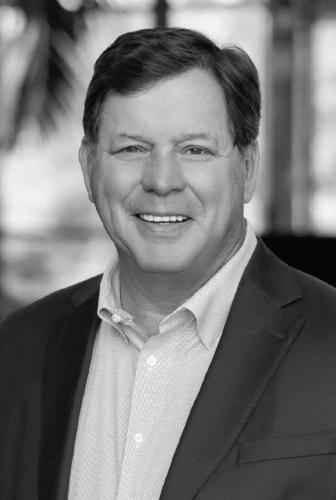








































































































































 Michael Nathanson
The Colony Group
Morris Nutt Trinity Capital Management
Jason Whitby Stone Point Wealth
Nadine Gordon Lee
The Colony Group
Gary K. Liska SEIA
Tim Flatley Sterling Investment Advisors Ltd.
BY EVA CROUSE & RUTHIE KORNBLATT-STIER
Michael Nathanson
The Colony Group
Morris Nutt Trinity Capital Management
Jason Whitby Stone Point Wealth
Nadine Gordon Lee
The Colony Group
Gary K. Liska SEIA
Tim Flatley Sterling Investment Advisors Ltd.
BY EVA CROUSE & RUTHIE KORNBLATT-STIER
24 Groundbreaking Women
From the “Barbie” blockbuster to a record-breaking year at the Grammy’s and the resurgence of hyperfeminine fashion, 2023 has been called “the year of the girl.” Worth’s Groundbreaking Women roster highlights the cross-industry efforts for further progress in 2024. Julie Uhrman of Angel City soccer, basketballer Caitlin Clark and dancer Misty Copeland are advancing inclusion, equal pay, and recognition in sports. Karen Cahn is closing the funding gap for female entrepreneurs, and fashion designer Norma Kamali proves powerhouse status is ageless. On May 9th we will celebrate these and other pioneers at our Groundbreaking Women Summit in New York City.
55 20
WORTH.COM SPRING 2024
Misty Copeland Has a Pointe to Make About Inclusion
The world’s most-famous prima ballerina has used her status to usher in the next generation of dancers of color.
BY EVA CROUSE


The Smithsonian is not only a treasure trove of ancient artifacts but a monument to history that has been made before our eyes. It holds boxing gloves worn by Muhammad Ali, the Nike “Equality” sneakers worn by Lebron James, and Misty Copeland’s ballet shoes—stained and worn, caked in dark makeup.
In 2015, Copeland made history when she became the first Black principal dancer at the American Ballet Theater (ABT) since its founding in 1939, changing the face of ballet. She has since turned her attention to the shoes.
For years, Copeland and other dancers of color have had no choice but to wear ballet slippers in their standard issue shade, “European Pink.” With skin tones so far from the pale, baby-pink hue, these dancers resort to something called pancaking—painting their shoes with makeup to match their complexions.
Classical ballet depends on long, elegant lines, from the top of the head to the tip of the toes. On dark skin, European Pink creates a harsh color-block effect that disrupts the mandated throughline. This aesthetic continuity is so fundamental to ballet that the lack of necessary equipment—and representation—for some is inherently exclusionary.
Copeland went viral this past November when she made a TikTok showing the pancaking process. “[Not having] the option to have pointe shoes or ballet slippers in my color has often made me feel excluded,” Copeland said in the video. “That’s why I’ve started this petition at change.org to give more options for the pointe shoe emoji—more color options—because this is so much bigger than an emoji. This is so much deeper. It’s about making dance and ballet more inclusive.”
Copeland’s petition urges Apple and Unicode, which creates and regulates emojis, to introduce a spectrum of shades for the pointe shoe icon. At the time of writing, the petition had almost 53,000 signatures.
As a bestselling author, founder, producer, actor, and activist, her most recent petition is the latest project in a long line of Copeland’s calls for change.
The 2023 short film “Flower” is the first work by Copeland’s production company, Life in Motion—which she co-founded with her friend from ABT, Leyla Fayyaz. Copeland stars in the silent movie, which serves as an homage to the Black silent films of the 1920s and explores intergenerational relationships and the housing crisis in the San Francisco Bay Area through dance. The work highlights the necessity of finding strength in community in the face of systemic injustice.
GROUNDBREAKING WOMEN
FALL 2023 WORTH COM 56
GETTY
Her memoir, published in 2022 and titled The Wind at My Back, tells the story of Copeland’s quest for community when she was elevated to soloist at ABT. She found it in Raven Wilkinson. Copeland’s treasured mentor, who died in 2018 at her home in New York City, is renowned for the trailblazing achievement of becoming the first Black woman to dance full-time with the Ballet Russe de Monte Carlo in the 1950s and 60s. The memoir tells the story of how these two women found one another and changed the world of ballet by opening doors for dancers of color to follow. When I asked Copeland about her other inspirations, she cited Arthur Mitchell, the founder of Dance Theatre of Harlem and the first Black principal dancer at the New York City Ballet. “Even with creating my foundation, I’m like, oh this is Mr. Mitchell in me, wanting to do this work and give back to the community,” she said.
Founding her non-profit, The Misty Copeland Foundation, in 2021, the prima ballerina developed the “Be Bold” program. Partnered with the Kips Bay Boys & Girls Club and the Madison Square Boys & Girls Club in New York City, the free afterschool initiative aims to make dance affordable, accessible, and fun. They meet twice weekly for 12 weeks across 15 different community sites and have reached approximately 500 children.
Copeland was inducted into the club’s National Hall of Fame in 2012, and her own experience growing up at the San Pedro, CA branch inspired her partnership with the organization. According to her foundation, 25 million children would be enrolled in an afterschool program if it were available to them, and children of color disproportionately represent the unmet demand. “I never otherwise would have had anything to do with ballet, had someone not come into my community and given me an opportunity to see if this was something I could do,” Copeland said. Combating systemic issues through community and dance, Copeland has forged an elegant throughline connecting her non-profit work to her memoir to her film—and it is so much deeper than an emoji.
From starring in the viral Under Armour campaign titled “I Will What I Want,” to performing with late superstar Prince during his “Welcome 2 America” tour, Copeland’s skill launched her into the public eye, making her a household name that extended beyond the world of classical ballet. She has used her status as the world’s most famous prima ballerina to guide the next generation of dancers of color, ensuring they have the type of support that was so crucial to her own success.

Karen Cahn
CEO, IFUNDWOMEN
Karen Cahn is working to make funding more accessible for female entrepreneurs. Her company provides instant access to capital through an online fundraising platform, grant opportunities from corporate partners for small businesses, expert business coaching covering essential entrepreneurial topics, and a supportive network of women business owners. Since its launch, iFundWomen’s membership base has surpassed 420,000 individuals, 81% of whom identify as women of color. According to its data, Entrepreneur Members have raised over $2.5B in capital for their businesses. Cahn asks Worth readers to “go fund something. Funding doesn’t necessarily mean you have to become an investor or write a big check. The best form of funding is revenue, so buy from women-owned businesses.”
Caitlin Clark
ATHLETE
The 22-year-old point guard for the Iowa Hawkeyes women’s basketball team is earning the status of a living legend. This season, the college senior made history when she amassed a set of statistics achieved by only one other basketball player in the last 25 years— Lebron James. Plus, she did it in just 13 games. Clark is the first Division I player to record 3,300+ points, 900+ assists, and 800+ rebounds in a career. Known for her trademark threepointer, often launched just before the buzzer with vicious precision, Clark has turned heads across the industry. She has inked name, image, and likeness deals with various partners, totaling $777,000 at press time, and she is presumed to be the No. 1 draft pick should she decide to go pro.
Capitalizing on these deals, she created The Caitlin Clark Foundation. Partnering with the Girls and Boys Club of Central Iowa it provides food, clothing, and other support to kids across the region.

57 (CAHN) COURTESY OF KAREN CAHN, (CLARK) GETTY
Michelle Christensen
VP OF GLOBAL DESIGN, KARMA AUTOMOTIVE
A lifelong lover of art and automobiles, Michelle Christensen is the auto industry’s first woman to oversee the development of a supercar. In 2017, she directed the remodeling of the Honda Acura NSX, a second-generation hybrid sportscar, which was declared “Performance Car of the Year” by Road & Track Magazine
With a 20-year background at Honda, GM, and Nissan, Christensen’s singular creativity has situated her as a force to be reckoned with across the industry. She became vice president of global design for luxury electric vehicle maker Karma Automotive in 2022. In April 2023, Christensen was named the company’s strategic driver, steering the brand in a new direction. She hopes to help distinguish Karma as one of the U.S.’s top ultra-luxury car brands and inspire other women and girls in the automobile industry to follow suit.

Remy Drabkin
MAYOR, MCMINNVILLE, OR
Mayor, winemaker, inventor, activist. Last November, Drabkin was named Mayor of McMinnville, Oregon, becoming the first woman and queeridentifying person to hold the position. Her political agenda includes advocating for LGBTQ+ rights, addressing homelessness, and combating climate change. She also owns and operates a vineyard called Remy Wines; and in 2020, she founded the nonprofit Wine Country Pride, which brings annual pride celebrations to the rural valley. Endowed with a healthy disregard for convention, Drabkin debuted the world’s first Queer Wine Fest in 2021, highlighting U.S. wineries with queer owners, winemakers, and vineyard managers. The event will be returning in June.
In the summer of 2022, Remy Wines unveiled a new facility built with a carbon-negative concrete formula named the Drabkin-Mead Formulation, which she helped invent. Hers is the first commercial winery to use this concrete mix, whose formulation is now open source.

Tiffany Dufu
PRESIDENT, TORY BURCH FOUNDATION
Tiffany Dufu says she was put on this earth to advance women and girls. As the new president of the Tory Burch Foundation and bestselling author of Drop the Ball: Achieving More by Doing Less, Dufu has bridged the gap between relatability and impact.
In 2018, she founded The Cru, a peercoaching organization acquired by Luminary in 2023. Dufu is also a founding team member of the Lean In initiative and a leadership officer at Levo—a professional network for millennials. Dufu has raised over $25 million for women and girls throughout her career. From 2006 to 2013, as the president of The White House Project, she helped train thousands of women to run for political office.
The Tory Burch Foundation offers women entrepreneurs a platform that supplies education, access to capital, fellowships, networking opportunities, and other resources. In her new role, Dufu will oversee the Fellows Program, which offers $1.85 million in grants to help 280 women advance their businesses, and the foundation’s Capital Program, which is backed by Bank of America and has distributed $100 million in low-interest loans to 5,600 women entrepreneurs. She will also oversee the online education programs offered by the foundation, benefiting more than 650,000 people annually.

(CHRISTENSEN) VIA KARMA, (DRABKIN) COURTESY OF MAYOR REMY DRABKIN, (DUFU) GETTY
GROUNDBREAKING WOMEN
Ava DuVernay
FILM DIRECTOR
Ava DuVernay is the first Black woman to win the Sundance Film Festival’s directing award, to be nominated for a Golden Globe Award for Best Director, to have her film nominated for the Academy Award for Best Picture, and to direct a film with a budget of over $100 million.
With her unusual movie Origin, released this past year, she continues to blaze an uncharted path for women of color in the film industry. After it was announced in 2020 that she would be directing the film for Netflix, the streaming service backed out of the project, and other major film studios passed it over due to its heavy social critique. However, DuVernay knew better than to be discouraged by the lack of traditional financing.
Leveraging her distinct pluck and creativity, she created a new film financing model based on philanthropic donations. With help from the Ford Foundation, Melinda Gates, and the Emerson Collective, to name a few, DuVernay moved forward with Origin, now a critically acclaimed film.
DuVernay’s exceptional success across both her artistic and business accomplishments may be a key factor in pushing for change in an industry that has often proven resistant to social progress.


Rachael Floreani
FOUNDER, BURLINGTON BIO
A remarkable researcher with over twenty years of experience in polymer materials and mechanical engineering, Rachael Floreani has devoted her work to ameliorating the compounding threat of food insecurity, particularly for struggling mothers.
After earning her MS and PhD from Colorado State University and completing postdoctoral work at the University of Washington, she became a professor at the University of Vermont in 2011. Her collaborative research and product development spans fields including tissue engineering, cultivated meat, anti-cancer therapeutics, and FDAapproved drug delivery implants, to name a few.
In 2022, Floreani took an entrepreneurial leap and founded Burlington Bio, a company that translates her research into a material reality for the cultivated meat industry. Integrating farming and cellular engineering, it is the first biomaterials developer to utilize milk-derived proteins as the basis for sustainable, lab-grown, and alternative meats.
Over the past year, Floreani has leveraged both her company and her research to work together with Vermont’s farmers, diverting and repurposing their agricultural waste to generate the engineering building blocks for the growing alternative meats industry. Moreover, she understands the critical importance of including more women in science and serving as a mentor to young women and non-binary students interested in STEM.
59 WORTH.COM SPRING 2024
(DUVERNAY) GETTY, (FLORANI) COURTESY OF RACHEL FLORANI
Fereshteh Forough
FOUNDER, CODE TO INSPIRE
Fereshteh Forough is the founder and CEO of Code to Inspire, the first advanced computer coding school for girls in Afghanistan, which has taught over 550 students. Born a refugee in Iran, Forough moved back to Herat after the fall of the Taliban in 2001, facing a lack of infrastructure, limited water supply, and only a few hours of electricity per day. While studying at the University of Herat, Forough was randomly placed on the new computer science track by the automated course selection system. Refusing to give up the opportunity to go to school, she tackled the subject. Forough obtained her master’s degree in Berlin, became a professor in Herat for three years, and moved to the United States in 2012.
In 2015, she founded Code to Inspire, remotely leading operations and fundraising for an Afghanistanbased school from her Brooklyn apartment. However, she had to halt the in-person gatherings after the Taliban takeover in 2021. The school briefly reopened in 2022, under the condition that boys be admitted, but was closed again in December of that year. Today, students are learning remotely via Google Classroom. While Forough hopes to resume in-person classes soon, her top priority is the safety of her students.


Joanna Geraghty
PRESIDENT & CEO, JETBLUE
In May 2018, Joanna Geraghty became one of the highest-ranking women in the commercial airline industry as JetBlue Airways’ president and COO. In 2024, she shattered the glass ceiling again when she was named the carrier’s next CEO, making her the first woman to lead a major U.S. airline.
A key player in JetBlue’s success since 2005, Geraghty has led a national push to increase the number of women throughout the aviation industry. According to the JetBlue Foundation’s “Fly Like a Girl” initiative, fewer than 7% of airline pilots and 3% of aircraft technicians are female. The initiative aims to make women a key part of aviation’s future, from tarmac to boardroom.
Under Geraghty’s leadership, JetBlue will also be the only major airline to include women in at least half of the company’s top C-suite roles. At a 2018 Fly Like a Girl event, she explained that the key to expanding women’s presence throughout the industry is correlated to early experiences in science, technology, engineering, and math: “It’s about exposure. We know that the more you expose girls and young women to careers in STEM, the more they start thinking that they can do that type of career.”
Victoria James
SOMMELIER & PARTNER, COTE
Victoria James is a superstar in the food and wine industry, an international best-selling author, the country’s youngest certified sommelier, and a Michelin-starred restaurant veteran. Currently the beverage director and a partner at the Michelinstarred food group COTE, she’s also the founder of the COTE Wine Club, for which she received a James Beard nomination.
After working at numerous high-end restaurants in New York City, she began to appear across food and wine publications with features in Zagat’s “30 Under 30” and Wine and Spirits’ “Best New Sommeliers.”
James makes her specialized wine knowledge accessible to a wider population through her writing. Her books, Drink Pink: A Celebration of Rosé and Wine Girl, have made it onto bestseller lists across the globe. She is also the co-founder of Wine Empowered, a nonprofit that offers tuition-free wine and sommelier courses to women, people of color, and underserved populations.


FALL 2023 WORTH COM 60 GROUNDBREAKING WOMEN (FOROUGH) GETTY, (GERAGHTY) GETTY, (JAMES) VIA VICTORIAJAMES.INFO
Jennifer Justice
FOUNDER & CEO, THE JUSTICE DEPT.
Don’t be confused: Jennifer Justice’s The Justice Dept. is largely unrelated to the law. Instead, Justice, known as JJ, uses her extensive experience as an entertainment executive to help artists build their careers and business portfolios. She specializes in the intersection between art and commerce, and her company describes itself as a law firm devoted to advising, consulting, and advocating for women across the entertainment industry.
JJ first found her footing in the industry as an attorney at Carroll, Guido & Groffman LLP, where she was made a partner after only three years at the firm. Her impressive roster of clients included Jay-Z, Mark Ronson, and Outkast. Soon after that, she joined Jay-Z to build his multidisciplinary entertainment company, Roc Nation, where she served as general counsel and executive vice president. She also served as Jay-Z’s entertainment attorney for seventeen years and Beyonce’s personal attorney for a year.
After a brief and successful stint at the company Superfly, JJ set out on her own and founded The Justice Dept. to allow her to invest her skills and resources in promoting gender equality across the entertainment business. She is also a founding advisory board member of USC’s Annenberg Inclusion Initiative and sits on the board of Freeform, an organization devoted to tackling domestic violence.

Azra Kanji
PARTNER, ASTIRA CAPITAL PARTNERS
Azra Kanji is a seasoned private equity veteran with over two decades of experience and appointments to about a dozen corporate boards. But before her most recent endeavor, she wasn’t a major player in the industry. That changed in 2023 when the relatively unknown financier left Arby Partners to start Astira Capital Partners. Just five months after the firm’s launch, Kanji closed her debut fund at an unheard-of $675 million, surpassing their alreadyambitious $500 million target.
The Boston-based private equity firm invests in tech-enabled B2B businesses and has committed to providing $50 million to $200 million per investment.
Beyond the impressive oversubscription on her debut fund, Kanji expresses her excitement about the firm’s nine-member team, highlighting the inclusion of four other women and the diverse backgrounds offered by herself and other members. Kanji has voiced her enthusiasm for the burgeoning private equity trend of investing more in company culture and unique perspectives. It will be fascinating to see what comes next for Kanji and her team.

Norma Kamali FASHION DESIGNER
Renowned for her revolutionary impact on the fashion industry, Norma Kamali is an icon of innovative and timeless design. From Farah Fawcett’s red v-neck swimsuit—worn in the bestselling poster of all time—to the popularization of sweatpants, Kamali’s career began in the 1960s and she has never slowed down. Now 78 years old, the New York Citybased American fashion designer continues to anticipate and fill consumer needs every season, like in her 2024 pre-fall collection of soft jersey knits. She also just released a new skincare line— launched in affiliation with her Wellness Café.
Kamali’s designs are the kind you live in—she believes that beauty isn’t just something to put on, but something to be embodied from the inside out. That is why she started her Wellness Café in 2001, and her commitment to it has never wavered. From exercise inspo to unisex skincare and fragrance to resources on diet and sleep, her contributions to the wellness space are intended to work for everyone, encouraging a holistic and healthy approach to aging.

61 WORTH.COM FALL 2023
WORTH.COM SPRING
(KAMALI) GETTY
GROUNDBREAKING WOMEN
Julie Uhrman
BUILDING A POWERHOUSE WOMEN’S SOCCER TEAM
Julie Uhrman is Angel City Football Club’s (ACFC) president and cofounder. Beginning play in 2022, the LA-based club quickly became the highest-grossing team in the National Women’s Soccer League, with $55 million of long-term partnership revenue contracted in 2023.
Co-founded by Uhrman, Academy Award-winning actor and activist Natalie Portman, and technology venture capitalist Kara Nortman, Angel City is one of the world’s only majority female-founded and run professional sports teams. Drawing from both investing and star power, its minority owners include Christina Aguilera, Serena Williams, Joy Faucet, America Ferrara, and Jennifer Garner, to name a few. And they all came together with a common goal: equity.
Uhrman told Worth, “We built an organization based on a higher purpose. We didn’t just want to be a team in a city or just win championships but set higher expectations. We wanted to have a positive impact within our community, for our community, and for our team.”
Angel City’s powerhouse investors are angling to change a sports industry where women’s teams do not receive the same sponsorship dollars, advertisement dollars, broadcast time, or streaming opportunities as men’s. But ACFC is showing that, with the right support system and investment, it can be just as, if not more, profitable than a men’s team. Its earnings lead is substantial, making up 36.7% of all league revenue, followed by Portland at 13.2%. The club’s ticket sales, exceeding $10 million, also rank number one. Fanbase loyalty is evident in the nearly 16,500 season tickets sold.
Uhrman told Worth, “We are building something sustainable—we do everything we can not to comp tickets and have the lowest comp rate in the entire league.”
Angel City has transformed the traditional sponsorship model by prioritizing social impact, particularly in women’s sports, pay equity, and community aid. The club directs 10% of
its sponsorship revenue back into the LA community. This includes delivering 1,212,406 meals (as of early February) with DoorDash, distributing over 237 tons of fresh produce with partners like Sprouts Farmers Market, joining Gatorade to train 164 female soccer coaches, and coaching over 6,700 youth players. The club has run fellowship programs for 19 students with Birdies, donated 22,000 sports bras with Nike, and organized over 960 community events.
Uhrman has been named to the Sports Business Journal Game Changer class and its Most Influential People in Sports Business list. She is listed as one of SportsPro Media’s Ten Influencers of 2023 and earned a spot on Fast Company’s list of the 100 Most Creative People in Business. In May 2023, ACFC became the first women’s team to achieve the prestigious title of Sports Team of the Year by SBJ


SPRING 2024 WORTH.COM 62 COURTESY OF JULIE UHRMAN

La June Montgomery Tabron
PRESIDENT & CEO, W.K. KELLOGG FOUNDATION
Twenty-six years after joining the W.K. Kellogg Foundation, one of the largest private philanthropic foundations in the United States, La June Montgomery Tabron made history when she was named the organization’s first female and first African-American CEO in 2013. Established in 1930, the Kellogg Foundation works to encourage the education and development of children across the United States and also provides programs and grants in Mexico and Haiti.
Under Montgomery Tabron’s decisive leadership, the foundation has spearheaded numerous initiatives to improve the quality of life for chronically underserved populations and bridge the rifts engendered by racial and socioeconomic inequality. Its $50 million contribution to the Hope Starts Here initiative has allowed the program to provide access to affordable and equitable early childhood experiences for children in Michigan. This past year, in Detroit alone, the foundation’s investments have made possible a new birth center called Birth Detroit as well as a $5 million expansion of the city’s Riverwalk into lower-income neighborhoods. The foundation also provided the funds and resources for the construction of the Detroit Food Commons, a model for communitybased food initiatives that will provide healthy, affordable nutrition to those in need.
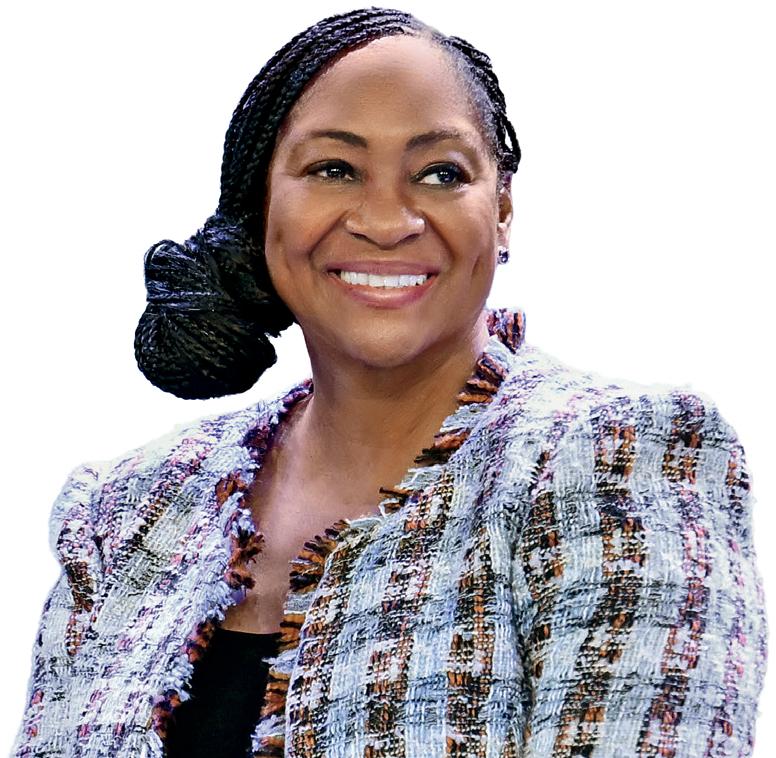
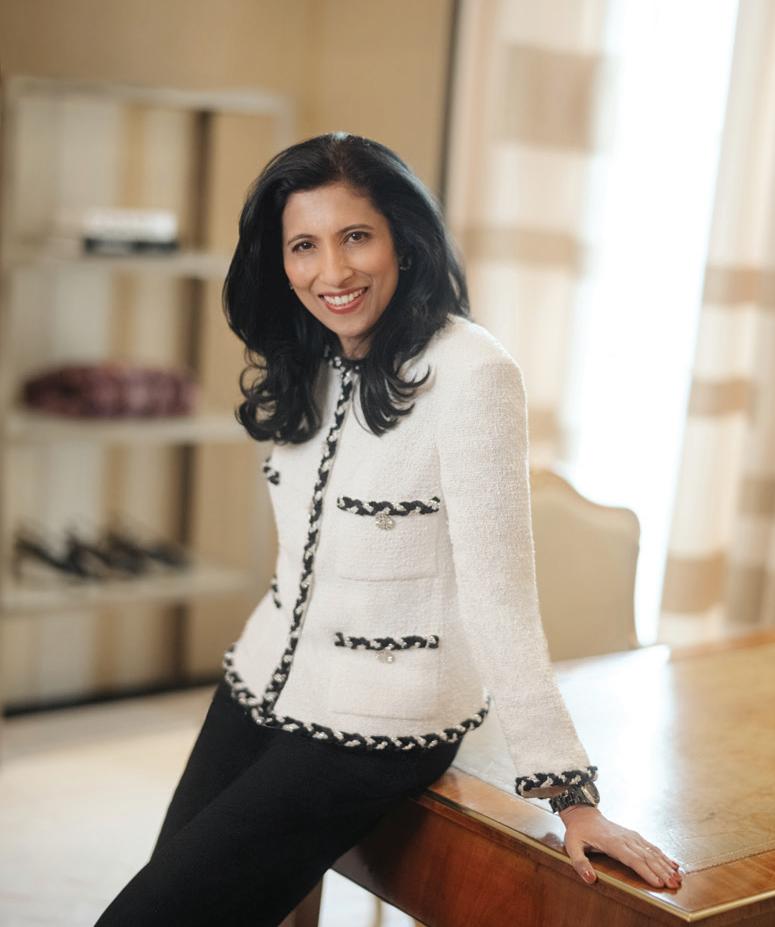
Leena Nair CEO, CHANEL
Assuming her role as CEO of Chanel in 2022, Leena Nair is the first Indian and first nonwhite person and only the second woman—after Coco herself—to head the French luxury brand in its 114-year history. But these triumphs are not the only things that make Nair a unique selection. Before joining Chanel, she had never worked in the fashion or luxury industries.
Nair built a 30-year career at Unilever, where she served as chief human resources officer—responsible for roughly 150,000 people across more than 100 countries. She headed the company’s diversity and inclusion agenda and a groundbreaking, successful initiative to attain a 50/50 gender balance in global leadership. Nair also made aggressive social commitments, such as implementing a living wage throughout the supply chain by 2030 and providing 10 million young people with essential skills by the same year. She started the Career by Choice program for Southeast Asia, supporting women who have stepped away from their careers to rejoin the workforce.
In her first year at Chanel, Nair saw a 17% increase in sales, consistent with other top luxury brands bouncing back from COVID-19. While Nair is undoubtedly an unconventional choice, her track record of generating significant business impact through human-led initiatives could indicate a shift in the brand’s priorities.

Dr. Sharon Malone OB/GYN, ADVOCATE
A nationally renowned medical practitioner, Malone empowers women to proactively manage their health.
An OB/GYN and certified menopause practitioner (and Michelle Obama’s health advisor), Dr. Malone is the chief medical advisor at Alloy Women’s Health—a telehealth company serving women over 40. She is providing millions with information, education, and access to medically approved menopause hormone therapy.
Throughout her impactful career, Dr. Malone has championed reproductive rights, reducing teen pregnancy, and eliminating healthcare disparities. Before joining Alloy, her passion for women’s health led her to become a partner at one of the longest-standing and most successful OB/GYN medical practices in Washington, D.C.—Foxhall OB/GYN. Her new book, Grown Woman Talk: Your Guide to Getting and Staying Healthy, will be available in April.

63 WORTH.COM SPRING 2024
(TABRON) GETTY, (NAIR) COURTESY OF LEENA NAIR, (MALONE) GETTY
Illana Raia
FOUNDER & CEO, ÊTRE
Illana Raia is the founder and CEO of the mentorship platform Être (French for “to be”). It creates face-to-face connections between 15-25-year-old girls and women in leadership, providing a vast and diverse array of resources.
Previously a corporate attorney at Skadden Arps and a guest lecturer at Columbia University, Raia made a significant career pivot when she realized that her young daughter had no idea what she, or any of her friends, did for a living. The fashion designers, CEOs, surgeons, authors, and others that made up Raia’s inner circle were known simply as “your friend from book club,” or something similar. So, Raia set up lunches with her friends and daughter, encouraging her to ask every question she could think of.
Seeing the gap between the next generation of young girls and the incredible progress women have made in the workforce, Raia founded Être.
Raia is the author of two awardwinning books, The Epic Mentor Guide and Être: Girls, Who Do You Want to Be? She tells Worth readers, “Bring girls into your organizations and faceto-face with female leaders. Mentors matter...and the earlier, the better.” She continues, “For smart companies that want to see more women in the boardroom—the time is right to save seats for girls.”

Neha Shukla
AUTHOR AND ACTIVIST

At just 19 years old, Neha Shukla is accumulating titles the way most people collect USB cables. She currently chairs the World Economic Forum’s first entirely youth-led artificial intelligence advisory body, spearheading global discussions and advocating for ethical and child-safe AI policies. Additionally, she is the bestselling author of A Kids Book About AI, which explores the ethical dimensions of AI and its potential for social impact. Having conducted innovation and community impact workshops for 75,000 students across 35 countries, she inspires girls and students of color to channel their creativity for the greater good. Shukla was the youngest United Nations delegate at the UN General Assembly in New York City and was selected by the White House National Space Council as a champion for girls in tech.
Shukla has made a place for herself among changemakers decades her senior by encouraging girls and boys to learn new skills and apply them for the greater good.
Rachel Slaybaugh
ENGINEER AND PARTNER, DCVC

Rachel Slaybaugh is a distinguished nuclear engineer and partner at the deep tech venture capital firm DCVC, where she implements climate-tech investments.
Before joining DCVC in 2022, Slaybaugh was a professor of nuclear engineering at UC Berkeley. Her passion for technology projects with global impact led her to direct the Cyclotron Road Accelerator at Lawrence Berkeley National Laboratory, a program designed to support scientists by advancing their early-stage projects with potential for significant global impact. She also served as a program director at the U.S. Department of Energy’s ARPA-E, where she pioneered the nuclear fission program and facilitated awards for more than 30 companies and teams pushing boundaries in the field.
Slaybaugh is the founder and current board member of a non-profit called Good Energy Collective, a policy research team that is advocating for safe nuclear energy as an essential part of the national climate change agenda.
SPRING 2024 WORTH.COM 64
GROUNDBREAKING WOMEN (RAIA) GETTY, (SHUKLA) COURTESY OF NEHA SHUKLA, (SLAYBAUGH) COURTESY OF RACHEL SLAYBAUGH
Janet Truncale
CEO, EY
In July of 2024, Janet Truncale will make history as the first female CEO of a Big Four consulting firm. With over 30 years of experience at EY, Truncale has risen to head of the financial services business in the Americas— where she leads a team of 14,000—and is slated to take over for current CEO Carmine Di Sibio, who is set to retire in June. While the Big Four—Deloitte, KPMG, PwC, and EY—have previously appointed women to lead some of their biggest member firms, July will mark the first time a woman runs global operations.
The extended working hours and ample travel required in consulting positions do not align well with the responsibilities of a primary caregiver—a role that continues to be largely shouldered by women. These factors, along with the historically gender-exclusive nature of the industry, have contributed to the persistence of a male-dominated space—particularly at the partner and C-suite levels. As such, Truncale’s appointment will be a monumental event for the industry, demonstrating both steps toward gender parity and how far it has yet to go.

Jocelyn Wyatt
FOUNDER & CEO, ALIGHT

For Jocelyn Wyatt, entrepreneurship and saving the world are not mutually exclusive. Over the past two decades, she’s helped to create a more equitable, just, and humane society. A social innovation leader, humanitarian, and entrepreneurial executive, Wyatt has honed a multifaceted skillset that has allowed her to enforce change across the public, private, and nonprofit spheres.
The founder and former CEO of nonprofit design studio IDEO.org, Wyatt, spent a decade leading a global team with offices from San Francisco to Nairobi. She tackled major social issues, such as women’s financial literacy, criminal justice reform, refugee aid, and health equity. In 2021, Alight (formerly known as the American Refugee Committee), an organization that provides critical care to four million people across the globe annually, named Wyatt their new CEO.
In 2023, Alight provided life-saving medicines, gender-based violence prevention, clean water, sanitation, and hygiene education to millions of needy people. “With 82 million refugees and displaced people worldwide, the opportunity to co-create new solutions with communities is more critical today than ever before,” stated Wyatt upon becoming Alight’s CEO. “Alight strives to rethink the status quo and help transform the narrative of the world’s displaced by including diverse and varied voices within the organization.”
Michelle Zatlyn
COFOUNDER & COO, CLOUDFLARE
After receiving her bachelor’s degree in chemistry from McGill University and an MBA from the Harvard Business School, Michelle Zatlyn didn’t have any inkling that one day she would co-found one of the most prominent cybersecurity companies in the world, Cloudflare.
Though she had experience interning at both Toshiba and Google, the Saskatchewan, Canada native had no experience in cybersecurity when she embarked on her Cloudflare venture with her HBS classmates, Matthew Prince and Lee Holloway, in 2009. In an unusual turn of events due to the 2008 recession leaving her unemployed, Zatlyn was in the perfect position to help develop the new company.
“It was a fun social thing,” she explained to The Globe and Mail “When we came up with Cloudflare, I knew nothing about internet security, but I care a lot about liking what I’m doing. I knew if I could help create internet security, that’s something I could work hard for and be proud [of].”
Over a decade later, the company has over 12 million domains, 165 data centers and more than 800 employees. Its 2022 revenue reached almost $1 billion. In 2017, Forbes included Zatlyn on its list of “40 Under 40,” and in 2021, she was also included in the publication’s list of “50 Self-made Women.”


65
(ZATLYN) GETTY

Wealthy Heirs Rethink What Giving Back Means
Some Millennials and Gen Zers are looking more towards remaking business and society than writing checks to museums and alma maters.
BY SEÁN CAPTAIN
The multi-millionaires and billionaires of the past donated fortunes to the arts, education, conservation, and other charitable causes. But they often amassed those fortunes on the backs of the environment, workers, or communities. The gifts may have been an effort to make up for the downsides of their business models in place of reforming those models.
That’s changing, to some extent, among the younger generations of high net worth ($1-5 million in liquid assets) through ultra-high net worth ($30 million or more)—especially those who are inheriting their fortunes. Surveys, anecdotes, and hard data show that at least some (though it’s hard to say how many) are looking to erase the line between commerce and the common good. They are trying to clean up the family business or invest in sustainable new ventures rather than just cutting checks to charity. And when they donate money, it’s often to different causes, with different timetables and expectations.
GIVING BACK
SPRING 2024 WORTH.COM 66 GETTY
“They tend to have a different perspective on the purpose of the wealth. They tend to want to be more involved in awareness of social, environmental, and political issues that advocate causes like climate change, social justice, and mental health,” says Nikè Anani. The daughter of a wealthy Nigerian entrepreneur (whom she declined to identify) works with her Millennial inheritor peers as director of next-gen advisory at Northern Trust. “They want to bring onboard more technology, or infuse more sustainability measures into the family business, or take the philanthropy or investing in a different direction,” she says of the “next-gen” and “third-gen”, AKA the children and grandchildren of fortunebuilding entrepreneurs.
If widespread, this trend could substantially remake business and philanthropy. The world is in the midst of a massive generational wealth transfer, with Baby Boomers poised to shift up to $53 trillion to their heirs through 2045 (according to research by Cerulli). At the pinnacle of affluence, UBS estimates that 1,000 billionaires will pass $5.2 trillion to their children in the coming 20 to 30 years. (In 2023, for the first time, more new-billionaire wealth came from inheritance than from self-made fortunes, according to the UBS/PwC Billionaires database.)
“I am in touch with a younger generation of people who are inheriting wealth, who definitely have different priorities there,” says Chuck Collins, a Boomer who directs the Program on Inequality and the Common Good at the Institute for Policy Studies. A nonprofit advocacy salary wasn’t the expected path for Collins. In 1986, this heir to the Oscar Meyer fortune donated to charity his entire trust fund of $500,000—about $1.4M in today’s money. He describes the journey in his 2016 book Born on Third Base Collins’s give-it-all-away is an extreme case. The notion that they will still be well off, no matter what, may be giving young inheritors more courage to take a different path. They have the “psychological and the physical or financial wherewithal to take risks,” says sociology professor Paul Schervish. The founder and director of Boston College’s Center on Wealth and Philanthropy has been researching the values and motivations of affluent people around giving since the 1980s.
“My daughters are fine,” says Jen Risher, author of We Need to Talk: A Memoir About Wealth
“Because of the way their trusts were set up when we first came into money, they don’t have to worry.” She and her husband, Lyft CEO David Risher, struck it rich in the dotcom boom at Microsoft and Amazon.
Risher, who’s 58, says that her 24-year-old daughter is especially focused on putting resources towards climate and the environment, while the 26-year-old is concerned about “racial justice.”
The parents are leading a movement encouraging the wealthy to give away money quicker, with fewer strings attached. “I think there’s definitely a trend for people kind of saying, ‘I don’t think I want this money,’” she says, although concedes it’s “probably pretty niche.”
REMAKING BUSINESS
Shy of giving away the family fortune, some contingent is exploring new ways to direct that money. “Millennials are definitely changing the companies’ practices around labor and compensation and ecological principles,” says Collins, although the dynamics of privately held firms are murky. “We just know that there’s generational negotiating going on within those companies,” he says.
Sometimes, fulfilling their values means striking out independently (though perhaps with family backing). Anani sees a rising trend with “more of them asking, ‘How can I do this and contribute to the family’s legacy while also building out my own career or building out a wider business and building out my activities?’”
There are few “pure philanthropists” writes UBS, based on a survey of 79 clients in its 2023 Billionaire Ambitions Report. But it identifies a widespread “sustainable innovation” trend—putting sustainability at the center of business decisions. The report mentions two German brothers investing in projects such as recycling and green hydrogen production. However, UBS doesn’t name names. (I asked both UBS and Northern Trust if any of their clients would consent to an interview, even anonymously. There were no takers.)
Whether called climate, sustainability, or environment, concern for the planet is likely the biggest focus for heirs looking to make positive changes. It was the one clear signal in the billionaires survey, says Judy Spalthoff, head of the UBS Family Office Solutions Group (which focuses on ultra-high net worth clients). “Creating companies that have a sustainable edge, investing in companies that have a sustainability focus, things like that— we’re seeing that more and more,” she says.
Collins also sees value in keeping or even putting money into companies that may not be so socially or ecologically forward thinking—to exert pressure from within, such as through shareholder resolutions. Tech billionaire Mike Cannon-Brookes (born just two years too early to be a Millennial) has dropped $460 million for a 10% share in AGL, the largest electricity generator and CO2 emitter in his native Australia. That’s allowed him to thwart some of the company’s plans and install four new board members.
67 WORTH.COM SPRING 2024
“I think the main argument tends to be in a lot of brown sectors, there needs to be more investment to fund the transition from brown to green,” says Dean Frankle of Boston Consulting Group. He serves as lead for asset and wealth management in the UK, Europe, the Middle East, South America, and Africa.
DOING GOOD, AND WELL
There’s a spectrum of ways that young people are rechanneling their wealth, falling under broad umbrella terms such as social or impact investing. These may include bonds and low-interest loans to companies or projects promising positive social results. “Social and development impact bonds are becoming increasingly mainstream,” says Spalthoff. “They were really, really, really niche for a long time.”
“We think of it as investments that are intentionally focused on generating positive and measurable social and environmental impacts, alongside financial returns,” says Tim Freundlich, founder of nonprofit investment firm ImpactAssets. The organization reports over 2,000 clients (many high net worth Millennial and Gen Z heirs) and over $3 billion in assets under management. The Global Impact Investing Network (GIIN) tallied up 308 impact investors internationally, totaling 371 billion AUM, in its 2023 allocations report.
Not all investing that promises social good requires special effort, especially in the environmental realm. For instance, UBS’s Billionaire Ambitions Report shows plenty of new money going into the green-energy transition—a process already goosed by tax incentives and other funding, including hundreds of billions in the U.S. by the 2022 Inflation Reduction Act.
“An investment about achieving renewable technology is a great investment, as an asset class,” says Frankle. “You’d be missing out if you weren’t seeking to address or seeking to invest in these particular areas.”
In Bank of America Private Bank’s 2022 Study of Wealthy Americans, 73% of millennials surveyed reported owning some assets that are considered “sustainable investments”—vs. 21% of older participants.
But impact investing often focuses on causes that are neglected or need an extra nudge, providing what the industry calls catalytic capital. “It’s applied to filling gaps in environmental and social problems in the world,” says Freundlich, “and designing solutions to fill them…that can be a very good riskadjusted-return investment.”
He names affordable housing. The Federal Community Reinvestment Act requires U.S. financial
institutions to support affordable housing in disadvantaged communities (if banks want to maintain good ratings). But projects need to get to a certain stage before the CRA kicks in, says Freundlich. So impact investors have created revolving funds to cover the earlier stages. “That’s something where it really wasn’t that high risk,” he says. “These were really well-tenured, successful community development corporations that had done whole portfolios of projects.”
Some experts, such as Anani, do see young heirs’ interests ranging beyond the environment. “I’ve seen climate, I’ve seen education, I’ve seen health, I’ve seen gender. It’s really across the board,” she says.
DOES IT PAY OFF?
Frankle sees interest from younger people around cause-based investing, especially on energy and resources—to a point. “I think you will find clients that are very passionate about all these factors,” he says. “But the moment you show them the investment returns, they say, ‘Well, I care about it, but I don’t care about it that much to lose money on it.’” I press him on the notion of losing money. Does it mean negative returns, or just lower returns than with other investments? “I think it’s both,” he says.
According to the 2023 GIIN report, 74% of impact investors are targeting market-rate returns (others are willing to settle for less, or just keep up with inflation). Seventy-nine percent reported either outperforming or performing in line with their financial expectations; and 88% said they met their “impact” expectations. “Almost 90%, nine out of 10 impact investors, [feel they] are having their impact intentions met,” says Freundlich. “Which is really important because that’s the whole point, right?”
While it may not be for everyone, the broad movement to social/ sustainable/impact investing is creating a demand for financial advice—one that’s not being met. “Their financial advisors aren’t providing it. Their wealth advisors are kind of like, ‘Talk to the hand,’” says Freundlich.
“I think the major impediment is often upskilling the relationship managers to be able to feel confident enough to have a conversation on it,” says Frankle. “Because it can become quite technical. And often it’s…outside of their skill set.” Some firms are trying to build this expertise in-house, he says, while others are tapping outside specialists.
RETHINKING PHILANTHROPY
The move to investing in, rather than simply giving to, social good is already nipping at traditional philanthropy. But the ultra-rich are still donating, just in different ways. “The rising generation is not just interested in local impacts, but also these global causes,” says Anani. Risher says that, while their parents gave to hospitals, the arts, or their university, young heirs are thinking harder about what matters to them personally, and these are often more global than local causes.
This fits into a more hands-on approach overall. “They don’t just want to write a check. They want to use the human skills of human capital, social capital. They want to be involved in debate,” says
GIVING BACK
SPRING 2024 WORTH.COM 68
Coming Inheritances by Generation
Source: Cerulli Associates
Anani. “They want to evaluate the impact and the results that they’re giving on an ongoing basis.”
There’s an interesting dichotomy here. Growing up in a tech-rich, data-driven world, some young donors are focused on systemic change and verifiable results, but they may also trust the nitty gritty to the recipients. “They do not want to micromanage those donations as much. There’s a humbleness and a realization that those closest to the causes are able to solve the problems the best,” says Northern Trust’s chief fiduciary officer, Pam Lucina. However, “they still want the data and the accountability, that those are making an impact. And if they don’t make an impact, they’ll be the first to move those donations elsewhere.”
Though she’s not a Millennial, MacKenzie Scott keeps coming up in these conversations. The 53-yearold novelist and early Amazon employee exited her marriage to Jeff Bezos in 2019 with over $38 billion in Amazon stock. Since then, she’s given away over $16 billion. (Although with the appreciation of her assets, she still has over $34B.)
“What a leader in the space,” says Risher. “I love the speed with which she’s given, the amount which she’s given…very community-centered, where the people on the front line know best how to put money to use.”
Another dichotomy, or tension, shows up in the mechanisms for giving away money. Lucina says she’s seeing a trend away from traditional foundations toward donor-advised funds. These charitable investment funds are administered under a nonprofit, but with the donor retaining some influence. A DAF could better embody the active-participant ethos of younger donors. (ImpactAssets’ clients invest through DAFs.)
But DAFs have developed a bad reputation. “The IRS is aware of a number of organizations that ap-
peared to have abused the basic concepts underlying donoradvised funds,” reads the Service’s information page on DAFs. Among the abuses, it lists “questionable charitable deductions,” “impermissible economic benefits to donors and their families,” and improper “management fees for promoters.”
They’re also just slow to part with money, says Risher. U.S. tax law requires foundations to give away 5% of their net asset value annually; DAF’s have no distribution requirements. “The idea of them is great in the way to streamline and make it easy to give,” she says. “However, there’s no impact requirements. It’s a big problem.” To mobilize donations during the pandemic, she and her husband launched the #HalfMyDAF initiative on May 1, 2020. It provided matching funds to DAFs that gave away half of their assets by September of that year and has had the same terms and timeframes in subsequent years. The project has shaken $50 million loose so far.
HOW BIG IS THIS MOVEMENT?
People across the financial spectrum—from those boosting billionaires to those trying to knock them down—agree that something is afoot among the affluent younger generations. But they don’t agree on the scale of this movement, or how to define it.
“I’d say a good 40% fall into that category,” says Anani of her change-minded clients. Lucina, her Northern Trust colleague, pegs it as larger. “I would say about 75% of our next-gen clients think this is very important,” she says.
Chuck Collins has a more circumscribed view, noting that many young affluents are lobbying to abolish the estate tax or using charities in an unethical way to avoid other taxes. “It might be just a five or 10% segment,” he says, “that’s not just cheering and popping the champagne cork but thinking critically, reflecting on legacy differently.” But he concedes that his assessment, like all the ones I encountered, is anecdotal. The ultra-wealthy are often ultra-private (Collins cites the UBS Billionaires report, despite it being a small and extra-elite survey, as still one of the most-insightful sources.)
What’s more, people define social consciousness in their own way, from radical to incremental. Activists like Collins and Risher may set the bar higher for transforming wealth distribution and abolishing dynasties. Wealth advisors are looking to positive reforms within the overall economic and financial order.
And some portion is likely just focused on enjoying their riches. “You can chart this with the growth of private jets, the European villas, the cars, the horses, the ranches, the multiple homes,” says Paul Schervish of Boston College.
“They are more able to be striking out on their own and more visibly as consumers, jet setters, philanthropists, environmentalists,” he says. “So, whatever their direction of choice, they have been granted greater capacity, both psychological wherewithal and financial wherewithal, both the ability to dream big and…the confidence to achieve it.”
69 WORTH.COM SPRING 2024
$32 $24 $16 $8 $0
Gen Z and younger (<26)
Millennial (26-41)
Baby Boomers (58-76)
Gen X (42-57)
($, trillion)
Techonomy 23: The Promise and Peril of AI
NOVEMBER 12-14 | LAKE NONA, FL




The 2023 iteration of our flagship retreat Techonomy 23: The Promise and Peril of AI made its Lake Nona, Florida debut last month. The event successfully convened an assembly of visionaries and leaders across business, tech, academia, and government for a deep exploration into the risks and rewards inherent in the AI revolution.
In critical conversations that spanned diverse sectors, from healthcare and agriculture to government, climate, transportation, and finance, speakers offered insights into how AI is poised to revolutionize every industry. The discussions initiated during those three days will continue to reverberate through industries and communities, influencing how we responsibly harness the power of AI.
As a cutting-edge hub with groundbreaking tech integration, Lake Nona served as a particularly fitting backdrop for this event. Attendees also enjoyed the numerous activity options throughout the retreat.
WORTHEVENT
RECAP
EVENT
1 3 2 4
1. Dan Neely, Kerry Washington and Jim McCann. 2. Andrew Yang discussing “AI is Coming for More Jobs” 3. Glen Phillips of Toad the Wet Sprocket playing at Boxi Park 4. Attendees at the USTA for a tennis seminar and pickleball tournament. 5. X. Eyeé, Nicholas Dirks and Dan Costa at the opening town hall of Techonomy 23. 6. Colin Parris, Gil Perez, Ken Washington, Rebecca Yeung, Charisse Dean, Josh Kampel at the Innovators Breakfast. 7. Techonom 23 attendees in Lake Nona, FL. 8. Innovative Client Development Success using AI and New Technologies Breakfast. 9. Tony O’Driscoll during Q&A session. 10. Colin Parris and Dan Costa at Techonomy 23.
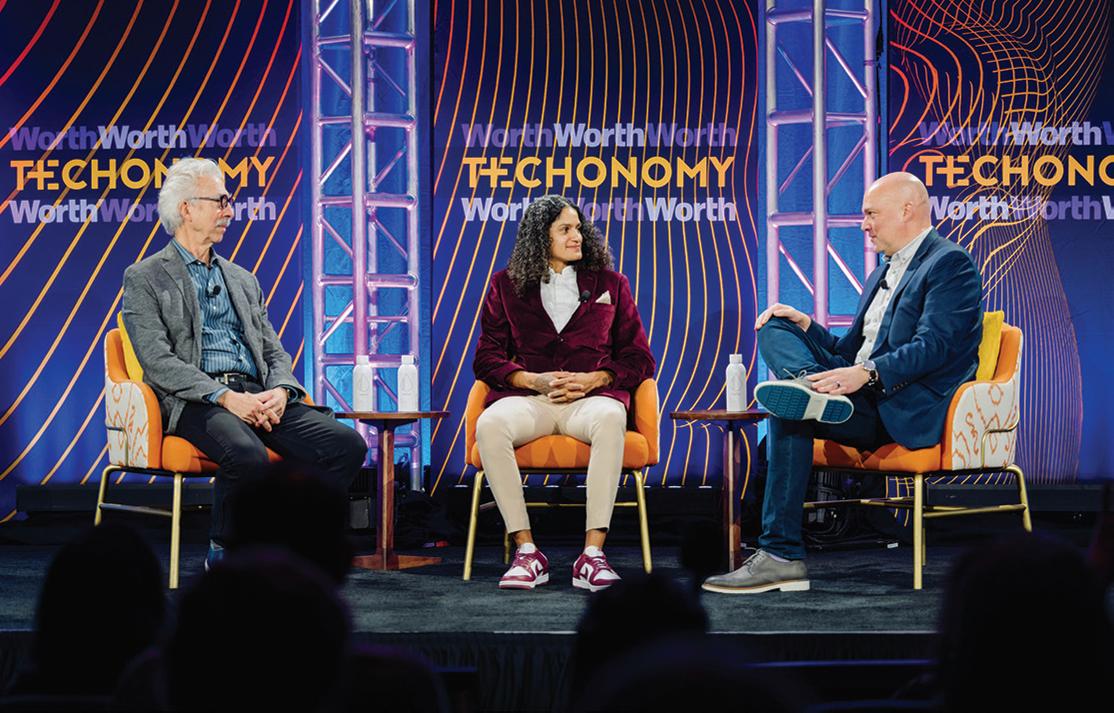

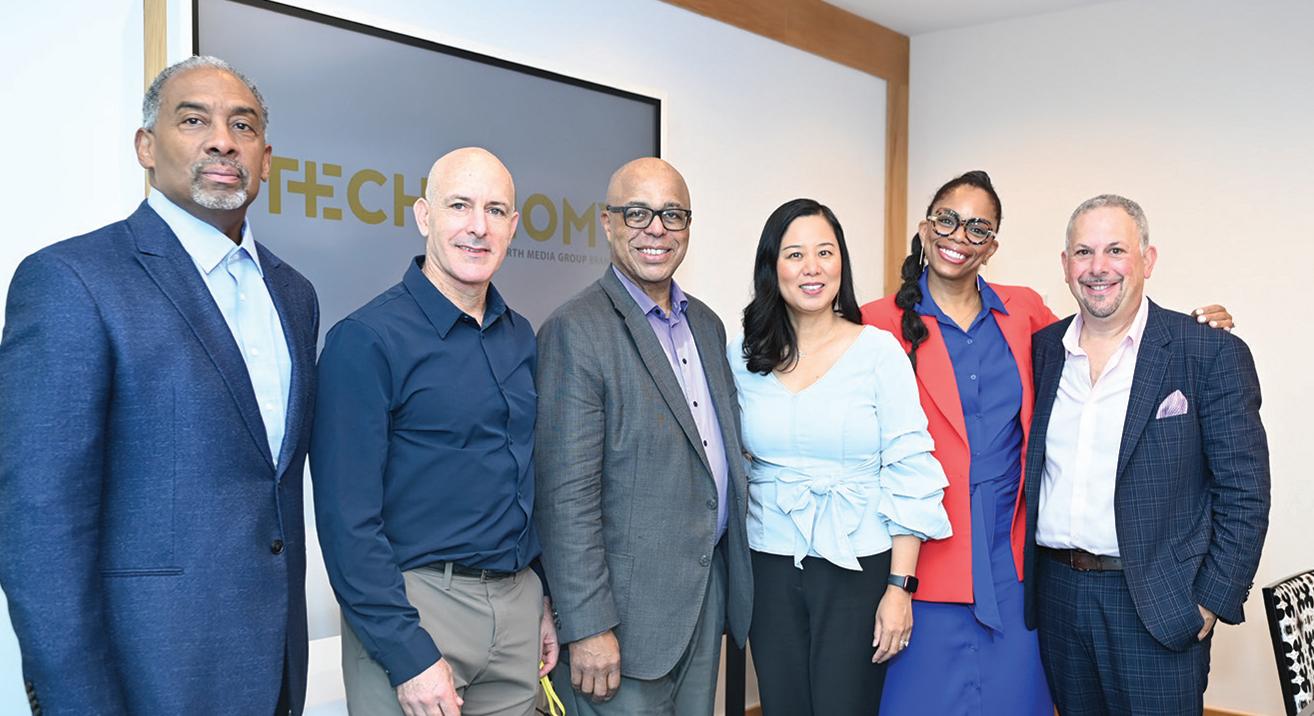

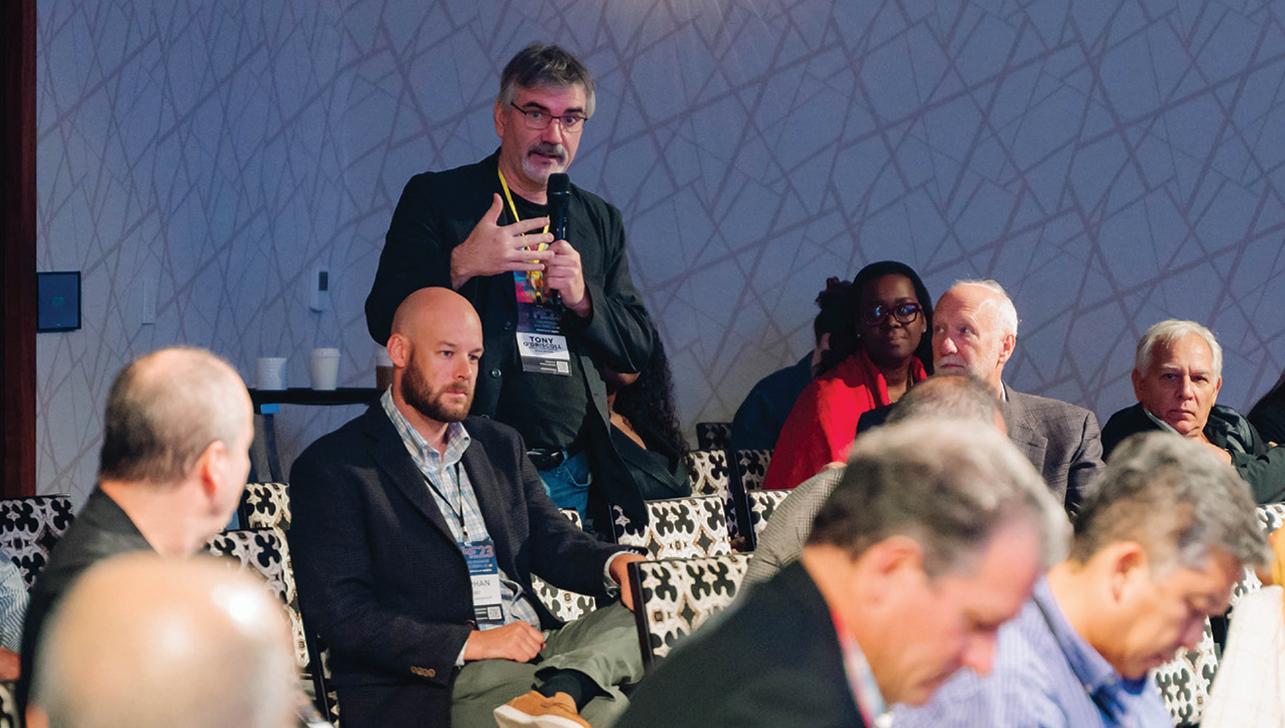

Through panel discussions, keynote presentations, and networking opportunities, attendees gained insights into solutions that scale and engaged in constructive dialogues on actionable strategies.
NOTABLE SPEAKERS AND TOPICS
• X. Eyeé, CEO, Malo Santo
• Ken Washington, SVP, and Chief Technology and Innovation Officer, Medtronic
• Kerry Washington, Actor, Producer, Author, and Activist, KW Inc. + Simpson Street Productions
• Andrew Yang, Founder, Forward Party
• Rebecca Yeung, Corporate VP, Operations Science and Advanced Technology, FedEx
• Colin Parris, CTO GE
• Gil Perez, CIO, Deutsche Bank
• Arati Prabhakar, Director, White House Office of Science and Technology Policy
• Nicole Valentine, FinTech Director, Milken Institute
Learn more at Worth.com/TechonomyRetreat
• Mind, Machine, and Meaning: The Confluence of AI and Humanity
• Decoding AI in Healthcare: What People Really Think
• The Future of Democracy: AI, Politics, & Policy
• How Simulated Worlds Deliver Real Results
• Financial Insights: AI’s Influence on Banking and Beyond
• Learning from the Past, Scaling for the Future
• AI for Social Good: A Strategic Blueprint for Progress
• The Robotic Revolution: Unlocking AI’s Physical Potential
• The Art and Alchemy of AI in Learning
5 7 9 6 8 10
WORTH EVENT
EVENT RECAP
Art Basel Miami: Worthy 100

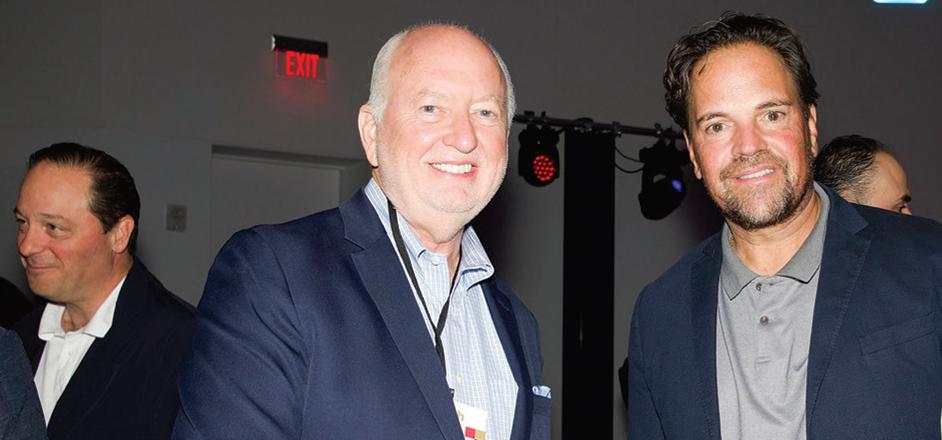
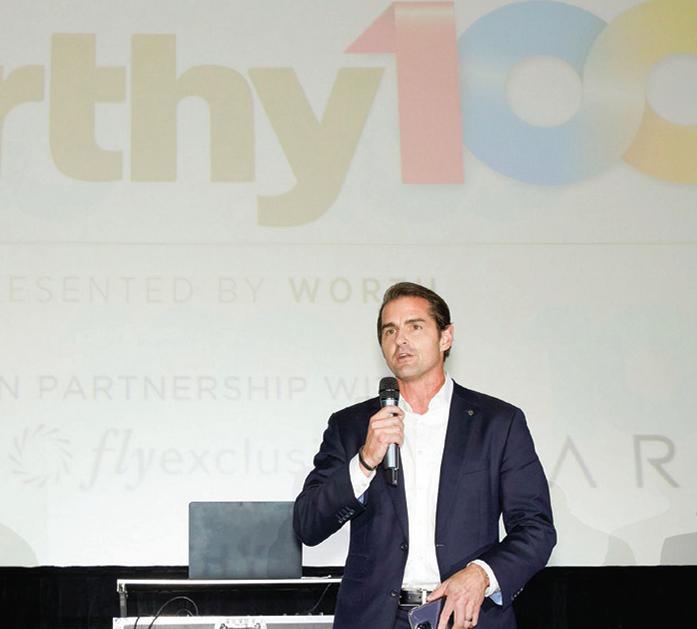



During Art Basel in Miami, Florida, over 400 guests attended Worth’s annual invitation-only celebration, the Worthy 100, held at the Faena Forum. The event recognized individuals featured on the annual Worthy 100 list. These individuals are celebrated for their belief that they have a responsibility to improve the world. Sponsors included: Bermuda, flyExclusive and Karma.
1. Worthy 100 honorees Brandon “Stix” Salaam-Bailey and Nalleli Cobo. 2. Tommy Sowers, president of flyExclusive.
5, 2023
3. Jim McCann and Mike Piazza during Worthy 100. 4. The Attendees of the Worthy 100. 5. Karma Automotive showcased its latest electric luxury model. 6. Installation from flyExclusive with Worthy 100 attendees.
DECEMBER
12 3 56 4
FORECAST

Amidst frustration, there’s also hope. High interest rates are unlikely to fall much— because they’ve curbed inflation, not the economy (74). And today’s financial regime has made bonds worthwhile for the first time in decades (92). Refugees are costing New York City a lot, but may ultimately boost its economy (82). Work-from-home has decimated some metropolises, but not smaller cities (86). Despite the downfall of poster boy Sam Bankman-Fried, the effective altruism philanthropic movement could still succeed (89). And while the Olympics are often a money pit, France just might avoid that fate (78).
GETTY
73 WORTH.COM SPRING 2024
The U.S. Economy Is Too Strong for Rate Cuts
The Fed usually begins a rate-cutting cycle after recessions, not when growth is strong.
BY LARRY KANTOR & BOB DIAMOND
We’ve experienced wild swings in the economy, inflation, financial markets, and fiscal and monetary policy since Covid struck nearly four years ago. With the virus largely behind us, the market focus now is on how the economy and inflation evolve and what the Federal Reserve does in response. Economic forecasters and the Fed expect continued low inflation and a weak U.S. economy. Meanwhile, markets are pricing 125-175 basis points in Fed rate cuts by the end of this year, with 50-75 basis points by July.
This combination of low inflation, deep interest rate cuts, and a barely growing economy doesn’t hang together. There are compelling reasons to believe that the resilience of the U.S. economy is being underestimated, just as it was last year. If the economy continues to grow strongly, the Fed will proceed much more cautiously than markets expect. If the Fed cuts rates significantly in the first half of this year, the economy would accelerate, which would reverse the trend of declining inflation and prompt the Fed to resume rate hikes. That is a situation the Fed would like to avoid at all costs.
Forecasters, markets, and the Fed have been underestimating the strength of the U.S. economy since rate hikes began in early 2022. A year ago, an overwhelming consensus was that the country was heading into a recession. Instead, it accelerated as 2023 unfolded, even though the Fed subsequently raised rates by another full percentage point. U.S. GDP growth increased from less than 1% in 2022 to over 3% in 2023, including a quickening to more than 4% in the year’s second half.
The Fed usually begins a ratecutting cycle after the economy has been beaten up by a recession, not after it has accelerated. So why is that now the overwhelming expectation? The main reason is that core inflation (excluding the volatile food and energy categories) has fallen to the Fed’s target of 2% over the past 7 months, despite the pickup in economic activity, suggesting it is no longer necessary to maintain a restrictive monetary policy. After all, the surge in inflation was why the Fed hiked interest rates in the first place.
The other explanation is the widespread view that the U.S. economy will be very weak this year. The Wall Street Journal’s survey of 71 economists produced an average GDP growth forecast for 2024 of only 1%, while the Bloomberg survey projected 0.9%. The median forecast of Fed officials is only slightly stronger, at 1.5%. Rate cuts make sense if the U.S. economy barely grows and inflation remains low.
These weak projections for growth reflect the belief that the economy can’t keep growing strongly, due to restrictive mon-
etary policy. After all, the U.S. always fell into recession when the Fed hiked rates by as much as it has—over 5 full percentage points in 16 months. Most forecasters and analysts initially pushed out their recession projections in the first half of 2023 as the economic data kept beating expectations. But when the economy accelerated in the second half, they threw in the towel and reverted to a so-called “soft landing,” which entailed an extended period of minimal economic growth.
There are several reasons why the U.S. economy will continue to hold up much better than expected, at least for the next 5-6 months. Higher interest rates have indeed tightened bank lending standards and slowed lending. But overall financial conditions have eased in response to lowerthan-expected inflation and indications from the Fed that it intends to cut rates this year. Stock prices are up nearly 20% since late October, and bond yields have declined by a full percentage point, with mortgage rates dropping by even more.
Moreover, while monetary policy remains tight, fiscal policy has again become expansionary. After falling sharply when the Covid stimulus programs expired, the federal budget deficit for the fourth quarter of last year increased by $90 billion from the previous year, despite a strong, one-off increase in tax receipts; Federal government spending was up nearly 12%.
Consumer spending—which accounts for two-thirds of the U.S. economy—shows no signs of slowing down. Stronger-than-expected December retail sales figures have already pared back market expectations of a Fed rate cut as soon as March. Looking forward, the labor market can be expected to keep creating jobs at an impressive pace. Surprisingly, job gains have accelerated over the past
ECONOMY
SPRING 2024 WORTH.COM 74
Interest Rates: 1955-2023
few months after slowing in the middle of last year. They averaged 289,000 per month over the past three months (as of press time), up from an average of 255,000 for 2023. Meanwhile, unemployment remains below 4%, equivalent to full employment.
Job gains should persist, since there are still an unusually large number of job openings. There were 9 million in December, below the record 12 million in March 2022, but well above the 6.1 million unemployed people, and the pre-Covid level of 7 million. Meanwhile, wage growth is now exceeding the rate of inflation. Strong job growth and increases in inflation-adjusted
“Core inflation has fallen to the Fed’s target of 2% over the past 7 months, despite the pickup in economic activity, suggesting it is no longer necessary to maintain restrictive monetary policy. Inflation was why the Fed hiked rates in the first place.”
worker compensation will continue to boost household income. In addition, consumer balance sheets remain in very good shape. Debt service payments as a percent of disposable income are below preCovid levels and well under levels seen at business cycle peaks. At the same time, the recent rise in stock prices has helped raise household wealth to record levels.
Consumption is just one sector of the economy that is performing well. Investment and construction spending have been quite strong, helped by the $2 trillion that the Administration is beginning to pump into U.S. factories and infrastructure. Investment spending
0% 5% 10% 15% 20% 2020 2015 2010 2005 2000 1995 1990 1985 1980 1975 1970 1965 1960 1955 Federal Funds Effective Rate Recessions
Source: U.S. Federal Reserve
75 WORTH.COM SPRING 2024

rose sharply last year, powered by nonresidential construction, both private and public, which increased by 18% and 16%, respectively. Homebuilding also grew, but by a much more modest 4%.
Manufacturing and housing were clobbered in 2022 as the Fed raised interest rates aggressively, but these sectors show little sign of weakening further. On the contrary, there are signs they have already bottomed. Housing has been picking up in response to the recent decline in mortgage rates and a dearth of existing homes listed for sale. New home sales jumped 8% in December, and single-family housing starts (new residential construction) have been rising at a double-digit pace for the past few months.
Turning to inflation, there has been ample cause for optimism. Core inflation as measured by the personal consumption expenditure (PCE) deflator—the Fed’s preferred measure—has been running just under the Fed’s 2% target over the past 7 months, after peaking at a rate over 5.5%
in early 2022. The reduction in inflation mostly reflects an outright decline in goods prices following a Covid-induced surge. The demand for goods—where the jump in inflation was concentrated—fell sharply once people began to reengage in previously off-limits services such as travel and going out to restaurants and entertainment venues. This occurred just as the return to normal eliminated global supply bottlenecks. The weakness in the Chinese economy over the past couple of years has also helped keep commodity prices low, as has the surge in U.S. oil and natural gas production.
While the decline in inflation has been impressive—especially considering accompanying improvement in U.S. economic growth—it is far too early to conclude that core inflation will remain around 2%. The decline in goods prices, largely responsible for reducing core inflation, has probably run its course. Meanwhile, core inflation in services, which has a greater weight than goods in inflation indices, has been
running at a pace of over 3.5%.
In sum, the economy should keep growing solidly over the next six months, and the Fed will probably hold rates steady, with a possibility of a quarter-point reduction in the summer. This contrasts with current market pricing, which suggests 50-75 basis points in rate cuts by July. Suppose the Fed is as cautious as we expect and maintains rates at current levels. In that case, the economy is likely to slow by the second half of this year since, by then, the labor market should be generating much fewer jobs, implying slower income growth. That said, market pricing of 125-175 basis points of rate cuts by year-end is excessive.
As for financial markets, both stock and bond prices have been boosted by prospects for lower interest rates. In particular, the recent plunge in bond yields was largely in response to expectations that the Fed would begin to cut rates significantly and soon. If we are right that economic growth exceeds forecasts and expectations for rate cuts are not realized, bond yields should increase over the next few months.
Stocks have also responded well to the prospect of big rate cuts, but the upside surprise in economic growth has also contributed as corporate profits have rebounded. If the economy continues to outperform, stocks should hold up despite the persistence of high short-term interest rates. It is worth noting that, although stock prices have recently reached record highs, they are barely above where they were two years ago, despite a much stronger-than-expected economy. Moreover, U.S. markets remain attractive internationally since the U.S. is massively outperforming virtually every other major economy. This suggests the U.S. stock market is not positioned for a sharp pullback anytime soon, barring some unexpected negative event.
ECONOMY
SPRING 2024 WORTH.COM 76 GETTY
Do You Want to Pay Less Tax?
BY ERIK R. FLEGAL, MANAGING PARTNER
It’s unlikely anyone would answer “No” to the question above. Attend an upscale event and it’s likely that half of the attendees, at some point, are talking about taxes. More specifically, how can they pay lesstax.
If you’ve read this far, you have the same desire, don’t you?
Let’s set the table – there are generally three places you can give your money - family, charity, or the IRS. The goal of tax planning should be to make sure you give most of it to the first two. The added headwind is that taxes are likely going up. In 2026, all the tax tiers will revert to the higher 2017 numbers unless the government can agree to extend the lower levels. An American with an annual income of $500,000 or more is staring down the barrel of 1–5% additional annual tax.
And where most solutions revolve around a product, not everyone is a nail to the product hammer. We offer a new collaborative process that emphasizes tax planning and mitigation, and our firm can do just that. There are a few ways to think about reducing tax:
n Defer the tax. This references things like Opportunity Zone investments or investing in 401(k) plans. There are other examples, but the main thrust is $1 today is worth more than $1 tomorrow. Deferral is a powerful tool to “kick the tax can” down the road.
n Eliminate the tax. The basic version of this is harvesting losses in your stock portfolios. The losses offset the gains. More sophisticated versions create offsets to active or passive income, but the goal is the same – generate a way to offset income or gains into the portfolio.
In some instances people try to spend their way out of paying taxes. They purchase cars, real estate, new investments or equipment. But this points back to the product-based approach. So then, how can we create something truly bespoke?
n First, the client must be curious.
n Second, they need to be collaborative.
n Third, they need to be open to a little complexity.
If clients are willing to spend a little time understanding a strategy, the numbers alone can compel action. If people don’t have those three basic attributes, they would not be a good fit for this process.
Our clients are hungry to get an edge and open to learning. Understandably, a successful founder who grew a business with a long-time team of advisors might be reluctant to create tension or rivalries by adding a new player.
But our process avoids that possibility. Here’s how:
n Most importantly, our approach and process are conflict free. Reason being, a client’s current advisors all take care of different aspects of a client’s finances, but none of them are saying, “Our sole focus is tax mitigation.”
n Because our focus is on tax planning and tax mitigation, we are additive to the other disciplines on the team.
n The savings we intend to generate produce additional assets to manage, curate and grow for the other professionals on the team.
n This noninvasive dynamic creates what might be called “an advisory tax alliance.”
n The goal is that everybody wins, not just the client, but all advisors involved in the client’s wealth management and estate planning.
In upcoming articles, we will go into more detail about our collaborative, noninvasive process. But if, with this piece, we have piqued your interest and you want to learn more now, you can engage knowing our client assurance:
We work hard to inform and let the numbers articulate the value.
ABOUT THE ADVISOR ERIK R. FLEGAL
fortunetaxalliance.com

Erik Flegal is the founder and CEO of Fortune Tax Alliance LLC, a subsidiary of Family Fortune Financial LLC. With a team of experienced professionals, Fortune Tax Alliance helps clients create “Tax Alpha” by deploying strategies that mitigate ongoing tax drag. The firm has a curated rolodex of collaborative accountants, attorneys, financial advisors and business consultants who help you work towards financial stability, while avoiding overpaying on taxes, hidden fees and commissions.
Erik had prior roles at Morgan Stanley and Wells Fargo Private Bank. His passion for developing collaborative systems and environments spurred him to create an independent company. An active member of the community, Erik is on the leadership council of the National Small Business Association, the nation’s oldest small business advocacy organization. Erik resides in Mount Pleasant, SC with his wife and four children.
Disclaimer The
FAMILY FORTUNE FINANCIAL
contents are intended for general informational purposes only and it should not be used as a substitute for consultation with professional accounting, tax, legal and other advisors. Fortune Tax Alliance does not provide advice on tax, legal or mortgage issues. These matters should be discussed with the appropriate professional. Please consult your attorneys, accountants, or tax advisors with respect to questions relating to the deductibility of various types of contributions for federal and state tax purposes. In order to comply with U.S. Treasury Regulations governing tax practice (known as “Circular 230”), you are hereby advised that any tax advice provided herein was not intended or written to be used, and cannot be used, by any taxpayer for the purpose of (i) avoiding U.S. federal, state or local tax penalties, or (ii) promoting, marketing, or recommending to another party any transaction or matter addressed.
PARTNER CONTENT 77 WORTH.COM SPRING 2024
How Fair Are the Olympics’ Economic Impacts?
The Olympics can be an economically crippling decision—or not—if you play your cards right. France is sure it has some up its sleeve for Paris 2024.
BY CHIDINMA IWU
Sports economists in the U.S. like Andrew Zimbalist and Victor Mathewson argue that hosting the Olympics is a poor economic decision, causing irreversible financial strain to a country under the illusion of enriching it with monumental global value. They cite examples like Athens 2004, with a $15 billion hemorrhaged investment which brought in $168 billion in debts (an EU rescue package it is still paying) and derelict facilities. Rio De Janeiro in 2016 spent over $13 billion of taxpayers’ money and was left with piling debts of about $113 million, thousands of displaced citizens, and rising protests across the country. Adding these examples to many others in earlier years, critics assert that hosting the Olympics is simply bad business.

Other economists say that the Olympics can lead to some long-term benefits if planning is done well.
“Some cities do [the Olympics] very well,” Dean Baim, professor of economics and finance at Pepperdine University, tells Worth. “If there’s a solid plan, it’d be a success. Los Angeles did it in 1984,” he says. “I would argue that Seoul and Atlanta did it too. Every facility that was built, they had a plan for it after the Olympics.”
FRANCE’S BIG BET
This preparedness that Baim thinks imperative and critical is what France boasts of against summer 2024—the centenary of the celebrated Paris 1924 games—when the eyes of the world will turn to it. The country believes it can change the opinions of Olympic naysayers with critical strategies that target gaining local public support and upholding sustainable practices.
It is also banking on its modest $4.4 billion budget (which may change), a gender-parity pledge in athlete and event selection, and the fact that a majority of Olympic facilities (like the 1924 Chariots of Fire stadium) are already in place for the Julyto-August games. Like most host countries who have tried to use the Olympics to sponsor an economic boom, France projects that it will make a profit—$5-10 billion from the games alone.
Still, critics like Johan Rewilak, assistant professor of sports economics and finance at the University of South Carolina, assert that hosting will be unnecessary to France’s economic growth. It’s not a sustainable financial decision, he says, as the games are inherently destructive— echoing Andrew Zimbalist’s view.
Rewilak thinks that an alreadythriving tourist destination like France does not need the Olympics to place itself on the global map. “Hosting the games may not generate the economic impact that has been previously mentioned, as Parisians may substitute spending from other areas of the local economy for sport,” says Rewilak.
OLYMPICS SPRING 2024 WORTH.COM 78 GETTY
He also thinks tourists will be forced to stay away from Paris for a long time for fear of being crowded or overpriced on normally affordable goods, especially as inflation is also rising (as of early 2024). “There is a sports management conference in Paris coinciding with the Olympics,” he says, “and I am choosing to stay away given how busy Paris will be!”
Accurately forecasting the economic impact of the games has remained a challenging task, but it is important to understand where the argument between optimists and skeptics is rooted and how the intricate history of the games’ economic circumstances profoundly influences present-day Olympics and ideologies about it.
There was a time when the games were simple to host, when financial losses didn’t deplete national economies, and when failed Olympics didn’t have any colossal impact on a country’s image. In the time after, though, the Olympics became so costly that financial losses had a
grave national impact. What’s more, debates over the games’ economic fairness started strong arguments that could be perceived as a reflection of one’s morality.
“In the early days of the modern games, not much was spent in preparation and on facilities,” says Rod Skyles, an economist and seasoned business professional. “The Berlin games in 1936 changed that trend.”
THE ECONOMIC BOON OF THE EARLY MODERN GAMES
Pierre De Coubertin served as president of the International Olympics Committee (IOC) for the first 28 years after the games’ rebirth in 1896. In that time, Olympic disasters never resulted in any major financial losses for hosting countries. The Olympics weathered setbacks like canceled games in 1916 and World War I, and experienced gradual international recognition until Paris 1924—which changed things.
These Olympics didn’t run on any obscure political or economic windfall motivations but on the French’s
desire to show their sportsmanship to the world, as well as redeem themselves from the poor work they did in Paris 1900, when they hosted the games for the first time.
It was the Olympics of many firsts, recording the largest attendance yet, being broadcast over radio, and preceding the golden era of France’s booming economy. It was also the last one for Pierre De Coubertin.
Much of Paris 1924’s success was defined by how many attendees, countries, and international delegates were present to witness and participate in it—remarkably larger than any games before. The games were especially a signifier that France’s suffering economy, fresh out of World War I, was getting back on its feet.
France did not recover the money spent on hosting and infrastructure through ticketing. But the games had converted spectators to tourists, including frequent American visitors, and eventual permanent residents who were gob smacked by the low cost of living in France. And this boosted trade. Paris had put on a
Total cost overruns/underruns of the Organizing Committee of the Olympic Games Revenue Expenditure 120% 100% 80% 60% 40% 20% 0% -20% Sydney 2000 Athens 2004 Turin 2006 Beijing 2008 London 2012 Sochi 2014 *Rio 2016 Pyongchang 2018 Vancouver 2010 Salt Lake City 2002
Revenue) Overruns
79 WORTH.COM SPRING 2024
A History of Budget (and
Source: Johannes Gutenberg-University Mainz. *No data available
good, convincing-enough show, and this naturally yielded monetary benefits. Soon after, in 1926, the country entered its Franc Poincare (named after its finance minister) zenithal era, as rates of exchange lowered, and the economy prospered.
This was a massive shift—one many bidding countries looked forward to achieving and even beating— and one that may have influenced the use of the Olympics for political propaganda years later.
The next host, Amsterdam, which had initially bid for 1924, experienced a better economic impact than Paris. It had spent $1.183 million and recovered $1.165 (about $38 million and $86 million, in today’s dollars), with a negligible loss of $18,000 ($585,000). It was also the first to introduce brandsponsored marketing through CocaCola, providing American teams 1000 crates of their drink.
The Los Angeles Olympic games of 1932 were better still—superb even—and are referenced in the list of historically successful Olympiads. It’s a usual example of why some economists posit that the Olympics could
be a significant financial decision. ILA powered through the limitations of the Great Depression in America with sufficient architectural, monetary, and innovative strategies. Planners considered the futuristic use of Olympic infrastructure, the safety of local communities, and the economic recession of that time—and finished with a $1 million ($32 million today) profit. It was the first Olympics not to lose money.
After the Olympics in Los Angeles, it had been established that the games were potentially a great tool in reaching peaceful international relations, especially after global conflict, scoring trade boosts, and championing a colossal increase in tourism. But the path the Olympics took after Los Angeles, politically and economically, was a sharp left.
HITLER’S BUDGET-BUSTING EXTRAVAGANZA
Adolf Hitler was fascinated with the widespread popularity of the recent games. He saw the Olympics as a vehicle to demonstrate his racial superiority ideologies, highlight the power of Nazi Germany, and exert a propaganda
The Growth of the Modern Olympics
coup. “1936 Berlin was driven by Hitler’s desire to show off Nazi Germany and announce to the world how special they were,” Skyles tells Worth. “Since then, many of the games have been driven by politics and not common sense or for the benefit of the people.”
Berlin 1936 cost more than $500 million in today’s dollars and was 10 times more expensive than any preceding games, putting Germany in more debt than all previous host countries combined. It was meant to be outrageously extravagant like nothing ever seen before and signal the return of Germany to the global stage after its defeat in World War I. Hitler’s unsuccessful plan plunged Germany into an economic crisis, but he had carved a new path for the Olympics.
The cost of the Olympics in the interwar era had grown naturally, but not exorbitantly, as attendance increased, participating countries multiplied, and brand awareness through the games improved. But what Hitler did in 1936 changed the economy of things forever. It created a new hope:
OLYMPICS
Number of participating countries in the Olympic Games 0 50 100 150 200 ’16 ’12 ’08 ’04 ’00 ’96 ’92 ’88 ’84 ’80 ’76 ’72 ’68 ’64 ’60 ’56 ’52 ’48 ’36 ’32 ’28 ’24 ’20 ’12 ’08 ’04 ’00 1896
Source: IOC SPRING 2024 WORTH.COM 80
the possibility of a global legacy. The recent Olympics era strayed far from De Coubertin’s original ideas. It gave the Olympics a fresh motto and told developing countries that the games could be their ticket to gaining global recognition. At the same time, it made industrialized countries more energized than ever.
“Each city [after Berlin] had a specific reason why it wanted to host the Olympics, and in most cases, it was to make their country appear to be a global leader. To some extent, they were successful,” Baim tells Worth.
THE MODERN SPENDING SPREE
There was a 12-year break due to the Second World War after Berlin in 1936. The cost of the Olympics reverted to tens of millions of dollars for a time, a typical rate for hosting it in the interwar period. But costs soon rose with economic growth.
The Olympics after the ‘60s signified the world’s recovery from the war. It was now visible that a state could assert itself through the games. Bidding became tougher as countries scurried for the chance to show how much development they had made through the world’s center stage, the idea of exerting themselves as global leaders, and the potential economic gains (which they believed would overshadow the projected costs incurred by host cities).
Mexico, the first developing country to host the Olympics, was able to assert itself as a contemporary, cosmopolitan country through the flamboyant sports and housing architecture it built (and that remains useful). But this meant using large amounts of public funding and even massacring student protesters who sought to use the games’ global popularity to demand democracy and the elimination of authoritarianism.
The city of Rome could flaunt its high-end urban reimagination as it was the first city to get television coverage, but it left a pile of debt ($19 billion today) in its wake.
Tokyo, in 1964, went as far as spending over $10 billion in national
makeovers—from stadiums to transportation infrastructure—which led to a large-scale displacement of citizens and substantial debts. Montreal in 1976 shackled the city with $1.5 billion in debt. “They ran such a huge deficit that the people of Montreal had to pay for it,” says Baim.
WHAT TO EXPECT FOR PARIS 2024
There are decades of overwhelming evidence that hosting the Olympics is a costly investment, in which returns are vaguely probable, but governments remain ever hopeful.
This is hardly surprising as the payoff—when it pays—is also easy to see. The 1988 Seoul Olympics, for example, reimagined the war-linked image of South Korea and brought in investments. Barcelona became a Mediterranean gem after 1992 through modern renovations that showcased its culture and increased annual tourist visitors from 1.8m in 1990 to over 3 million in 2000. London, today, still generates money from its Olympics 12 years ago through several tournaments hosted in the Olympic stadium it built in 2012.
Many hosts have fruitlessly spent much money trying to recreate these successes, and France may be on track to do the same. It is faced with spiraling cost concerns, which made several cities like Boston withdraw their bids. This explains why bidding in general has dropped. There are also problems of rising inflation and existing security challenges, which were a big factor in Japan’s enormous financial losses after Tokyo 2021. Citizens will also leave the city during the games because they think it will be unbearable—hampering shopping, transportation, and basic day-to-day activities.
France could have chosen not to bid for hosting, and nothing would have changed. As Rewilak insists, countries like it don’t need to assert themselves as global leaders, nor do they need the Olympics to boost their economy. “The Olympics is not necessary to place Paris on the map. People go to Paris no matter what,” he says.
The country’s intent for hosting the Olympics remains somewhat vague, especially with a lot of downsides threatening its success. However, France’s evacuation of homeless people out of Paris ahead of the Olympics is an angle to consider for Baim, as he thinks it is a move to hide the city’s problems from citizens and visitors.
“The Olympics are sometimes bread and circuses to keep people’s minds off of a country’s problems,” he says. “Paris may be motivated to host the Olympics to keep Parisians and the press distracted from its number of unhoused. I think it’s the most efficient way to distract people.” Rewilak adds, “If the movement and transfer of homeless people stops—or there is movement back to Paris—after the games, it may tell the full story.”
In 2020, the IOC, an institution with a history of bribery and corruption and involvement in hospitality and doping scandals, put out a strategic roadmap agenda. The agenda seeks to reform the Olympics and the IOC. And Paris, as a host choice, may be part of it. “This isn’t a sullied country using the Olympics to improve its image. This is a sullied Olympics using a country to decontaminate itself,” Jon Werthiem, Sports Illustrated executive editor writes.
There are a few economic upsides to cling to in France’s story, though. Firstly, its eco-smart and sustainability plans to make the games pro-bike, pro-pedestrian, anti-jet, and anti-car are forward-thinking and will save costs. Secondly, Paris may be able to replicate the efficiencies of London 2012 and L.A 1984, since—like those former hosts—it doesn’t need to construct any new buildings, just rehab old ones.
France has had the ball in its court since 2017, and in a few months, it’ll play before global spectatorship. If the country has learned from mistakes of past hosts and has properly executed its pre-game strategies, it’ll be evident in the aftermath of the tournament. If not, the results would hardly be surprising.
81 WORTH.COM SPRING 2024
The True Cost and Benefit of New York’s Migrant Crisis
Billions have been allocated to tackle the immigrant influx. Is it a drag on the city or an opportunity for economic renewal?
BY CHRISTOPHER ALLBRITTON
Dayana and her family crouched in the 5 a.m. darkness, the desert air hot around her even at this early hour. When they moved, they did so quickly, tugging their children as fast as they could, darting between trees and scrub. When you reach the barrier, the human smugglers said, stay put and wait to be picked up by border patrol.
“We waited there,” says Dayana—who requested to be referred to by her first name only. “At about 6 o’clock in the morning, I think, the immigration cars arrived, and they picked us up.”
A few days earlier, she and her husband fled her native Bogotá, Colombia. His work as a community activist had attracted the attention of criminal gangs who threatened their lives. So, they flew to Mexico City as soon as they could and took a bus to Mexicali, where they met the smugglers.
They left so quickly that they couldn’t even say goodbye to their extended families, she says, her eyes brimming with tears.
“Here in the United States, we have no family,” she says. “We are the four of us against the world, so to speak. So, I was very afraid to come here with nothing.”
At the immigration detention center, she says a worker from SAMU First Response, a humanitarian organization that helps
migrants with immediate needs when they arrive, told her they should go to New York City.
COST BUT POSSIBLE BENEFITS 0F MIGRANTS
Dayana, who spoke with me in Spanish from New York City via Zoom through a translator, is one of the 170,700 migrants and asylum seekers who, as of January, have arrived in New York over the past two years, testing the patience and straining the resources of the city most associated with immigrants. Mayor Eric Adams, who has managed to anger almost everyone over his handling of this crisis, says the city has spent $2.4 billion since July 2022 and that if the current influx of migrants continues, they will cost a total of $10 billion by the summer of 2025, which he says will “destroy” New York City. He has pleaded for more financial help from Albany and Washington, to little avail.
But while the initial cost is
giving city and state leaders a bad case of sticker shock, immigration advocates say the money should be seen as an investment.
“Immigration historically—in fact, I would say always—has been seen as a net benefit of the country,” says Muzaffar Chishti, senior fellow at the Migration Policy Institute, a nonpartisan think tank that studies U.S. immigration policy. “And that’s because they bring all the gains ... They contribute to the labor [market], and they contribute to the tax base even when they’re working illegally because employers still deduct [taxes] from their paycheck. And they are eligible for no benefits. So, there’s a net gain, fiscally speaking.”
This time, it was different. Thanks to a legal right to shelter in New York City and a delay in work permits for asylum seekers like Dayana, the city and the state have been forced to shoulder the expensive burden of housing and feeding the tens of thousands of migrants who have come through the city’s systems since Spring 2022. (A 1981 consent decree mandates the city offer a bed and basic services to any homeless person who asks for them.) It’s been all cost and less gain.
But data show that once migrants and asylum seekers are settled into their new lives, they quickly begin earning wages, paying taxes, starting businesses, and reinvigorating neighborhoods. It’s just a matter of how long before these benefits manifest.
Adams’s office declined requests to comment on this story and referred me to transcripts of his media appearances and press conferences.
A GLOBAL MIGRATION MOVEMENT
The wave of migrants arriving in New York City is part of a global phenomenon. Some 110 million people around the world have fled their homes as of mid-2023, and a third—36.4 million—are refugees,
MIGRANTS
SPRING 2024 WORTH.COM 82
according to the American Immigration Council. This non-profit advocates for greater protections for immigrants. There are legal distinctions between migrants, asylum seekers, and refugees because responsibility for the different groups lies with various state and federal agencies.
Refugees flee their countries because of fear of persecution or human rights violations. Under the UN’s 1951 Refugee Convention, they have a right to international protection, and the responsibility for admitting and resettling refugees lies mainly with national governments. They also have the right to work, education, and access to public services.
Asylum seekers like Dayana have fled their countries for fear of persecution but have yet to be granted refugee status by the country where they’ve applied. Most of the migrants coming to New York City are asylum seekers rather than refugees. While adjudicating the asylum claims falls under the federal government’s authority, housing and feeding asylum seekers usually falls on the states and cities hosting them.
While all refugees and asylum seekers are migrants, not all migrants fall into those categories. Some have left their homes seeking better work or educational opportunities, or they might be fleeing gang violence, poverty, climate change, or political unrest.
In April 2022, Texas Governor Greg Abbott sent a bus of Cubans, Venezuelans, Nicaraguans, and Colombians to Washington, D.C.— critics say as a political statement. Some continued to New York City, attracted by its reputation as a sanctuary city and unique legal obligation to shelter homeless families.
EXTRA-HIGH COSTS
New York City initially planned to spend about $12.3 billion on migrants from 2022 to 2025, with
NYC Migrant Costs Grow Fourfold in Three Years
New York City asylum seeker expenditure by agency Health and Hospitals Homeless Services Housing Other
migrant care costs, which were unplanned, making up 2.5% to 4.3% of the city’s spending in fiscal year 2023.
“That, I think, made it real,” says Chishti. “That this is not going to be sort of a nice Statue of Liberty handshake in welcoming immigrants. This has a real physical cost.”
Adams later reduced spending estimates to $10 billion in the 2024 budget, citing higher tax revenues and better fiscal management. But that left some city councilmembers and immigration advocates puzzled over what exactly, had changed.
Down at the human level, the
“Once migrants settle in, they begin earning wages, paying taxes, starting businesses, and reinvigorating neighborhoods. It’s just a matter of how long before benefits manifest.”
city is spending $396 a day on each migrant coming through the shelter system, according to the City Comptroller’s office. These costs include shelter, health care, Medicaid enrollment, vaccinations, school enrollment, legal orientation, and more, although a detailed breakdown of costs was not available to the comptroller as of December 2023. There are indirect costs, too, with a general strain on public services, the costs associated with integrating the new arrivals into the labor market, and the impact on communities.
Driving up the cost, the city has relied on expensive emergency contracts totaling about $5.7 billion to open more than 210 shelter sites, including 18 humanitarian relief centers, sparking accusations of waste and fraud against the Adams administration.
Take hotels. Bloomberg reported in June last year that Adams’ office agreed to pay hotels a premium—sometimes 73 percent more than a typical nightly rate— and guarantee full occupancy. The Holiday Inn in the Financial
$0 $1 $2 $3 $4 $5 $6 billion
Final FY 2023 November Plan FY 2024 November Plan FY 2025
83 WORTH.COM SPRING 2024
Source: NYC Mayor’s Office of Management and Budget
MIGRANTS
District charged $190 a night over its typical rate of $110.
Win NYC, the city’s largest provider of family shelter and supportive housing, reported in August 2023 that the city could save more than $3 billion a year by providing housing vouchers to migrants, regardless of immigration status.
“The City is wasting resources by failing to invest in cost-effective solutions that would help people move out of shelters and into the community,” says Joshua Goldfein, an attorney at the Legal Aid Society, the largest nonprofit legal aid provider in New York City. “They are driven by a budgetary imperative that is penny wise and pound foolish.”
NO HELP FROM WASHINGTON Worsening the situation is that most asylum seekers cannot legally work until about six months after applying for asylum. This further strains the city’s budget; if migrants aren’t working, they’re not supporting themselves, paying rent, buying groceries, or paying taxes. Both Adams and New York Gov. Kathy Hochul have pleaded with the Biden administration to speed up work permits for migrants, but that requires Congress to act, which it has so far declined to do.
All of which leaves New York City in a bind. Republicans in Congress have used the border issue against President Joe Biden, who, in turn, is pressured by progressive Democrats who reject any new border security measures as inhumane and Trumpian. So there’s not much the city can do to stop migrants from coming and seeking services.
“New York can’t do anything about this. Immigration is a federal policy, and if no one came through Texas, then they’d just be heading for Arizona, which they’re already doing now anyway.” So says Mark Krikorian, executive
director of the Center for Immigration Studies, which bills itself as an “independent, non-partisan, non-profit, research organization” focused on immigration.
“The migrant crisis was sparked by President Biden’s rhetoric on the campaign trail and then his actions in office,” he says. “He rolled back almost every one of President Trump’s immigration policies. … New York was bound to face this once the White House decided to dial back on enforcement of the immigration laws.”
Immigration advocates say Adams has been making the situation worse with his doomsday rhetoric. While everyone involved in the debate agrees the federal government could shoulder more of the burden on the city and state, advocates say that migrants are not to blame for New York’s budget woes.
“It gave them a scapegoat for all these other budgetary issues that were coming up at the end of the pandemic aid,” says Camille Mackler, the founder and executive director of Immigrant ARC, a coalition of more than 80 legal services providers in the city. “So, he just made all these massive cuts to schools. … [New Yorkers are] seeing it through the eyes of their kids, right? Like, all of a sudden, programs they count on are gone. And he’s blaming the migrants for it.”
Adams has since rolled back some proposed cuts.
THE POSITIVE ECONOMIC ARGUMENT Mackler points out that the money spent so far and the billions more budgeted are down payments for the wealth migrants eventually generate once they get settled and start their lives.
“It is an investment upfront to help integrate these individuals, but it is an economic investment that will pay off,” she says. “Every statistic out there bears that out.
If you look at how immigration
and refugee resettlement have revitalized upstate New York, if you look at the percentage of immigrants who are new business owners or entrepreneurs, homeowners, I mean, if you look at it over time, if you invest in the issue now, it’s something that pays off.”
“I think,” she continues, referring to Adams’ complaints about costs, “from an economic standpoint, it’s been very short-sighted.”
Brad Lander, the New York City Comptroller and a progressive thorn in Adams’s side, apparently agrees and, on Jan. 4 issued a fact sheet extolling the benefits of immigration to New York.
According to the sheet, immigrants add to the economy by boosting spending and paying taxes: New York State collected $3 billion from undocumented immigrants alone in 2021. And they fill valuable jobs. Seventy percent of undocumented immigrants in New York City work in jobs considered essential.
At the state level, 32.4% of entrepreneurs are immigrants, reports the American Immigration Council, generating $7 billion in business income. Immigrant households in New York paid $61 billion in local, state, and federal taxes in 2021, with an aggregate income of $199 billion.
Nationally, migrants, asylum seekers, and refugees paid $524.7 billion in total taxes in 2021, the Council reported, and had $1.4 trillion in spending power. The undocumented contingent paid $31.1 billion in taxes and had $228 billion in spending power.
“There are challenges to be sure, but political leaders can have a little confidence that in the long run, this is what makes New York the city it is and America the country we are,” says David Dyssegaard Kallick, director of the Immigration Research Initiative, a think tank that studies immigrant integration. “Our economy and culture are richer and stronger for
SPRING 2024 WORTH.COM 84
the immigration we’ve had over the decades, and it will continue to be richer and stronger with newly arriving immigrants today.”
BUILDING A NEW LIFE
Dayana now lives in a hotel in the Bronx with her family. Her son is learning cello in school, and she is effusive in praising the teachers and the principal there. “They have been very supportive. They have given me a lot of help with my children, with everything, she says. “The school’s principal is a person with a very big heart, really, an excellent person.”
Her husband works in construction now, and she is learning English, hopeful to put her old skills as a nurse to use somewhere, somehow.
Dayana is learning the city, the subway, her favorite bodega, just like every new New Yorker does. She keeps her head down, tries to go unnoticed. Sometimes, she gets hassled by people offended by her presence.
“They make comments like, ‘Oh, but why did you come from your country? Why didn’t you stay there? What are you doing here?
Are they taking [something] away because of you? Are they taking X, Y things away from us?” She cries a little as she tells me this, the cold whipping away the tears.
But she had good news, too. On Jan. 2, she and her family received asylum, she says, 18 months after arriving in New York. She and her husband are now eligible for work permits, Social Security cards, and other federal assistance. She is still anxious.
“I am really struggling here. I fight every day for my children because I want them to be calm and happy, not to live in fear,” she says. “I know that my son, he has understood everything, and he realizes everything… [Since] his fourth birthday, he hasn’t had peace of mind and tranquility. So, as a mother, I want to give him that peace of mind.”
Migrant Economic Contributions: New York State
Entrepreneurship
289,506m
$7 billion
Share of entrepreneurs who are immigrants Total
32.4%
840,742m
American Immigration Council 85 WORTH.COM SPRING 2024
Source:
Immigrant entrepreneurs
business income of immigrant entrepreneurs
Taxes and spending power
billion Total immigrant household income Total spending power Federal taxes paid State and local taxes paid $36.6 billion $24.4 billion $138 billion Housing
$199
Immigrant homeowners $558.5 billion Housing wealth held by immigrant households $20.7 billion Amount paid by immigrant-led households in rent
of recent homebuyers who were foreign born 23.2%
Share
Why Returnto-Work Is Bigger in Smaller Cities
Multiple factors can make getting back in the office an easier sell outside of the largest urban areas.
BY ROB PEGORARO
The pandemic washed over American cities with frightening speed in early 2020, but it hasn’t receded at anything close to a uniform pace. And neither has the economic side effect of remote work—leaving business districts feeling, at best, a little lonely, at worst, zombified.
Several studies published last year have revealed one particular difference that should be grounds for measured optimism. Figures for office occupancy and downtown recovery tend to look a lot better in smaller cities than in the biggest markets—a fact often lost in the media. For instance, building-security firm Kastle’s heavily reported count of badge swipes covers only the top 10 metros, and shows only slow back-to-work progress.
BIG CONTRASTS BETWEEN CITIES
A fuller picture comes from a trio of academic researchers who analyzed smartphonelocation data that businessintelligence firm SafeGraph had collected through mid 2022. Their “Remote Work and City Structure” study, published in July of 2023 by the National Bureau of Economic Research, found that while trips to central business districts remained at about 60% in the largest cities, they had, on average, returned to pre-pandemic levels in smaller cities.
The central-business-district traffic stats were especially bad for the largest cities, with Chicago, Los Angeles, and New York all under 50% CBD visits—and sometimes closer to 40%—during the time frame of this study.
Research published last July by Stanford University’s Institute for Economic Policy Research adds another dimension. In the “The Evolution of Working from Home,” researchers observed that “the workfrom-home rate rises strongly with population density,” accounting for more than 40% of all paid workdays in the highest tier of urban density that three researchers surveyed.
A similar pattern surfaces in the findings of the University of Toronto’s Downtown Recovery Rankings project, also based on phone location data. Its roster of the top ten cities with the highest percentages of unique visitors to downtown (relative to a 2019 baseline) features only one city among the ten biggest in the country: Phoenix.
That list also includes some striking contrasts between bigger and smaller cities separated by under 100 miles. Milwaukee’s 86% recovery far outpaced the 61% stat for Chicago, just down Lake Michigan, and the 87% figure for Colorado Springs easily bests Denver’s 67%.
Experts point to a few factors that can explain this divergence: the types of employers and professions, the pain of commutes for them, where people live, and how much they might be willing to pay to live closer to those jobs.
SOME PROFESSIONS HAVE STICKIER WORKPLACES
“The difference is huge,” says Nicholas Bloom, an economics professor at Stanford and one author of the research paper. “The key driver of this is industry.”
As that report notes, work-fromhome rates vary widely by industry sector. Information technology was most tolerant, with employees reporting that they worked an average of 2.55 days a week from home in the first half of 2023.
Financial and insurance came in second, with 2.28 WFH days a week reported, followed by professional and business services (for example, consulting and accounting), at 2.04 days a week.
Sectors that require hands-on, face-to-face work—hospitality and food services, transportation and warehousing, retail and manufacturing—all had employees reporting less than a day a week of remote work.
In other words, the high profile of finance in New York and information technology in San Francisco helps explain their lagging return-to-work rates. Higher shares of blue-collar work can lead to different outcomes elsewhere—like Milwaukee.
“We’ve seen about 70 new companies move in who are mostly high-tech manufacturing,” says Corey Zetts, executive director of Menomonee Valley Partners.
BACK TO WORK
SPRING 2024 WORTH.COM 86
That neighborhood west of downtown Milwaukee has a history of manufacturing that left a legacy of pollution. But its 21st-century version is greener. Zetts noted the growing presence of the Spanish firm Ingeteam, which builds components for wind and solar energy installations and is now moving to build EV chargers in Milwaukee.
“For us, we’re really seeing things return to normal,” she says. “On any given day, the parking lots, the bike racks, look like they did in 2019.”
Ferdinando Monte, a professor at Georgetown University and one author of “Remote Work and City Structure” noted that when professional tasks can be done remotely, workers’ interest in going downtown can vary based on their odds of having interesting interactions with other people at work.
“For bigger cities, a lot of the value was in personal interactions,” he says. But as more of your coworkers aren’t there, that becomes a bit of a vicious circle.
Monte added that reduced inoffice populations can also drag down employment in sectors that assume in-person work, citing trends in food service work around Washington.
“Total employment in restaurants is basically at pre-pandemic levels,” he says. “But in the last year, all of the jobs that have been added have been added outside D.C. proper.”
STOPLIGHTS CAN SLOW RETURNS TO OFFICES
Scoop Technologies, a San Francisco developer of workforce collaboration services, maintains a Flex Index of remote-work flexibility that reveals a similar pattern between bigger and smaller markets.
The firm’s list of the 10 most flexible metro areas is based on estimates from employee surveys and publicly posted office-presence requirements covering 8,000+ companies. It leads off with San Francisco and San Jose, followed by Austin, Seattle and Boston. Meanwhile, its list of the 10 least flexible metros is all such smaller cities as Chattanooga, Wichita, and Tulsa.
Rob Sadow, Scoop co-founder and CEO, pointed to another key issue: “the underlying traffic and pain in getting back to the office.”
In other words: more stoplights and brake lights ahead mean less willingness to get in the car and turn the key (or press a “start” button).
“Atlanta tends to have a little bit lower return to office rates compared to more suburban or rural areas in Georgia and the Southeast,” Sadow says, nodding to the commuter congestion routinely clogging the ribbons of concrete that slice through the Peachtree City. “And part of that is driven by the traffic situation.”
Trips to CBD relative to January 2020 Burlington Durham Lockdown Chicago Los Angeles 0 0.2 0.4 0.6 0.8 1.0 1.2 Jan. 2022 Jan. 2021 Jan. 2020 Oct. 2019
Source: National Bureau of Economic Research 87 WORTH.COM SPRING 2024
Return to Work Rates Vary by City
BACK TO WORK
The Stanford paper observed that firms in the information, finance, and business-services sectors are particularly prone to inflicting bad commutes on their employees because they cluster in dense urban centers.
As the report concluded: “That makes it all the more appealing to avoid the commute, thereby saving time, money, and aggravation.”
Census Bureau data about prepandemic commute times may also serve as a forward-looking indicator about workers’ willingness to get in a car, board a train or bus, or hop on a bike. Compare, for example, the 2019 one-way averages for New York and San Francisco—38 minutes and 35 minutes—with Milwaukee’s 24 minutes.
“Our commute times have never been very bad,” says Zetts—who also says she’d like to see the neighborhood’s pre-pandemic bus service restored.
Monte noted that larger metros should be able to offset bad driving commutes with better public transit: “Bigger cities tend to be the ones that have better transportation infrastructure.”
But many transportation services, such as the Washington area’s Metro heavy-rail system, face severe funding shortfalls in part because fewer people are working in offices and paying transit fares.
Many employers have now moved to parcel out the pain by requiring workers to show up in the office for only part of the week. Kastle’s stats now include a peakday graph, which has been showing Tuesday as the top in-office day for hybrid workers.
“I think we will increasingly settle into two to three days at the office, two to the three at home,” Sadow says. “When three goes to four is when employees find they’re really frustrated.”
Monte says he’s seen the same, calling three days of five in an office “kind of the norm.”
TAKING STOCK OF HOUSING STOCK
Where and how people live can also affect how anxious they are to resume working in offices. The Stanford paper noted another reason for high work-from-home rates in information, finance and insurance, and professional and business services. They pay more, and that additional income often results in larger abodes that people may be more reluctant to leave.
As the paper’s authors write: “Higher earners typically have nicer homes with more room for a home office.”
In a guest post on Scoop’s blog last April, University of Southern California economics professor Matthew E. Kahn crunched Flex Index workplace-flexibility metrics with Zillow median home-price data and found a link. A doubling of home prices was correlated with a six percentage-point drop in onsiteonly workers.
He also found that companies based in more liberal states, as measured by President Biden’s share of the popular vote in 2020, were more likely to allow WFH. Commented Kahn: “Blue State bosses of firms are more likely to be progressives who prioritize worker quality of life and want to help family-focused workers to ‘have it all’.”
“When professional tasks can be done remotely, interest in going downtown can vary based on the odds of having interesting work interactions. As more coworkers aren’t there, that becomes a vicious circle.”
That may track with all 10 of the cities at the least-flexible end of the Flex Index being in states that voted for Trump (Arkansas, Florida, Oklahoma, Kansas, Kentucky, and Tennessee), many of which also have smaller cities.
The NBER paper, meanwhile, found that the economic incentives worked the other way in cities with higher return-to-work metrics: Workers were more willing to pay extra for housing closer to their jobs.
What Monte described as “that willingness to pay to be close to office work”—more inelastic demand, in economic terms—declined for both large and small cities at the start of the pandemic. “But then it returned to where it was for these smaller cities.”
Either way, an employee’s choice of housing can constrain their future workplace choices for years to come. As Monte put it: “The people that used to live there now live outside.”
REMAKING CITIES FOR WORKERS
Many cities are now working to square the circle by moving away from neighborhood monocultures, with offices in a business district and housing nowhere close, in favor of mixed-use quarters that have office and residential on the same block or within blocks.
One common shortcut to that is to convert office buildings into housing—assuming their floor layouts allow a subdivision of a cubicle farm into apartments. That has the added advantage of eliminating the need to find new office tenants for those structures.
And even cities that have done well at getting people back to offices are taking this route. “We are seeing some conversions to residential,” Zetts says of downtown Milwaukee.
“We are moving increasingly to a world where people are going to live and work close to each other,” says Sadow. “The era of Microsoft creating the Redmond campus where 50,000 people work is probably past.”
SPRING 2024 WORTH.COM 88
Does Effective Altruism Still Work?
After Sam Bankman-Fried’s conviction, can the earn-to-give movement appeal to a new generation of donors?
BY KATHRYN TULLY
By October 2022, crypto king Sam Bankman-Fried’s FTX Foundation and FTX Future Fund had given $140 million to charity. It was a huge windfall for effective altruism, a 21st-century movement that takes a utilitarian approach to philanthropy—encouraging individuals to do the most good by donating to cost-effective causes. One month later, FTX imploded, and “SBF” became the poster boy for unfettered greed, leaving his EA beneficiaries in crisis.
There is no evidence that anyone in the EA movement was aware of the FTX fraud, and one of its founders, Will MacAskill, has strongly denounced Bankman-Fried’s actions. Still, the company’s collapse, and SBF’s November 2023 conviction for stealing billions of dollars from customer accounts, caused immense reputational damage to the movement.
It wasn’t just because FTX had funneled game-changing amounts of money in its direction. Until 2019, Bankman-Fried had also served on the Center for Effective Altruism board, which MacAskill co-founded. MacAskill served on the board of the FTX Future Fund—until resigning in November 2022.
It was also a huge black eye for effective altruism’s “earn to give” philosophy, which encourages individuals to amass as much wealth as possible to give it away. MacAskill reportedly convinced BankmanFried to do just that by taking a high-paying job in finance when he was an undergraduate at MIT. SBF was later billed as the “world’s most generous billionaire” for his support of EA causes since then.
Intentionally or not, ‘‘earn to give’’ has concentrated decisionmaking power about who benefits from effective altruism around the globe in the hands of a small group of billionaires—the wealthiest of them in tech. Bankman-Fried was not even the movement’s largest funder. Open Philanthropy, set up by Facebook co-founder Dustin Moskovitz and his wife Cari Tuna, is by far the biggest donor to EA causes, and handed out over $650 million of grants in 2022 alone.
LAUNCHING A BROAD-BASED MOVEMENT
Effective altruism certainly didn’t begin this way in 2009, when MacAskill and fellow Oxford University postgraduate philosophy student Toby Ord founded Giving What We Can. The charity asks that normal people, not billionaires, pledge to give at least 10% of their income to “effective” charities, and to date it has received pledges from 8,703 people in 99 countries, totaling $3.8 billion.
Since then, the movement has spawned many other nonprofits in the U.K. and the U.S. that have collectively raised billions more from a large donor pool. GiveWell, a U.S. nonprofit that researches and funds charities that it estimates save or improve the most lives per dollar, raised over $600 million in 2022.
How effective altruism expanded in a few short years was dramatic. Its key tenets—focusing on doing social good, making decisions informed by evidence and logic, and intentionally trying to do as much
FTX Future Fund Areas of Interest (to June 2022) Source: Effective Altruism Forum Artificial Intelligence $20m Biorisk and Recovery from Catastrophe $30m Economic Growth $7m General Effective Altruism $34m Empowering Exceptional People $10m Epistemic Institutions $8m Great Power Relations $2m Other $16m Research That Helps Improve Us $1m Space Governance <$1m Values and Reflective Processes $3m 89 WORTH.COM SPRING 2024
EFFECTIVE ALTRUISM
good as you can—were not new. So says Katherina Rosqueta, founding executive director of the Center for High Impact Philanthropy and faculty co-director at the University of Pennsylvania’s High Impact Philanthropy Academy.
However, increasing publicly available data about the nonprofit sector and the influence of Australian moral philosopher Peter Singer’s book The Life You Can Save, turned EA into a movement. “You had this set of young people who had access to data and information, and this philanthropic practice tied to this moral framework,” says Rosqueta. “That was a great package to engage a new generation of donors.”
ADDRESSING IMMEDIATE NEEDS
Some effective altruism groups have had a real impact in saving and improving lives worldwide.
GiveWell, for example, has donated over $120 million to New Incentives. The charity provides direct cash transfers to caregivers in Nigeria who take babies for routine childhood vaccinations. It has enrolled 2.6 million infants to date.
GiveWell has also donated over $82 million to the Schistosomiasis Control Initiative and Evidence Action’s Deworm the World Initiative, two programs that treat children with parasitic worms. And over $176 million has gone to the Against Malaria Foundation, which has protected around 450 million people with mosquito nets.
Once all its currently funded nets have been distributed, the Against Malaria Foundation estimates it will have prevented 185,000 million deaths. “When we first set up AMF there was a very simple aim: raise funds, purchase nets, distribute them so that they ended up over heads and beds, and make sure we had the data to prove it,” said Rob Mather, the Foundation’s CEO, during an AMA chat hosted by the Effective Altruism Forum in December.
These early EA movement projects worked because they supported proven, cost-effective humanitarian solutions, says Brian Berkey, associate professor of legal studies and business ethics at the University of Pennsylvania Wharton School. “I think mosquito nets, deworming, and direct cash transfers are the cases where there is the clearest evidence of significant impacts,” he says. “They were all things where you could run randomized control trials and test the effects of the intervention.”
This focus on impact per dollar has been one of the EA movement’s most important influences on philanthropy. “It’s not the exclusive domain of effective altruism, but I hope that thinking about the relationship between impact and cost and philanthropy’s role in creating more public good persists,” says Rosqueta.
SHIFTING FOCUS TO THE FUTURE
However, more recently, the movement’s focus, particularly among its wealthiest funders, has shifted towards advancing longer time horizons. The FTX Future Fund focused on “long-term improvements for humankind,” like pandemic preparedness and AI safety. Open Philanthropy has donated over $330 million to organizations—such as OpenMined, an AI audit software company—that are researching or tackling the potential risks of advanced artificial intelligence.
Longtermism, the tenet of EA that saving the lives of humans living in the future is as important as saving the lives of people living today, is a controversial philosophy. Interventions in longtermist causes are also based on educated guesses about their impact, not on proven, cost-effective solutions to current humanitarian needs, according to Berkey. “The core ethical commitment can be lost if you focus on cool tech and sci-fi stuff, as opposed to how we prevent more people from dying from malaria [and get] money
to people who are suffering now,” he says. Still, it’s currently what excites EA’s powerful tech industry funders. “If longtermism dominates the resources and attention of prominent effective altruism organizations, bringing more people into the movement will become much more difficult,” Berkey says.
MEASURING IMPACT
Effective altruism needs to refocus on funding cost-effective solutions to current problems, according to Berkey. But cost effectiveness, while important, is only one way of measuring a charity’s impact. For example, Charity Navigator, the largest non-profit evaluator in the U.S., considers a charity’s impact and results alongside its accountability and finance, culture and community, and leadership and adaptability.
“A key differentiator between Charity Navigator’s approach and effective altruism is that we’re also looking at the broader set of metrics that lead to high performance and a healthy organization,” says CEO Michael Thatcher. “Is this charity financially sound? Does it have good leadership and governance, with an independent board? Are its internal equity practices meaningful? Are they receiving input from their beneficiaries and using that input in a way that’s going to change how they deliver their programs?”
Input from beneficiaries is not a focus of effective altruism. “They determine the need and then fund the intervention that is supposed to address that need,” says Rosqueta. “If you believe that individuals should be able to determine their own lives, it should be the other way around. Philanthropists should be listening to what selfdetermined needs are.” This is the funding strategy of billionaire philanthropist MacKenzie Scott, who believes that people struggling against inequities, not large donors, should drive giving.
SPRING 2024 WORTH.COM 90
Rosqueta says that some effective altruism groups do consider the beneficiary perspective in their funding of direct cash transfers to those that need them most, but that’s the exception, rather than the rule. “There is a lot of evidence about how effective it is to give cash to individuals, but I have not yet heard effective altruists talk much about the philosophical underpinnings behind that evidence, which is the self determination of the individuals.”
DETERMINING ALTRUISM
EA can be prescriptive for donors, as well as for recipients. “Part of the philosophy around effective altruism is figuring out the most effective interventions to save lives,” says Thatcher. “That often restricts the cause areas that you would be donating to. Our position is that we’re going to help you find the best organization doing what you care about.”
That adds to the perception that the leaders of the movement are scolding or condescending about other efforts to do good and ignore the role that the business and public sectors play in advancing social change. “In practice, the ways in which some of the movement’s leaders have approached it has been a little bit of ‘We’re smarter than you.’ That tends not to hold as a movement because you’re not inviting anyone in, but instead creating a crowd that feels sort of exclusive,” says Rosqueta.
Which brings us back to the tech billionaires, who have the most sway in the movement. Instead of being a mechanism for tackling global inequality, hasn’t “earn to give” just led to an even greater concentration of power in the hands of a few, super-wealthy donors? Berkey does not see it that way. “If more people actually took up the recommendation to earn to give, then you’d have a lot more people whose salaries are really high, but who aren’t keeping most
Top 10 GiveWell Grants in 2023 by Value
Seasonal malaria chemoprevention
Malaria Consortium
Vitamin A supplementation
Helen Keller International
Helen Keller International
Nutrition International
Conditional cash transfers to incentivize immunization
New Incentives
Deworming Sightsavers
Sightsavers
Oral rehydration and zinc distribution
Clinton Health Access Initiative
Organizational strengthening
Interactive Research and Development
Club foot treatment
MiracleFeet
Source: GiveWell
of the money…We don’t want to cede these positions of wealth and power to people who are incorrigibly selfish,” he says.
CHANGING GENERATIONAL VALUES
But it could be that the concept of ‘’earn to give,” where individuals make money in one sector of the economy and give it away elsewhere, is already outdated. “I work on a college campus and, much more than a generation ago, young people are using their money to align with their values—what they eat, where they shop, where they donate, and where they save and invest,” says Rosqueta. “Instead of saying, ‘I’m going to optimize the amount of money I make and donate it to certain causes,’ more young people are blurring those lines.”
“These early EA movement projects worked because they supported proven, cost-effective humanitarian solutions.”
$87,490,260
$71,513,000 $6,000,000 $5,977, 851
$12,606,851
$11,195,955 $5,772, 073
$6,593,815 $5,399, 805 $5,399, 805
Experts say that for effective altruism to thrive and attract a new generation of young people, it needs to be more inclusive; to listen to the views of all of its donors, not just the very wealthiest; to incorporate feedback from beneficiaries; and to refocus on what it does best—funding proven, cost-effective solutions to today’s humanitarian problems.
In a post on the Effective Altruism Forum last June, MacAskill acknowledged some of these requirements, writing that the effective altruism movement needed a more decentralized organizational structure, a greater diversity of funding sources, and a culture emphasizing that “there are many conclusions that one could come to on the grounds of EA values and principles, and celebrate cases where people pursue heterodox paths (as long as their actions are clearly non-harmful).”
Following Bankman-Fried’s conviction and its impact on the movement, a lot of attention will be focused on whether that happens.
91 WORTH.COM SPRING 2024
How to Capitalize on the Booming Bond Market
Bond yields are higher than in almost two decades, and new investment products make it much easier to get in the game.
BY MAX ISAACMAN
Suddenly, investors can get real income from bonds again. Bonds had been moving up in price, and thus down in yield, for about 40 years—a trend that accelerated after the financial crisis in 2008.
“There wasn’t much need for people to look at individual bonds,” says Kevin McPartland of Coalition Greenwich, a major benchmarking firm.
“Rates were low, and people, if they wanted a larger fixed-income allocation, they would look at mutual funds or ETFs,” he says, referring to the bundles of assets in exchange-traded funds.
For an idea of how times have changed, consider trends in the 3-month Treasury bill, according to the St. Louis Federal Reserve System. On September 1, 1981, it was a whopping 14.70%; by September 1, 2021, it was just 0.04%. But on September 1, 2023, it was up to 5.32%.
Data from the Fed show that investors are responding to this recent rebound by pouring money into Treasuries and other fixed-income securities. And some ETFs make it easier to trade in Treasuries, as well as in municipal and corporate bonds.
Treasury Yields Over the Past Century
BONDS VS. STOCKS
Treasuries are one of the most popular income investments. They are safe, being guaranteed by the full faith and credit of the U.S. Government. They pay a good return. And unlike some lesser-known bonds or those not actively traded, Treasury securities are liquid. There is always a market for them. But how do Treasuries compare to other investments, such as stocks?
McKinsey & Company reports that, for the 25-year period ending in mid-June 2022, the S&P 500 returned 6.8 percent a year, including dividends. This is better than the return of today’s relatively high 3-month Treasury bill, which is a little over 5%. But the risk of losing money is higher in the stock market. Although equity market returns have been higher than fixed-income securities like bonds in many periods, there are also periods—in recent memory—when the stock market has had flat to negative returns.
Bonds offer portfolios a return on money that is parked for expenses that are coming up or might arise. People feel comfortable having cash on hand for such expenses. But with
0% 2% 4% 6% 8% 10% 12% 14% 16% 18% 1970 1965 1960 1955 1950 1945 1940 1935 Three-month treasury bill rate BONDS
SPRING 2024 WORTH.COM 92
Source: U.S. Federal Reserve
inflation eating away at spending power, it is a waste of resources, especially when an investor can get around 5 percent today in relatively safe, liquid securities like Treasury Bills and investment-grade bonds.
NEW WAYS TO BUY BONDS
The growth of exchange traded funds has changed the way many investors approach the stock and bond markets. With ETFs, an investor can pick the asset class they want and buy a package of securities that meets their needs, instead of trying to pick individual stocks or bonds. Owning many securities, even if it is in the same asset class, offers diversification, cutting a portfolio’s concentration risk.
Recently F/m Investments, a provider of financial strategies to money managers and institutions, released the US Benchmark Series Single Treasury ETFs. They make it possible to buy Treasury ETFs during stock market hours and lock in the current on-the-run yield—that is, the price and yield of the latest Treasury offering.
These securities include a full maturity range of Treasury bills, bonds, and notes, from the 3-month
Treasury Bill ETF (symbol: TBIL) to the 30-year Treasury Bond ETF (UTHY). But whatever the maturity term of the Treasuries, they remain in the ETF only until the next monthly rebalancing, and then those Treasury funds are rolled into the most recently Treasury offering of the same maturity. This usually changes the fund’s yield. Also keep in mind: The market price of publicly traded Treasuries and other income securities, in an ETF structure or as individual securities, will fluctuate, and money can be made or lost.
But Treasury yields are attractive, especially on the short maturity end. At press time, the TBIL yield was 5.44%, and UTHY was 4.36%, although this yield will change constantly throughout a trading day as the market price changes.
These rates reflect an inverted yield: The shorter-term maturity bonds pay more than longer term maturity bonds. Usually, it is the opposite: Longer-maturity fixedincome securities pay a higher yield because of a perceived higher risk of climbing interest rates, which can cause the security to lose market value.
The US Benchmark Series offers maturity date diversification. As interest rates fluctuate between the series offerings, investors can switch to a higher-yielding Treasury. The ETF series aims (but doesn’t guarantee) to pay interest monthly, another advantage over holding individual Treasuries. The expense ratio—operating costs, including any management fee—is reasonable at 0.15 % per annum.
In July, Alex Morris, F/m’s president and CIO, announced that the US Benchmark Series had raised over $2.0 billion in assets under management (AUM) in less than a year—a substantial amount in that time period. Last May, TBIL won the ETF.com award for the Best New ETF of 2023. “The last thing you should do is worry about your Treasuries,” Morris tells Worth, saying that the simplest construction is to use the current series of outstanding Treasuries for the ETF. That would solve another problem: Treasuries have various maturities. A desired feature in the series, he felt, is that buyers should have access to the different maturities.
2020 2015 2010 2005 2000 1995 1990 1985
93 WORTH.COM SPRING 2024
BONDS
BONDS VS. MONEY MARKET AND SAVINGS ACCOUNTS
With the rise of short-term interest rates, some investors would rather keep things simple and hold money market funds, which provide returns by investing in high-quality debt securities. At press time, 3-Month Treasury ETFs had a higher return than many money-market funds, which hovered around 4.35% to 5.15%. But since ETF prices can and do fluctuate, and MMF’s attempt to stay at $1.00 a share, MMFs could be a more stable investment from a principal risk standpoint.
Investors looking for a fixed rate of interest with no market fluctuation could also consider high-interest savings accounts from providers such as CIT Bank or American Express National Bank. At press time, they went up to 5.05%. But that was still below the yield of the 3-month Treasury bill. And these savings accounts may have conditions or restrictions that ETFs don’t. A high-interest account might charge fees, require maintaining a minimum balance, or require leaving money in for a certain time period.
OTHER BOND INVESTMENT OPTIONS
Some investors may expect interest rates to dip and want to lock in the high yields of medium- and longerterm bonds by holding them until maturity. This isn’t possible with the US Benchmark, which continues rolling new Treasury issuances into the ETF. Also, there is the possibility of capital gains: The market price of higheryielding bonds will rise if interest rates drop, and a bond holder can take a capital gain or continue holding.
Invesco offers an alternative with its BulletShares ETFs, which hold hundreds of bonds in each maturity date, those bonds maturing from 2024 through 2033. BulletShares pay interest monthly and are actively traded. (Full disclosure: My clients and I own shares of TBIL and BulletShares.)
BulletShares offers an investmentgrade corporate bond series, which has a lower credit risk; a higher-risk high-yield corporate bond series; and
Risk and Return for Investments
Stocks
Treasuries
Bond ETF
Bond ETF
Bond ETF
Money Market
High-interest savings
a tax-free municipal bond series. Interest rates are attractive. The investment-grade 2026 maturity ETF (BSCQ) had a yield to worst, or YTW—the lowest possible potential yield—of 4.96% at press time. The high-yield series (BSJQ), maturing in 2026, had a YTW of 7.38%; the municipal bond (BSMQ) YTW was 3.03%.
Invesco provides an online “bond laddering” tool. It lets you create a portfolio by selecting the mix of bond series (based on risk/return), the timeframe for payouts, and the distribution of your investment across the various funds.
Unlike Treasury offerings, there is no Federal government backing in BulletShares. Payment obligations are from the issuing corporations in the investment-grade and high-yield ETFs; and local government authorities back the municipal ETFs. Of note: Municipal bonds are known to default at lower rates than corporate bonds, according to the Chicago Fed.
The BulletShares offering has really grown since it launched in 2010. Jason Bloom, the head of fixed income, ETF strategy at Invesco, says he spent two years educating the market about target maturities, helping it raise its first $1 billion. He has since seen the ETF series grow to over $16 billion today and says it is growing faster than ever.
“Treasuries are safe and pay a good return. And unlike lesser-known bonds, they are liquid.”
WHERE IS THE BOND MARKET HEADED?
Financial advisors feel confident that the Fed won’t be raising interest rates any more in the near future. “Clearly the consensus makes sense, and the Fed is not raising rates at the front end,” says Bloom, referring to short-term interest rates. Bloom said that further interest rate cuts, if and when they are made, all depend on inflation. “The Fed is slowing the economy to slow inflation,” he says, and this year everything depends on “how fast rates are going to come down at the front end of the curve.”
Bloom feels that the curve will un-invert soon, with short-term bond rates dropping and longerterm rates rising. And he sees an opportunity today in mid-term bonds. “I really think that in the 2- to 5-year maturity band is really where you’ll pick up a higher yield, because of the inverted curve,” he says, “and [it] has the most chance for capital appreciation if the Fed cuts rates.”
BulletShares can also effectively be used for bond laddering, as the following graphic shows.
There is an opportunity to receive a good return with a reasonable risk today in the bond market, and new financial products make it possible to select the degree and type of risk that you want. The objective of using them is the same as it has always been in this market: get a good return and understand what the risks are and how to avoid or minimize them.
Source: U.S. Treasury, F/m Investments, Invesco, U.S. Bank, CIT Bank
S&P 500 US Benchmark TBIL 3-months Invesco Corporate Invesco Municipal Invesco High Yield Corporate U.S. Bank CIT Bank 6.80% 5.44% 4.96% 3.03% 7.38% 4.50% 5.05% High Low Low Low Moderate Low Very low Investment Type Example Yield Risk SPRING 2024 WORTH.COM 94
TECHONOMY

With the world passing the 1.5 C warming threshold, professor Mark Jacobson’s call to accelerate green power looks all the more urgent (108). But whatever the weather does, hedge funds will use AI to better predict it and fine-tune investments (96). The online world is heating up, too, with clever smaller-time YouTubers earning bigger money (102). And even the smartest tycoons in tech can bungle when ego gets in the way (100).
95 WORTH.COM SPRING 2024 COURTESY OF
LOS ALAMOS NATIONAL LAB
Hedge Funds Bet Big on AI Weather Prediction
Climate and computer scientists are training smaller, smarter, more-agile systems to understand how the atmosphere affects investments.
BY MICHAEL PUTTRÉ
There’s an expression: “Everybody talks about the weather, but nobody does anything about it.” New technology may not be making any inroads in controlling the weather. However, artificial intelligence is helping a select few understand it better and make money from the knowledge.
Venture capital firms are partnering with software engineers to train AI-driven machine learning systems (AIML) to provide a competitive advantage in key industry sectors. The most promising of these is weather prediction. Moreover, hedge funds are seizing on these systems to identify weather-related risks to their portfolios better—be it predicting regional citrus harvests or managing energy generation sources for the electric grid. And achieving advantages over their competitors could be worth tens of billions of dollars.
Julie Pullen is a partner at Propeller Ventures, a VC firm specializing in businesses developing ocean and climate technologies. She is building teams to use AIML techniques to enable organizations to customize forecasts for their commercial or scientific needs. Such systems can use proprietary and unique data sources for focused and precise short- and long-term weather prediction not currently available from government sources.
A research scientist at Columbia University’s Earth Institute and former head of the U.S. National Maritime Security Center, Pullen has stepped into the venture capital world to apply her meteorology, oceanography, and climate science knowledge to train AIML systems.
“I see a lot of companies being formed around teams of data scientists to improve weather prediction with AI,” Pullen says, citing Google GraphCast, Huawei Pangu, and Nvidia FourCastNet. “There is a lot of competition entering the field. My team is working on achieving a deeper understanding of the Earth’s atmosphere and oceans for people across an array of disciplines and industries.”
Hedge funds are not only eager customers of weather information; their relative success in using it to improve their portfolios (or not) is an excellent way to validate AIML algorithms.
CUSTOMIZABLE FORECASTS
Until recently, weather prediction was such a high-end computing problem that only government agencies, such as the U.S. National Weather Service or the European Center for Medium-
Range Weather Forecasts, could pull it off. Moreover, weather forecasting requires many sensors—satellites, ground stations, aircraft, ocean buoys, and other sources—to inform the models.
While forecasting has made great strides in recent decades, the scarcity of government service providers, reliable as they are, means everybody essentially has access to the same data. This is great for people planning their day, but it does not offer a competitive advantage to firms whose fortunes depend on atmospheric conditions.
Weather is a valuable industry because everybody needs information about it at some level. With the primary data sources homogenized, the opportunity is to customize forecasts for specific users who then apply them to their activities.
For example, IBM acquired its Weather Company business in 2015, integrating the company’s assets with its own data analysis, presentation, and Watson AI tools. In August, IBM signed a deal to sell The Weather Company to private equity firm Francisco Partners. However, IBM says it will continue providing software support and development. But acquisitions or partnerships like these have their limits: The sources of raw data are essentially the same as what everybody else gets—largely from government agencies.
Satellites, radar, terrestrial stations, and oceanographic sensors feed data into the great, government-supported forecasting service computing systems, which analyze them using some of the most complicated software systems on the planet. The atmosphere is a tremendous fluid, and few things are harder to model than a fluid. One of the areas for improvement of government weather servicesupplied information is that the massive computing power needed to process complex models limits the number of forecasts to a few per day.
WEATHER AI SPRING 2024 WORTH.COM 96
Financial and Human Toll of Severe Weather
billion-dollar disaster event cost
Source: NOAA
Trained AIML systems can make calculations based on pattern recognition processes much more quickly and as accurately, according to a study published in the journal Science.
Another advantage is AIML’s ability to take in various unstructured and custom datasets, including text documents, photographs, audio, video, and other sources not in a machinerecognized format. The key is in the training: Specialists teach the AI to recognize patterns and readings from historic data sources, formatting unstructured data as needed. These may come from government weather services, scientific research, and even fossils and paleoceanography (e.g., core samples of arctic ice or deep ocean mud) from millions of years ago.
EXPANDING RISK ASSESSMENT
Julie Pullen says the widespread affordability of AIML platforms means that individual systems can be trainable in a wide range of specific tasks and open to an expanding range of sources to inform their analyses.
“Venture capital is actively making bets in that space,” Pullen says. “And one of the best ways of getting feedback on those bets is from the hedge fund industry when it uses those tools. It’s the intersection of the scientific with the financial that demonstrates value for predictions along a range of timescales.”
She points out that the trainable, customizable features of AIML enable hedge fund managers to look at very specific weather conditions with fine
“Hedge funds are seizing on these AI systems to identify weatherrelated risks to their portfolios better—be it predicting regional citrus harvests or managing energy generation sources for the electric grid.”
U.S.
Time periodBillion-dollar disasters 2,994 3,075 3,102 1,996 1,690 492 Cost Deaths 1980s 1990s 2000s 2010s Last 5 years Last 3 years Last year 33 57 67 131 102 66 28 $213.6 Billion $326.8 B $604.2 B $967.5 B $603 B $431.4 B $92.9 B 5,227 All years (1980-2023) $2.6 Trillion 16,350 deaths 376 disasters
97 WORTH.COM SPRING 2024
regional detail. Funds can better predict extreme weather events such as heat waves and droughts on time horizons ranging from weeks to months to years. These forecasts make a difference to the bets fund managers make. Then they can get rapid feedback on the models, looking at results from shorter time horizons.
According to Harun Dogo, manager of quantitative analysis at Los Angeles-based hedge fund TCW, widely used weather models are informative. But they make positions in certain commodities expensive to hold because everybody comes to the same conclusion. These widely held positions also come with various levels of risk, not just because they are expensive but also because, at some point, unexpected events—weatherrelated or geopolitical—will intervene to undermine the common wisdom and destabilize markets. The trick is to be able to make bets against the prevailing wisdom in time and be right about them.
“Artificial intelligence, and really it’s machine learning, is a way to classify patterns in the market and use that information to optimize your positioning,” Dogo says. “What do you think the expected volatility will be? A machine learning algorithm can help you identify risks you didn’t even know you had, things that other quantitative analysts might have missed.”
For example, the world has transitioned from a La Niña weather cycle over the Pacific to an El Niño cycle that shifts global rainfall patterns. Funds dealing in soft commodities (e.g., cocoa futures), energy, and even mining will factor how these predicted patterns may affect portfolios incorporating these sectors. However, everybody has this information. Dogo says AILM offers the opportunity to look at very specific localities on shorter time horizons and discern patterns not covered by historic models of La Niña-El Niño periods.
“So really, the question is, what’s the new information that AIML-enabled climate or weather datasets add to your ability to think about where a
particular asset pricing will go?” Dogo says. “How volatile [is it] going to be and what the potential downsides of holding it on particular time horizons will be.”
TCW works with third-party partners to receive AIML information to supplement its analysis activities. At this state of the technology’s development, it is not clear that having an in-house capability is worth the time or the resources. In January, Nvidia announced an agreement with datacenter operator Equinox to offer corporate clients AI and machine learning systems. The field is still in its infancy, and questions of whether AIML is better as a third-party service, or an in-house proprietary tool have yet to be answered.
Hedge fund Citadel reportedly made a significant investment in scientists and computer engineers to develop in-house forecasting tools for giving it competitive advantage for trading commodities, especially in the energy sector. Last year, the Financial Times reported that the weather team helped the company earn $16 billion in 2022 to become the most successful hedge fund. The team produces forecasts that are focused on conditions in regions where opportunities for trading in raw materials are most promising.
THE PROOF IS IN THE PORTFOLIO
The advent of AIML systems that can run on modest networks of desktop computers is expanding the scope of private weather prediction, opening a new professional track for meteorologists. The website eFinancialCareers. com says meteorologist is becoming a hot job opportunity at hedge funds, with top annual salaries north of $1 million.
From Pullen’s perspective, hedge funds are great as enablers of AIML systems development and validators of analyses and forecasts from such systems. Her team at Propeller is not specifically interested in hedge funds as clients: Its mission is nurturing technologies for improving ocean and climate conditions. However, Pullen is focused on the incredible potential of AILM systems for better understanding marine and weather dynamics on Earth. It just so happens that hedge funds value this information as well and offer an excellent proving ground for the technology.
“Funds can better predict extreme weather events such as heat waves and droughts on time horizons ranging from weeks to months to years. These make a difference to the bets fund managers make.”
While hedge funds are notoriously secretive organizations and are not prone to sharing their competitive advantages openly, their requirements for using unstructured data from a variety of sources mirror those of the scientific community. The convergence of science with better financial returns is a powerful dynamic for proving AIML algorithms.
Gordon Gould at San Francisco-based hedge fund Numerai is developing an AIML model that takes information supplied by data scientists to predict the stock market. The fund pays out to subscribers based on how good their data is at enabling the algorithm to foresee market movements. The providers whose data make the most money get the best returns. This sort of on-thefly data validation is invaluable for better training AIML systems.
WEATHER AI
SPRING 2024 WORTH.COM 98

AI OPENS UP NEW UNDERSTANDING
The ability to incorporate and analyze unstructured data will be what separates AIML systems from each other. That’s where the competitive advantage lies. It is also how we will better understand our rapidly changing world.
The reliable, routine sources of data that make it into the government service forecasts and supply private weather services are not going to be enough for hedge funds and other users hungry for information from multiple sources in granular detail. Nor, Julie Pullen adds, will it be enough for the development of breakthrough AILM systems for bet-
ter understanding the Earth and its atmosphere and oceans.
“It’s the datasets that don’t get incorporated into the top forecasts that you want,” she says.
Mainstream forecasts are not necessarily getting data sets acquired by, for example, scientists who might be going out on a research cruise, dropping sensors over the side of a ship, or releasing weather balloons off the deck. There are a lot of observations going on by commercial ships and aircraft just going about their routine business that could be valuable. Private companies are getting into the instrumentation business, including satellites.
Pullen says that part of the challenge in building standout AILM systems is identifying unique sources of data and then providing a pathway for that information to be incorporated into your model. Not only will this data arrive in a huge number of formats, but it may also not always be available from one forecast to the next. Customers want reliability as well as uniqueness.
“The data can be a little wacky,” she says. “Sometimes it’s [something] buried in the deep mud of the Pacific that tells us just what the temperature was at a certain point in time. Sources can be wildly unstructured.”
99 WORTH.COM SPRING 2024 COURTESY OF NOAA
Why Some Brilliant Geeks Do Stupid Things
Companies governed by science and openness tend to succeed, says ‘Geek Way’ author Andrew McAfee, but things go south when CEO egos get in the way.
BY TOM SAMILJAN
Smart people can still do dumb things. That is one of Andrew McAfee’s key points in his latest book, The Geek Way. McAfee is the co-director of the Initiative on the Digital Economy at MIT and principal research scientist at the Sloan School of Management. The Geek Way is McAfee’s first foray into covering organizational management. In it, he deconstructs today’s most successful and innovative companies, from Amazon and Google to Netflix and SpaceX, and explores what lessons the so-called “geeks” who started them can teach anyone looking to build a company. If they manage to keep their egos at bay, these geeks can be stupendously successful. But when hubris wins out, dumb things happen.
THE NORMS OF GEEK COMPANIES
“I decided to write this book because I became convinced that a bunch of geeks had figured out a better way to run companies,” McAfee tells Worth. “I wanted to understand it and explain it.” One of the core ways that McAfee organizes his findings is by outlining what he sees as “norms” that are true to every geek-run organization. These norms, per McAfee, are like overarching principles or practices in a company’s culture; however, they aren’t written on a wall or in an employee handbook. They’re just common to all geek-run organizations.
The geek way norms are science, ownership, speed, and openness. How these shake out in any company may be familiar to anyone who has ever worked at a startup or tech firm. But they’re surprisingly not as widespread at all types of organizations or companies, particularly ones that
have existed for many years.
By science, McAfee means gathering evidence around a new product or strategy and discussing and arguing about it with others in the organization. He says ownership essentially entails “devolving authority down to an uncomfortable degree and having a fairly atomized organization.” The ownership norm is what developed into AWS (the massive Amazon Web Services cloud platform) for Amazon. “It led to ownership as a leadership principle,” he says. “It was integral in the birth of its participation in the cloud industry to build a modular tech stack so that you can have a modular organization.”
The third norm, speed, encapsulates the idea of minimum viable product or plan and iteration. This is the essence of agile software development models and the “move fast and break things” ethos of so many tech companies, which has spread to
everything from entertainment to politics. “Think about Tesla pushing an update to all of its cars in a week versus VW being years late with its electronic vehicle software,” says McAfee.
LEADERS MANAGING THEIR EGOS
The last norm is openness, which facilitates a culture where it’s okay to fail and speak your mind. For leaders, it means the willingness to be wrong, to listen to arguments about a product or direction from subordinates, and to have the flexibility to pivot. In one part of the book, McAfee offers three cases in which Netflix CEO Reed Hastings was willing to be wrong about “gut” decisions and reverse them.
In 2011, Hastings pushed through what turned out to be a disastrous and highly panned spin-off of the DVD-by-mail rental division into a company called Qwikster. In response to the debacle, he instituted official mechanisms that solicited subjective and data-based feedback from other people in the company about any potential new product or initiative launch. The result was that two of Netflix’s most successful initiatives—kids programming and the ability to download content onto devices—went ahead and launched, despite initial reservations by Hastings.
McAfee argues that in addition to exemplifying the geek way norms of openness and science, Hastings and Netflix demonstrate the norms of ownership (the management structure is hands-off and non-hierarchical) and speed (the company has been relentlessly updating new versions of its websites and apps on at least a biweekly basis since 2006).
Yamini Rangan, who took over as CEO of customer relationship software company HubSpot in January 2020, just before the pandemic started, shares her board performance reviews, good and bad, with all her direct reports. She then shares what she plans to do to improve. It’s genuinely walking the walk with a
GEEKS
SPRING 2024 WORTH.COM 100
message that says you don’t have to be always winning. And it’s telling that she did it during the pandemic, when it was tough to be truly transparent.
Even established companies can be revamped with geeky principles. As McAfee writes in the book, Satya Nadella has completely transformed Microsoft since being appointed CEO in 2014, not only through strategy but also by changing the culture. While Nadella and Microsoft exhibit all four geek way norms today, McAfee singles out the implementation of ownership in particular as having a profound effect on Microsoft’s success today.
“Geek leaders like Nadella work hard to create very different environments,” writes McAfee. “Doing so entails rejecting a lot of the received wisdom of the industrial era about how important communication, cooperation, and cross-functional coordination are and instead striving to build autonomous and aligned organizations that unconstrain people and give them ownership.” To do this, Nadella got rid of silos. He eliminated P&L (profit and loss) management structures and ownership around different areas such as code, data, and data centers and instead aligned everyone around a common goal for Microsoft. “For the norm of ownership, the ultimate geek ground rule is: To reduce bureaucracy, take away opportunities to gain status that aren’t aligned with the goals and values of the company,” McAfee writes.
DIFFICULT GEEK PERSONALITIES
Given that many tech companies— and their “geek” leaders—aren’t at the top of any popularity lists right now, it might seem like a strange time to be debuting a geek strategy to build a 21st-century company. But McAfee is careful to separate the norms from the nerds themselves. “I don’t know any person or company that follows every element of the geek way all the time,” he says. “There’s a difference between the four norms of the geek way and what we see in reality. That
doesn’t mean that the norms aren’t valuable and powerful. It just means they’re hard to practice universally.”
McAfee cites SpaceX, founded by Elon Musk in 2001, as an example of a geek way success story. In a little over two decades, it has grown into the only company in the world that builds commercially viable, reusable rockets despite having a fraction of competitors’ funding (and a payments entrepreneur founder with zero aerospace experience). SpaceX was superlative in being the only company that could provide hundreds of portable, military-grade, high-speed satellite internet terminals to Ukraine after the Russian invasion—and was recently in talks with Israel to do the same. However, it faced a backlash when Musk threatened to stop providing the free service after enduring everything from Twitter insults to lack of payment.
“The reason he was able to do that is because he’s the CEO of the only company that could deploy that technology,” explains McAfee. “The way you fix that is with competition. Build more than one organization on the face of the planet that could make something like that. Shame on [Elon] for playing ‘general,’ and shame on the rest of the space industry for not being anywhere near able to deploy that capability.”

One of the more high-profile failures that McAfee covers in The Geek Way is the launch of Quibi, a mobile-only streaming platform founded by highly successful Hollywood producer (and Dreamworks co-founder) Jeffrey Katzenberg. He raised $1.75 billion and hired former eBay CEO Meg Whitman to run the platform, which launched in 2021 and lasted only a year.
Quibi’s traditional, top-down organization and pricey entertainment industry production and release models, and its leadership’s unwillingness to be open or wrong, doomed it to fail, per McAfee.
“Quibi positioned itself as an Internet-era startup, but it was structured and run like a twentieth-century Hollywood studio,” he writes. “The company was led by an experienced industry insider who made all the most important decisions. At Quibi there were two of these leaders: Katzenberg, who made decisions about content and user experience, and Whitman, who oversaw marketing the service.”
What about Meta’s disastrous, lackluster, and expensive foray into the metaverse over the past four years? (Meta’s Reality Labs division has lost $46.6 billion since 2019, according to the company’s third quarter 2023 earnings report.) Where was the science on that? “Hubris is a thing—a very, very human thing,” says McAfee, “especially if you have had stratospheric success. They stop listening. They stop practicing in the realm/norm of science, which is having an evidence-based egalitarian argument.”
“I think we see that Meta got way overextended on the metaverse,” he continues. “I think we watch that with Elon with whatever we’re supposed to call Twitter now. It’s a very common failure mode. You remember New Coke, right? Have the geeks figured out how to eliminate hubris? No, it’s a very hard thing to eliminate.”
101 WORTH.COM SPRING 2024 k
The New YouTube Formula
Creators no longer need millions of subscribers to make a living. Even smaller audiences can sustain people with subject expertise and a head for business.
BY TOM SAMILJAN
Less than a decade ago, the common wisdom around making a living on YouTube was that it was only for creators—or influencers, as they were known back then—with millions of followers and daily views. The money was in sizable pre-roll advertising revenue shares and valuable brand sponsorships. But a global pandemic that forced everyone to live, work, connect, learn, and shop online—not to mention the relentless advances of technology— has upended the economics of YouTube.
“The creator economy saw exponential growth [in the last five years] in both the number of content creators and audience engagement,” says Piotr Wolanski, founder and CEO of Superjoi, an online community hub and monetization platform for creators. “Creators diversified their content and monetization strategies, and there was a surge in platforms offering more direct ways to monetize, such as virtual tipping, subscription models, and exclusive content access.”
TURNING AUDIENCES INTO CUSTOMERS
Some of today’s most successful creators are running mainstream, mass-market businesses built out of YouTube fame. And it’s not just branded t-shirts, mugs, and other lowhanging, ancillary revenue fruit.
Automotive journalist, creator, and entrepreneur Doug DeMuro is a prime example of what YouTube’s growth and success look like today. While he has hit it big, his success offers lessons equally valuable for creators with much smaller audiences.
DeMuro spent a good chunk of the early and mid-2010s writing about cars for publications such as Jalopnik and The Truth About Cars and then became the editor of Autotrader.com’s Oversteer blog in 2016.
Simultaneously, he was profiling and reviewing distinctive and quirky cars going back to the 1980s on his
YouTube channel, which reached 3.7 million subscribers by 2020. That’s a number significant enough to consider quitting one’s day job, which DeMuro did. That same year, he partnered with entrepreneur Blake Machado to launch Cars & Bids. The auto auction site marries DeMuro’s passion and expertise for a specific automotive niche with the enthusiast fanbase and buyer-seller energy of online marketplaces.
DeMuro has jumped to 4.79 million YouTube followers (as of early February), and Cars & Bids has exceeded $420 million in total car sales, with $180 million in 2023 alone. In January, it received a $37 million investment from The Chernin Group. In November last year, DeMuro signed with Hollywood talent agency WME to represent him and expand brand partnerships, business ventures, and entertainment opportunities.
SPECIFICITY AND AUTHENTICITY
As with DeMuro’s YouTube channel, what makes Cars & Bids so compelling is that it targets a particular interest category—enthusiast cars from the 1980s to today—that wasn’t already the focus of another online auction site. “There was eBay and Bring a Trailer, but not for a car auction site focused on more modern cars,” he recalls. “I felt that there was some whitespace there and that maybe there would be room for a player who could do that.”
DeMuro’s authority and personality are interwoven throughout Cars & Bids, which is the bespoke special sauce that you won’t find on more established car auction sites. DeMuro evaluates every car listed and edits a “Doug’s Take” blurb on each one, a personalized and reassuring extra touch that some of his rivals can’t match. And despite now employing 43 people, DeMuro hasn’t changed his YouTube video aesthetic—an enthusiastic and relatable dude in a basic t-shirt, shorts, and white sneakers.
DeMuro covers the history, features, cool factor, and quirks of everything from a Soviet-era 1988 Volga GAZ 24-10 sedan and the original 1994 Ford Explorer SUV to a 2024 McLaren 750S Supercar. He still stars in and produces the same YouTube video reviews and profiles of cars, many of which are up for auction on the site. In addition to live auction talk shows and a podcast, DeMuro has added portraitmode short clips, or “shorts.” They are increasingly popular on YouTube and TikTok, where they primarily serve as feeder videos back to YouTube and its more sustainable and lucrative advertising revenue share program.
But maybe the most essential reason DeMuro doesn’t mess with the core content that started it all is that it works. “Having the built-in audience is essential because these people showed up on day one,” says DeMuro. Competing auction sites don’t start from that authenticity. Porsche launched Marqued in 2021, an auction site for all brands of classic cars. But the number of cars sold there is minimal. At press
CREATORS
SPRING 2024 WORTH.COM 102
Audience Size Across the Creatorverse
Source: The Keller Advisory Group
time, there was just one auction on Marqued.com versus more than 100 “Ending Soon” auctions on Cars & Bids.
Despite his built-in audience, DeMuro admits that creating an e-commerce business was different from building a YouTube channel and that he was lucky in some respects. Launching the site in 2020, just before the market for used cars exploded during the pandemic, helped. But a crucial factor was finding the right person to build a business with, his Cars & Bids co-founder Blake Machado. “He plugged all of the gaps I had in my abilities and knowledge. His strengths were web design, web development, and the web business. My strengths were the audience and the ability to bring them to the table.”
DeMuro says that finding external revenue sources beyond ads revenue and primary merchandise sales is essential for long-term survival in the creator world.
“It’s easier to turn attention into dollars than dollars into attention,” says DeMuro. “My advice is to just think of something you could do or some way you could take your audience something that they can do, or have a shared interest in, and that they will buy.”
THE RISE OF THE NICHEFLUENCER
DeMuro may be the poster boy for a successful synergistic business built out of a YouTube content operation. However, pursuing a career or side hustle as a creator is less of a pipe dream today than it used to be. While pro poker player Jonathan Little’s 182,000 YouTube subscriber count is nothing shabby, it’s much less than the millions once considered essential. And yet, a consistent pipeline of poker strategy, advice, hand review, talk show episodes, and short videos on YouTube serve as a complementary gateway to sales of Little’s best-selling books on poker and his online poker classes and coaching at pokercoaching.com.
“He’s not huge, and he’s not small,” says Clayton Jacobs, CEO and founder of CreatorDB, an influencer marketing platform offering a suite of analytics, discovery, audience targeting, and brand localization. “But he’s a great example of somebody who set up a career for themselves, and they use their content as a primary distribution source for their paid product.”
More creators are out there, and more are making money, according to a study released late last year by the Keller Advisory Group, an influ-
encer insights and analytics agency. It found 27 million paid creators in the U.S., with the average annual salary for the 11.6 million who work full-time at $179,000 per year. “Macro” creators, defined by Keller as those with 250,000 or more followers, earned an average of $344,000 per year.
Those with the most followers still make the most money. But there are now opportunities for smaller-scale creators focused on niche topics with loyal enthusiast followings—everything from the apparent segments like beauty, gaming, tech, and travel to fishing, beekeeping, online comic books, and B2B topics. These channels with access to specific types of audiences and customers are increasingly sought after by brands and companies looking to reach them.
According to the survey, mid-tier influencers (50,000-250,000 followers) average $129,000 per year, micro-influencers (10,000-50,000) garner $45,000, and nano influencers (10,000 or less) pull in $17,000. More than half (10.4 million) of all creators in the U.S. have fewer than 10,000 followers, putting them squarely in the nano category.
“A huge number of people have discovered that they can dabble in this,
Breakdown of Creators based on number of followers 9 million 8 7 6 5 4 3 2 1 0 Up to 1,000 1,000 to <10,000 10,000 to <50,000 50,000 to <100,000 100,000 to <250,000 250,000 to <500,000 500,000 to <1 Million 1 Million or more NANO 39% MICRO 23% MID-TIER 26% MACRO 12%
103 WORTH.COM SPRING 2024
CREATORS
that there are channels and outlets for them to communicate and try to build a community around things that interest them personally and that they can find followers with,” says Keller Advisory Group founder and CEO Ed Keller.
INVESTING DIRECTLY IN CREATORS
So, what has changed to allow a diversification of revenue sources for macro creators and enable a broader swathe of content creators to flourish on YouTube? Where are these new revenue streams coming from?
Many answers emerged from the keynotes, panels, and after-conference conversations around “Verified,” a creator-economy topic track held at the most recent Web Summit in Lisbon in November. Today, there is more infrastructure consisting of investors, financing, technology, e-commerce, localization, and business development, making it easier to monetize a YouTube channel with a dedicated audience and room to grow.
According to estimates by Goldman Sachs, today’s $250 billion creator economy will double to

$480 billion by 2027. Citi estimates that more than 120 million creators across the globe are generating $60 billion in revenue, which is growing at about 9% per year. Despite a pullback of investment in startups that build tools and communities to help creators grow over the past year, direct investment in creators is still very much alive.
For example, San Francisco-based early-stage venture capital firm Slow Ventures has a Creator Fund that invests up to $5M in exchange for up to 5% of a creator’s future revenue. “They believe, as I do, that the next billion-dollar media companies will be created not by the big [companies] we all know in the media space, but by creators,” said Verified stage host Jim Louderback, the former CEO of VidCon who writes the weekly newsletter “Inside the Creator Economy.”
Rather than take any IP ownership or long-term revenue share, Amsterdam-based Everbloom provides financing and mentorship in the form of an accelerator program. Creators already generating $50$100K per year in AdSense (Google’s
advertising platform) revenue and have at least 1 million followers are eligible to join. The idea is to help creators with predictable monetization streams grow their team, increase production value, optimize distribution, and expand into other mediums and platforms.
“We always joke around the office that we wanted to build the Y Combinator of creators,” says Everbloom CEO Lukas Runte, referring to the Silicon Valley tech accelerator.
“Over the last few years, many more people recognize that creators can become larger, thriving businesses that aren’t just monetizing ads and sponsorships but are building full businesses.”
While he already has a solid 2.37 million subscribers on YouTube, Tyler Csatari is using Everbloom funding to raise the quality and quantity of his long- and short-form videos. “I’m also spending some time developing [AI] tools that can help me write scripts and solve creative blocks,” says Csatari. “The funding allows me to spend some time working on these workflow optimizations.”
 Doug DeMuro
4.79M SUBSCRIBERS
Tyler Csatari
Doug DeMuro
4.79M SUBSCRIBERS
Tyler Csatari
SPRING 2024 WORTH.COM 104 (LEFT) COURTESY OF TYLER CSATARI, (RIGHT) COURTESY OF CARS & BIDS
2.37M SUBSCRIBERS
NEW INFRASTRUCTURE FOR CREATORS
But you don’t necessarily need the deep pockets of investment firms to grow and build revenue, either. “There’s this growing segment of companies that are focusing on building tools, software, products for creators,” says Nikola Sokolov, CEO and founder of Influencers Club. It operates a platform that helps these companies find and onboard creators in different niches as end customers.
Linktree is one of many “link-inbio” companies that provide landing pages for creators to feature links to their various social media accounts and commercial endeavors, as well app integrations to help them connect with fans and monetize through sales, services, and more. Kajabi provides a full suite of tools to develop, create, publish, and monetize online courses and membership access. Fourthwall provides a merchandising platform for clothing, accessories, and more and tools to build and run online shops.
Even Patreon has evolved, serving as a multi-medium hub to help podcasters, video creators, artists, musicians, and game developers monetize
their content through memberships, exclusive episodes, chat, and other community tools.
Content can take many forms. With a combined 600,000 followers on Instagram and TikTok—and just 6,900 on YouTube—low-cal food creator Kyle Smith made the bulk of his $40,000 per month last year . A former law enforcement officer, Smith, whose Tasty Shreds content chronicles his weight loss and the food he makes to stay slim, is an excellent example of a creator who built a business sustainable enough—not through traffic or views or followers—to enable him to quit his day job.
Regardless of outside revenue sources, YouTube remains the best place to monetize core content, thanks to an established ad revenue share program and the ability to create longer-form content, delivering more advertising proceeds. Follower counts may be easier to build on Instagram and TikTok, but sustaining that audience and monetizing it directly on the platform is harder.
Instagram, for example, has no advertising revenue share program, though it offers basic badges and

subscriptions that followers can purchase. The bulk of monetization there is based on brand sponsorships. TikTok caps its compensations, although its still-in-beta Creativity Program aims to compensate creators directly based on traffic, and the app has offered a built-in tip jar feature since 2021. But TikTok and Instagram are great places to post anyway since the shorts can be used to promote and lead viewers back to a YouTube channel.
With 30,000 YouTube subscribers, Toronto-based finance and travel “micro” creator Reni Odetoyinbo (xoReni) generates income through a mix of AdSense revenue share, brand partnerships, affiliate marketing, speaking engagements, LinkedIn profile makeovers, financial consulting, Etsy (where she sells a financial tracker), and tips. “My income fluctuates, so it isn’t the same month over month,” Odetoyinbo tells Worth. “Some months I make $15,000 [$11,000 USD] and others I make $60,000 ($45,000 USD).” Though her core content still lives on YouTube, she also posts across other media platforms, including TikTok, Instagram, and LinkedIn, where she has similar micro-level follower numbers.
Little
 Jonathan
183K SUBSCRIBERS
Jonathan
183K SUBSCRIBERS
105 WORTH.COM SPRING 2024 (LEFT) COURTESY OF XORENY, (RIGHT) COURTESY OF
xoReni 30.2K SUBSCRIBERS
JONATHAN LITTLE
CREATORS
BIGGER ISN’T ALWAYS BETTER
Although being a successful creator today is no longer a popularity contest, there’s no easy money here, just more opportunity. According to the Keller study, more than half of all creators— including part-timers and hobbyists— make less than $10,000 annually, and one-third make $1,000-$2,000.
Still, with hard work, nano creators who aren’t bringing mass-market, mass-appeal content to the table already have resources, options, technology, and new markets to make a living. And that’s different from a decade ago.
Jacobs, who’s working on a book about the creator economy, says it’s theoretically possible to make an annual median U.S. income of $55,000 with as few as 6,000 YouTube views a day, through revenue streams from classes and memberships to exclusive content and e-commerce.
“Creators are going to have to hustle to get to the point where they’re making money with those numbers,” says Jacobs. “But if you’re well organized, it can be accomplished.” Interestingly, the nano creator space “represents growth for the future,” per the Keller study, so that it may get easier.
“Creators with huge followings aren’t always the most persuasive,” says Keller. “Kim Kardashian is not like me. Mr Beast is not like me. But someone with a small following who you can follow and may respond to you when you comment, like someone you want to be friends with—that person can be more persuasive because people can relate to them on a more personal level.”
According to Keller, these nano influencers are still largely untapped by brands looking to reach different types of consumers. “I think there’s a huge opportunity [for brands] to literally create a relationship with them that is two-way, where you know who they are, and they know who you are, and you can help them along their journey.” He says the resulting good will should show in creators’ videos.
A platform that seems ripe for a creator boom is LinkedIn. “The rise of the B2B creator,” says Louderback, who
himself is a B2B creator on LinkedIn. “Nobody’s doing influencer marketing there at scale, but there’s a real opportunity on the LinkedIn side for brands to come in and work with top creators there.”
According to a recent report by Ogilvy, 75 percent of B2B businesses already work with B2B influencers, with 93 percent planning to use even more of them in the future. Companies such as Intel, HootSuite, Teal, and ZenDesk have already created influencer marketing campaigns with creators on LinkedIn. And because LinkedIn doesn’t run its influencer marketing programs, these partnerships result from direct interfacing between the brands and influencers.
AI’S SUPERPOWERS FOR CREATORS
The creator economy is no exception regarding opportunities (and pitfalls) made possible by AI. As far as enabling technologies are concerned, however, the most intriguing and valuable applications remain those that offer more streamlined workflow, easier localization, and democratization of creative processes.
AI-powered translation, for example, will help nano and micro creators since they can now own the global audience for a specific niche. Real-time, AIpowered translation and dubbing tools, such as YouTube’s Aloud, are improving daily, and will soon offer voice- and mouth-cloning so that speech looks natural and realistic regardless of the language. “It’s allowing you to create once and deploy across every language,” says Louderback. “Creativity is evenly distributed around the globe.”
Another area where AI will help creators is with editing, which typically takes a long time, yet it’s the core of what drives engagement. DeScript, for instance, allows people to cut video just by editing the text of the associated AI-generated transcript. Opus Clip can automatically identify and clip out interesting nuggets from longer videos. They simplify storyboarding, character generation, and editing, and can also help repurpose existing content into, say, vertical clips that can be put onto
TikTok and Instagram for further promotion back to YouTube.
“AI will help turn big creators into superheroes,” Louderback, who uses both DeScript and Opus Clip, said in his “Verified” track, “but emerging creators will suddenly become creators that can have a sustainable future and work with brands and much more.”
KEEPING IT REAL AND HUMAN
This is AI’s potential, but the flood of bot-aided and -generated content means that humans will be needed even more. “AI will not steal creator’s jobs,” says Louderback. Rather, AI’s ability to scale creates an opportunity for human creativity. “The new trend is returning to quality and authenticity rather than virality,” he says.
In his “Verified” talk, Stevie Johnson, managing director of influencer marketing agency Disrupt (and a former influencer himself), stressed the increasing importance of authenticity. “Relying on these [AI] tools is going to lead to an overabundance of content, making it ever more difficult for creators to be noticed and for content to hit home,” he said. The solution?
Double down on the human. “There is a requirement now to lean into thoughtprovoking and personality-driven content. Maintaining a human voice is going to be integral.”
Indeed, as the number of creators— nano, micro, or otherwise—gets more crowded with both human- and AIgenerated content, the need for personalized, first-person, authentic content will be increasingly important for creators to stand out and gain traction.
The good news for anyone just starting who is intimidated by all those 4K drone shots and slick editing on many a YouTube channel today is that authenticity and voice will continue to trump production value.
“I have so many people who come to me and say: ‘You should do drone shots, you should do music,’” says DeMuro, “but adding complication is not how to make YouTube more successful. That will not give me measurably more views, and it’ll take a lot more time. The goal is to keep it simple.”
SPRING 2024 WORTH.COM 106

Growing To Serve You Better
BY JARED CHASE, CFP®
Just ten years ago, SEIA was overseeing less than $4 billion in assets for about 3,000 clients. A decade later, we have surpassed the $20 billion mark in assets under advisement and now serve more than 12,000 clients. It’s an incredible rate of growth—something we’re tremendously proud of as a sign of the trust so many individuals, families, and businesses have placed in SEIA.
HISTORICAL GROWTH OF SEIA ASSETS UNDER ADVISEMENT (IN BILLIONS)
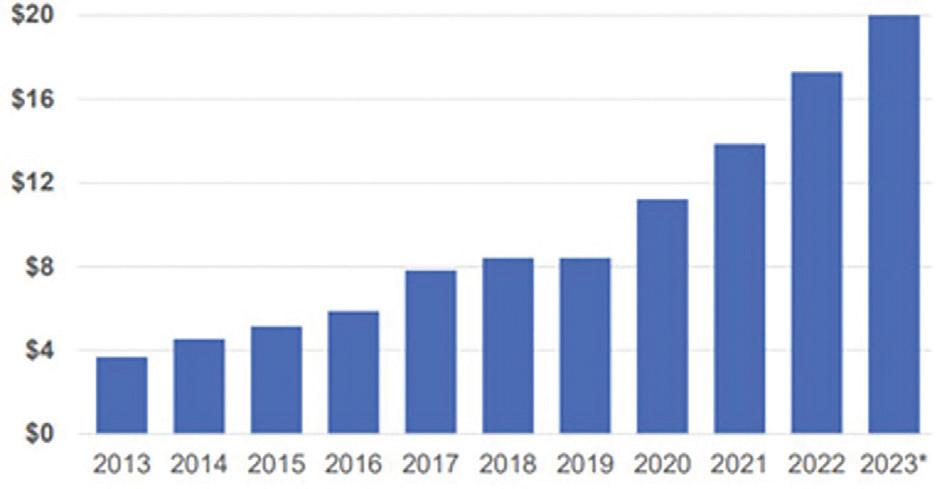
AUA growth is by no means our primary goal. Rather, it serves the ability to unlock new and exciting opportunities that will further enhance our wealth management platform, capabilities, and services. This phenomenal growth has enabled our firm to not only attract some of the industry’s best and brightest financial professionals, but also to expand our national reach opening several new offices.
The direct byproduct of this growth is our unwavering commitment to the fiduciary promise for our clients. This fuel has empowered us to build an enduring and sustainable firm that will be here ready to serve future generations.
After working directly and indirectly with SEIA over the past 16 years, I couldn’t have been more excited to officially join the firm last January. Brian Holmes and the rest of the SEIA leadership team represent everything an Advisor would want to become a part of. I look forward to the opportunities that continued growth enables in serving your future.
On behalf of all SEIA Partners, Advisors, and Employees, we thank you for entrusting us with your financial future. We look forward to continuing our valued relationship with you and your family in the years and decades to come.
PARTNER CONTENT
* As of December 7, 2023 The reported Assets Under Advisement (AUA) represents the combined total of SEIA and its affiliated entities as of 12/31/2023. AUM includes portfolios continuously supervised or managed by SEIA and its affiliates. The AUM encompasses assets like stocks, bonds, ETFs, mutual funds, and cash, among others. Disclosures The information contained herein is for informational purposes only and should not be considered investment advice or a recommendation to buy, hold, or sell any types of securities. Past performance does not guarantee future results. For details on the professional designations displayed herein, including descriptions, minimum requirements, and ongoing education requirements, please visit seia.com/disclosures. Signature Estate & Investment Advisors, LLC (SEIA) is an SEC-registered investment adviser; however, such registration does not imply a certain level of skill or training and no inference to the contrary should be made. Securities offered through Signature Estate Securities, Inc. member FINRA/SIPC. Investment advisory services offered through SEIA, 2121 Avenue of the Stars, Suite 1600, Los Angeles, CA 90067, (310) 712-2323.
107 WORTH.COM SPRING 2024
Mark Jacobson Doesn’t Need Climate Miracles
Stanford environmental engineering professor believes that
wind, water, and solar power are enough to save the climate—if our leaders are willing to use them.
BY MARSHALL HONOROF
Mark Z. Jacobson has been fighting climate change for 30 years—and he’s likely to do so for many more. His most recent book is entitled No Miracles Needed: How Today’s Technology Can Save Our Climate and Clean Our Air. In it, this professor of civil and environmental engineering from Stanford University proposes that we can significantly mitigate climate change, using technologies that already exist today.
Early in his academic career, Jacobson developed the first computer model that analyzed the relationship between air pollution and weather patterns. Using this program, he discovered that black carbon—soot, essentially—was the second-leading cause of global warming.
Jacobson wrote an article for Scientific American in 2009, arguing that we could power the world with 100% renewable energy. To do so, he proposed that we invest in efficient wind, water, and solar technologies. With that energy, we can power emissionless “electrified” devices, from private vehicles to industrial furnaces, he says.

In December 2023, Worth magazine honored Jacobson as one of our Worthy 100 recipients who are doing the most to improve the world. After that, we sat down with him to learn more about his environmental philosophy and his analysis of what works in climate mitigation—and what doesn’t. We have edited this interview for length and clarity.
What are some examples of how existing technology could combat climate change?
The book No Miracles Needed really is about how we can use wind, water, and solar technologies. And that’s not only [for] electricity-generating and heat-generating. That also includes storage for electricity, heat storage, cold storage, hydrogen storage. And it includes electric appliances and machines. Electric vehicles, batteries for electric vehicles, some hydrogen fuel cell vehicles for long-range transport, electric heat pumps for buildings, electric induction cooktops for cooking.
All these electric technologies are helpful. The most helpful ones, I would say, are:
• battery electric vehicles
• electric heat pumps, for air heating, water heating, air conditioning, and even clothes-drying
• electric induction cooktops
• wind turbines and solar photovoltaics
• batteries, for storage
• electric arc furnaces, for high temperature industrial processes
Every combustion vehicle we can get off the road—every gasoline or diesel vehicle that we can replace with a battery-electric vehicle—helps. Every home gas heater that we can replace with an electric heat pump helps. Every coal or oil furnace in the industry that we can replace with an electric arc furnace helps.
You authored and coauthored halfa-dozen climate research papers in 2023. What are some key takeaways?
JACOBSON
SPRING 2024 WORTH.COM 108 GETTY
Is it a good idea to add carbon capture to ethanol refineries in the upper Midwest? There’s a proposal to add carbon capture equipment at 34 ethanol refineries across five states, and then build 2,000 miles of pipelines. I did an evaluation of that. The conclusion was that it was much better to take that money, which was about $5.6 billion, and invest in wind farms to power battery electric vehicles. Instead of those ethanol refineries, which would be used for ethanol-fueled vehicles. It would reduce two to four times the carbon dioxide emissions.
I’ll just point out one more paper where my student looked at the offshore energy resources in the United States. We found that there’s enough wind offshore to power the whole United States.
What is the biggest obstacle to climate mitigation right now—politics, economics, technology, or something else?
Right now, it’s the competition among ideas. There’s a policy known as the “All of the Above” that dates back to the Obama administration. That climate policy is “let’s try everything,” including fossil fuels with carbon capture, bio energy [fuel created from biological compounds], nuclear power, direct air capture, blue hydrogen [derived from natural gas, plus carbon capture], and electro-fuels [liquid fuels, produced with renewable energy]. These are all technologies, in addition to renewables, like wind, water, and solar.
The All of the Above policy, I think, is slowing us down in our efforts to transition to clean energy. It takes money away from what are useful technologies—namely, those like wind, water, solar, and electrification of everything—and puts a lot of money into technologies that are not useful—like new nuclear power, carbon capture, direct air capture, blue hydrogen, and bioenergy.
In fact, 40% of the Inflation Reduction Act in the United States sends money to these technologies that
are not helpful. That’s a big barrier to transitioning. We’re spending a lot of time and money on technologies that are not useful. We have only six years till 2030 to solve 80% of the problem, and only a few years after that to solve 100%. We need to implement technologies that are low-cost, and that can be implemented quickly, and that are very effective at what they do. And those are wind, water, and solar technologies.
What climate projects are you working on this year?
I’m actually doing a new study, looking at transitioning 149 countries to clean, renewable energy across all energy sectors. I’m also examining these All of the Above policies: What are the impacts in terms of costs and carbon emissions, versus policy that calls for only wind, water, and solar technologies?
We actually have a big research project at a laboratory. We’re developing a microgrid [a small, independent, selfsustaining electrical grid]. We’re using lots of new technologies to try to make an efficient microgrid, for remote communities and military bases.
How would you assess the Biden administration on climate mitigation?
Biden’s administration has done several good things. The Inflation Reduction Act that was passed under the Biden administration has been about 60% helpful. I mean that 60% of the funding goes to very useful endeavors, such as wind, solar, battery storage, battery efficiency, electric vehicles, electric heat pumps, electric induction cooktops, and LED lights.
But 40% is also going to what I call useless technologies that do not help climate or air pollution, or energy security—carbon capture, direct air capture, blue hydrogen, and electro-fuels. All of which, by the way, are really promoted by the fossil fuel industry to stay in business. In addition to that, there’s bioenergy supported by the agricultural industry. And there’s nuclear energy supported by the nuclear industry. It’s a mixed bag.
In my mind, we have drastic problems, and we need drastic solutions. Seven-point-four million people die from air pollution worldwide each year, and billions more become ill. Global warming is already at about 1.1 to 1.2 degrees Celsius. If we get up to 1.5 degrees Celsius, we’re going to have a lot more problems than we’re seeing already.
We need to focus on what works, and not waste time on things that don’t work. We need to deploy, deploy, deploy existing clean, renewable energy technologies. We don’t need a miracle technology to solve our problems. We have 95% of the technologies we need right now. And we know how to get the rest.
If the presidential administration were to change, how might energy policy change as a result?
In the last administration, before Biden, nothing really happened at the federal level. What happened was that policy shifted to the states. That’s when a lot of states passed laws to go to 100% renewable electricity. I think that will happen further. If the Biden administration has to leave, then we’re going to revert to where the federal government will do little. I think they’ll still keep some of the basic policies. The production tax credit for wind and solar will probably stay. But pretty much anything related to the promotion of clean, renewable energy will go out the window. And the fossil fuel industry will curry favor and be back in business. We’ll be fighting an uphill battle at the federal level.
Is there anything else you’d like to share with Worth readers?
The most important thing is to stay positive, and focus on what the real solutions are. Don’t get yourself down by being a doomist.
We do have a way to solve the problem. We need to focus on that solution, and encourage our policymakers to focus on that solution. The solution is to go to clean, renewable energy; electrify everything; and provide the electricity with clean, renewable energy. As simple as that.
109 WORTH.COM SPRING 2024
Miami’s Next Wave: A Fusion of Luxury, Art, and Innovation
Historic revival and contemporary opulence in the magic city.
BY KIRSTEN CLUTHE
Miami has always been on the cutting edge of modernism, artistic innovation, and cultural diversity; but now it is at the center of a new, transformative narrative. The Coronavirus pandemic forced some of Miami’s famed hotels to close, temporarily setting the stage for a renaissance. Stroll down the iconic Collins Avenue, and you’ll find yourself amid the rebirth as brands like Aman, Rosewood, and Bulgari are rebuilding or restoring once-historic properties.
Miami is beginning a new chapter. As ever, the city’s soul lies not just in the shimmering façade of its luxury developments but in the stories told by its streets, the murals that adorn its walls, and the rhythmic pulse that defines its cultural heartbeat. Here’s how you can dig into all of it.
WHERE TO STAY
Eden Roc
Designed by the renowned architect Morris Lapidus, the Eden Roc Hotel in Miami is a testament to the city’s golden era of glamour and luxury.
Opening its doors in 1956, the hotel became an instant icon with its distinctive mid-century modern architecture characterized by sweeping curves, opulent details, and a sense of grandeur. Lapidus, famous for his innovative and theatrical designs, created a space that exuded sophistication and elegance.
During its early years, the Eden Roc attracted a glamorous clientele, including Hollywood celebrities, prominent political figures, and international jetsetters. The hotel quickly became a hotspot for the elite, drawn to its lavish amenities and prime beachfront location. Every room has an ocean view, and guests can choose between two experiences. There’s traditional Miami-Beach style in the Eden Roc property, where the rooms have a breezy beach vibe with minimal color, allowing the ocean, sky, and sandy beach to provide the pop. The Japanese beach house style at the
Nobu property, nestled within Eden Roc, offers quiet, modern luxury. No matter which guest experience you choose, you’ll inevitably want to grab a drink at the 16-seat bar in the landmark hotel lobby.
Nobu Restaurant
While there, you can grab elevated bar bites from Nobu or reserve a table at the restaurant, its own singular experience. The restaurant features undulating washi paper that floats above the dining tables, as if you’re immersed in the ocean under ribbons of seaweed. On the menu, Chef Matsuhisa’s iconic fusion of traditional Japanese dishes with Latin American flair, like the Nobu Tacos, each delicately prepared with fish. Can a taco be chic? At Nobu, the answer is yes.
ART IMMERSION
Miami hosts Art Basel every December, but you don’t need to plan a special trip to immerse yourself in the city’s dynamic art scene. From contemporary galleries to avant-garde museums, the Magic City has a range of experiences to offer.
Pérez Art Museum
Located in Museum Park overlooking Biscayne Bay, PAMM is a cultural landmark designed by Herzog & de Meuron. Opened in 2013, the museum has become synonymous with Miami’s commitment to contemporary art. PAMM features a diverse collection of international contemporary art, including works by established and emerging artists. The museum showcases paintings, sculptures, and installations that push the boundaries of artistic expression. Permanent exhibitions include “Transfer Download: Sea Change,” an immersive exhibit that reflects on the interconnectedness of technology and the natural world. The museum also features an outdoor sculpture garden and Verde, an on-site restaurant that boasts sweeping views of Biscayne Bay.
Wynwood
Always a good idea and always changing, Wynwood is an outdoor street art museum in the Wynwood Arts District. Established in 2009, this project transformed the neighborhood into a global destination for street art. Murals and graffiti by renowned artists like Shepard Fairey and Retna adorn the walls, creating an ever-evolving outdoor gallery that blurs the lines between street and fine art. One of the best ways to view it is to book a curator to guide you through the different works. You can also add your own graffiti experience to the schedule: a 30-minute hands-on spray-painting demo to immerse yourself fully in the Miami street art scene. While you’re there, stop by the Margulies Collection at the Warehouse. Founded by Martin Z. Margulies, this private-collectionturned-public-institution has been a cornerstone of Miami’s art scene since 1999. The collection spans various mediums, featuring sculptures, installations, and multimedia art. Artists like Willem de Kooning, Anselm Kiefer, and Olafur Eliasson contribute to the museum’s diverse and impactful collection.
TRAVEL CAPSULE
SPRING 2024 WORTH.COM 110
ICA Miami, the Institute of Contemporary Art
A cutting-edge institution in the Design District, ICA Miami opened its doors in 2017 and has been a focal point in Miami’s evolving art landscape ever since. The institute hosts rotating exhibitions that push boundaries and promote continuous experimentation. Their commitment to advancing the work of local, emerging, and under-recognized artists is apparent: Admission is free all year round, providing open access to the public. ICA also hosts public events designed to promote the exchange of ideas and stimulate creative thinking.
CULTURAL DIVE
CULTURAL DIV
Miami Design District
The Design District is renowned for its luxury boutiques featuring international and local designers, offering a shopping haven where fashion enthusiasts can explore the latest trends and exclusive collections. Cutting-edge galleries and public art installations dot the artfully designed streets, transforming the district into an open-air gallery that transcends traditional boundaries. And there’s always something happening—a maker’s market, a design fair, a celebration, or other events that give you a reason to drop in and stay awhile. You’ll also find Michelin-starred restaurants—Le Jardinier, recently awarded one star, and L’Atelier de Joël Robuchon, boasting two Michelin stars. And don’t miss Mia Market, a chef-driven food hall that might be the best way to taste all the flavors Miami offers.
Allapattah
Named after the Seminole Indian word for “alligator,” Allapattah is a barrio just west of Wynwood and an emerging cultural hot spot. It’s grounded by the Rubell Museum, renowned for showcasing thoughtprovoking contemporary art from the extensive Rubell family collection, featuring works by some of the mostinfluential artists of our time, includ-

ing Jeff Koons, Keith Haring, and Jean-Michel Basquiat. Allapattah is a cultural melting pot, with residents from Central America, Cuba, and the Caribbean making up much of the local population. You’ll find many hidden gems to experience, from sophisticated Basque cuisine at Leku in the Rubell Museum to a Dominican chimichurri sandwich from the Chimichurri Donde El Primo truck on 36th Street.
Española Way
It is not a neighborhood per se, but a vibrant street tucked inside of South Beach. Built as an artists’ colony in the 1920s and designed to evoke the quaint villages of France and Spain, this pedestrian-only corridor features more than a dozen restaurants and
cafés, three boutique hotels, and a smattering of specialty shops.
Prefer to stroll through Espanola Way and dine nearby? Gianni’s at the Former Versace mansion is a few blocks away. Located inside the former home of Gianni Versace, which has been both a membership club and boutique hotel since he died in 1997, it features an upscale Italian menu, and the setting is undeniably one of the most beautiful in the state. Casa Tua, also located a few blocks away on 17th Street, could be described as a hidden gem, as it still manages to fly under the radar. Dining at Casa Tua is like attending a dinner party at a well-heeled but low-key friend’s house, complete with a library, lantern-lit trees in the garden, and a 20-seat chef’s table with a view of the kitchen.
111 WORTH.COM SPRING 2024
Time to Play
The always-evolving sport watch is the perfect accessory for gym shorts or a business suit.
BY CAIT BAZEMORE
One of the most popular categories of timepieces today is arguably the luxury sport watch. Thanks to their mix of practical functions and high-end materials, they can easily be dressed up or down in a world where playing with high and low elements is increasingly en vogue. (Think of a classic power suit with the button down swapped for a tee or loafers swapped for leather sneakers.) The sport watch is the ideal accessory for today’s jet-setting businessperson, taking them from a meeting in London to an F1 race in Monaco.
The category first rose to prominence in the 1970s with the birth of the original luxury sport watch, Audemars Piguet’s Royal Oak, which debuted in 1972. Nearly half a century later, the category has evolved in many ways. Yet, models like the Royal Oak have only risen in popularity, proving the timelessness and staying power of the design.
Unlike a true tool watch, which favors function over form, the luxury sports watch is the perfect blend of the two. It’s utilitarian enough for a casual scrimmage and stylish enough for dinner and drinks afterward. More and more, brands are pushing the bounds of both elements—technical prowess and superior design—and these ten watches prove it.
BREITLING TOP TIME CLASSIC CARS TOURBILLON
Breitling’s Top Time collection dates back to 1964. The birth of the model was a direct reflection of the era, which foreshadowed the advent of the luxury sports watch a decade later. At the time, Willy Breitling (grandson of the brand’s founder, Leon Breitling) saw the need for a contemporary sport collection with greater focus on aesthetics rather than strict performance. The collection launched with a stainless-steel chronograph, but over the years, Breitling has elevated the collection with new materials and complications. The latest incarnation is the
perfect example of how the line has evolved into a luxury sport watch today. The new Top Time Classic Cars Tourbillon offers combinations of bronze, ceramic, and titanium for the cases and walnut burl on one of the dials; and each comes equipped with Breitling’s in-house Caliber B21 tourbillon movement. The use of new materials is a direct ode to the cars that have inspired the watches in the collection, reflecting the colors and textures of the paint, steering wheel, and dashboard inlays found in the vehicles. In addition, the Caliber B21 is particularly unique for its combination of two complications: a tourbillon and a chronograph.
ZENITH DEFY EXTREME MIRROR
Zenith has been another forerunner in creating some of the best luxury sport watches on the market that perfectly blend aesthetics and performance. At the core of the brand’s collections is its famous El Primero movement, which offers precision to an impressive 1/100th of a second. Like Breitling, Zenith’s designs have become increasingly refined over the years. The Defy collection is emblematic of this evolution of the brand’s luxury sport watches. The line first debuted in 1969 as a precursor to the luxury sport watch. It notably boasted a robust and angular, octagonal case and fourteen-sided bezel, the ring that frames the dial and secures the crystal. The watch was originally marketed for its util-
ity and lasted only about a decade. When the Defy was revived in 2006, it received an elevated design, which continues to reflect throughout the collection today, in models like the brand-new Defy Extreme Mirror. With this latest model, you get a full mirror-polished case along with an open-worked, multi-layered dial featuring a central element in sapphire crystal, with a metallic mirrored finish that’s translucent yet reflective.
ROGER DUBUIS EXCALIBUR SPIDER REVUELTO FLYBACK CHRONOGRAPH
When it comes to some of the most luxurious sport watches, look toward brands that collaborate with luxury car manufacturers. There’s no better way to up the ante on the “luxury” aspect of the sport watch than with a powerhouse pair. Roger Dubuis is a newer brand, first established in 1995. Since then, it’s built a reputation for its chronographs. A little

WATCHES
SPRING 2024 WORTH.COM 112
over a decade after its founding, Roger Dubuis began teaming up with the famed Italian sports car manufacturer Lamborghini on a number of collaborative timepieces. The latest is the limited-edition Excalibur Spider Revuelto Flyback Chronograph, which marks the brand’s fifth generation of chronograph design. The model offers superior functionality thanks to Roger Dubuis’ RD780 movement and pairs it with a sporty design inspired by the Lamborghini Revuelto. The RD780 is an integrated chronograph caliber that’s particularly notable for boasting two exclusive patents: one linked to the second hand of the chronograph and the other to the display of the minute counter.
CARL F. BUCHERER MANERO FLYBACK
Carl F. Bucherer is a watchmaker that’s become widely known for sophisticated dress watches and highly
complicated movements—thanks to the brand’s proprietary peripheral technology. Over the years, the brand has accumulated an expansive catalog, which it refined in 2023 as part of Carl F. Bucherer’s incredible 135th anniversary. Here, the watchmaker distilled its offerings down to three core collections: Heritage, Patravi, and Manero. The Manero line is stylish and urban, perfectly capturing the spirit of the luxury sport watch. The Manero Flyback first joined the lineup back in 2016 and has seen several iterations since. The latest showcases two new dial configurations—one in silver with black chronograph counters and one in black with silver chronograph counters. Both evoke the iconic panda and reverse panda style combined with the elegant lines of the Manero collection, with the bonus of a sporty flyback chronograph complication.

ROLEX COSMOGRAPH DAYTONA CELEBRATING 100 YEARS OF SPEED
It’d be impossible to talk about luxury sport watches without including Rolex. The Crown has been at the forefront of the category, with models like the Daytona, the brand’s flagship sport model, since its inception in 1963. The watch, named for the famous Daytona 500 race, has become one of the most highly coveted sport watches, with waitlists in the primary market, prices above retail in the secondary, and records shattered at auction. The most expensive Rolex ever sold at auction was Paul Newman’s Daytona, which went for a staggering $17.75 million at Phillips in 2017. This year marked the monumental 60th anniversary of the model as well as the 100th anniversary of the famed 24 Hours of Le Mans race. To honor both occasions, The Crown launched a limited edition of the Daytona in white gold, instead of the typical stainless steel.
PARMIGIANI FLEURIER TONDA PF SPORT ROSE GOLD
Similar to CFB, Parmigiani Fleurier is a brand that’s built a reputation for its ultra-luxurious dress watches and complicated timepieces. In 2021, the brand welcomed a new CEO, Guido Terreni, who wanted to establish a fresh new design language for Parmigiani to define the brand and make its timepieces uniquely recognizable. The result was the debut of the Tonda PF collection, which followed the brand’s Tonda GT and Tondagraph GT models, launched the previous year. Each marked a new sporty direction for the brand. This year, the collection has evolved further with the introduction of the Tonda PF Sport line. Initially released in two variations—a clock and an automatic— the Tonda PF Sport collection pushed the bounds of sport and luxury with subtle design updates and the option of rose gold as an alternative to stainless steel.
113 WORTH.COM SPRING 2024

WATCHES

GIRARD PERREGAUX NEO BRIDGES ASTON MARTIN EDITION
Partnerships with high-end car manufacturers remain a theme among today’s leading luxury sport watches. Girard Perregaux and the prominent British carmaker Aston Martin have only been teaming up for two years, but in that time, we’ve seen several collaborative watches emerge from the dynamic duo. One of the latest additions to the partnership offers a unique take on the luxury sports watch. The Neo Bridges Aston Martin Edition draws inspiration from the carmaker’s iconic Super Tourer, DB12, with sculpted contours and sharp lines that have been trademarks of the luxury sport watch since the debut of the Royal Oak. Here, the case is rendered in lightweight titanium that’s received a black DLC treatment, giving the model a modern, blacked-out look that’s still elevated.


LAURENT FERRIER LIMITED EDITION SPORT AUTO 40
Last but not least among the luxury sport models that draw inspiration from motorsports is this limited edition from Laurent Ferrier. Like Rolex, the brand also has ties to the 24 Hours of Le Mans—tracing back to the brand’s founders, who met while participating in the iconic race in 1979. The Sport Auto 40 pays homage to the legendary Porsche 935 Turbo No. 40—the racing version of the Porsche 911 Turbo—driven by the founders during the race. With this watch, you get all the classic design cues of the quintessential luxury sport watch, like a robust case design and integrated bracelet. Then, you have the bonus of a decidedly playful dial design rendered in a bold green, fuchsia, and orange color palette reminiscent of the Porsche 935 Turbo No. 40.
AUDEMARS PIGUET ROYAL OAK
NORQAIN WILD ONE GOLD
Norqain is another newer brand, first launched just a few years ago in 2018. In short order, it’s become known for its highly accessible timepieces. Last year, industry legend Jean-Claude Biver joined the company as an advisor to the board and helped develop a new collection for Norqain called Wild One. The line debuted with four rugged and colorful sport watches that introduced an all-new proprietary material called NORTEQ, which is six times lighter than steel and three-and-a-half times lighter than titanium. Now, Norqain has firmly elevated the line and crossed it over into the luxury sport watch category with the introduction of the first-ever gold Wild One. The model uses the brand’s proprietary NORTEQ as the base for the case, then casts it in solid 18-karat rose gold. The result is the ideal balance of form and function, retaining the collection’s ultra-lightweight construction with the bonus of a precious metal.
“JUMBO” EXTRA-THIN
It’s safe to say the Audemars Piguet Royal Oak is still the ultimate luxury sport watch. Over 50 years later, the model’s design and popularity are simply unmatched. The “Jumbo” moniker didn’t appear in the AP archives until the 1990s. However, the term could describe the original Royal Oak whose 39mm proportions were oversized for the era. In 1992, the brand began equipping several “Jumbo” models with its ultra-thin caliber 2120. It started with the Royal Oak 14811; and since then, we have seen many design iterations. One of the latest versions combines two contemporary materials: titanium and bulk metallic glass. BMG is a cutting-edge material co-developed by AP with a base made of palladium. This rare and lustrous silvery-white metal makes it particularly shiny and resistant to scratches.
SPRING 2024 WORTH.COM 114
Robin Kelly O’Connor on the Greatest Organic Wines
One of the most-accredited sommeliers breaks down the best wines that you never knew were organic.
BY JONATHAN RUSSO AND DEBORAH GRAYSON
Decades ago, we were in Beaune, Burgundy, trying to track down organic wine producers. We happened upon a leading wine shop and asked the owner to identify his organic selections. His hand swept the room, indicating nearly all were. We were incredulous, partly because none were labeled as such. He politely explained that most of these families had lived and farmed on their small estates for centuries and knew enough not to poison their soils, or their families. They had never abandoned their traditional methods, which, coincidentally, were now in vogue (as organic). These producers have always sold out, mostly on allocation. They didn’t need to advertise their methods. The wines spoke for themselves.

Remembering this experience, we thought it was time to get an update from Robin Kelley O’Connor, one of the world’s leading wine experts, lecturer, sommelier, writer, and international wine judge. What follows is an extremely truncated biography.
Mr. O’Connor is co-host with Kevin Zraly on “Windows on the World Virtual Wine School.” He worked for Italian Wine Merchants, as the director of wine education and private client portfolio advisor, specializing in rare and collectable wines. He was previously vice president, lead specialist, and head of wine, Americas, for Christie’s Auction House, and vice president at Sherry-Lehmann. He worked for 20 years with the Bordeaux Wine Bureau. He has been inducted into the wine world’s most prestigious institutions, including the Commanderie du Bontemps de Médoc, the Jurade de Saint-Emilion, Les Hospitaliers de Pomerol, and NY Chapter of the Commanderie de Bordeaux.
Before asking him about ethical wines, we asked him a little more about himself.
What piqued your interest in the world of wine?
Robin Kelley O’Connor: I noticed there was a wine appreciation course at my college, the University of Maryland, given by their adult education department, the largest university in the U.S. Because wine explains history, geography, and cultural mores, it fits nicely into my interests as a European history and political science major. The professor had us taste all the grand crus during the two years I took these classes. This was so many decades ago that the prices, even for the best wines, were a fraction of what they are today. Students could taste the best in a classroom. I was intrigued and started reading everything I could about wine, which wasn’t much then.
WINE 115 WORTH.COM SPRING 2024
COURTESY OF CHATEAU PALMERPHOTO BY OLIVIER METZGER
WINE
Then I did a semester abroad in Eastern Europe where wine was offered with every meal, so I learned a lot about Eastern European wines—not the usual route of France or Italy as the foundational wines.
A few years after graduation, I planned a two-month trip to Europe but I “missed” my return flight and stayed five years, mostly in Paris, but with significant periods in the rest of France, Spain, and the UK, where I was allowed to take wine classes in return for doing entry-level work. Before that, in France, I worked with several prestigious Chateaux picking their grapes.
From there, how and why did you make the transition to fine wine?
The Chateaubriand Restaurant at London’s Mayfair Hotel didn’t have anyone who knew how to decant wine. No kidding. To get the job, all I had to do was decant an old port without damaging the decomposing cork. I was 25 years old, working with one of London’s best wine lists. It was a night job, so I could continue with my wine education during the day. Luckily, this included more grand cru tastings. My mentor, Michael Broadbent, happened to be the head of Christie’s wine department. He was considered the world’s greatest wine taster.
In your exploration of fine wine, when did you realize that so many of the world’s top wines are quietly organic or biodynamic?
People were flirting with organic grape growing in the 90’s. I started working with the Bordeaux Wine Bureau in ’89. There’s a French wine expo every other year. The first organic participants I remember came from a small movement in the Loire Valley, led by Nicolas Joly and his Clos de la Coulee de Serrant, along with Burgundy’s Lalou Bixe-Leroy. They organized an organic wine side event that grew over time. Participants included a few vineyards from Burgundy, notably André Noblet’s, La Romanée-Conti.
There were also pioneers from Alsace and Minervois. By 1995, the organic movement was reaching a critical mass with the driest areas, where it’s easiest to grow grapes, like Alsace, in the forefront. Notable vineyards were and are Zind-Humbrecht, Marcel Deiss, and Domaine Weinbach.
There are 5,300 chateaux in Bordeaux. By 2025, all aim to be sustainable, which means a lot in France. They’re tackling something difficult because Bordeaux is infused with moisture from the Atlantic.
How has the world of fine wine changed in the decades you’ve been doing this?
Overall, wines have never been better. We’re in the golden era of wine. It’s such a lucky time for both consumers and professionals. The only regret I have for young people is they can’t afford to taste the top wines. When I was a poor student, I could experience the best. Now Petrus is $4,200 a bottle. I can’t buy it now, but I have so many vivid memories because I worked there for 2 years. Also, young producers who used to sell to coops now take pride in bottling their own wines. Up and down the wine chain, the emphasis is on quality. For example, the late, legendary Burgundian négociant, Becky Wasserman taught us to care about terroir.
If a vineyard is organic or biodynamic, why would they choose not to tell the consumer?
There are a few reasons. Mostly because they sell out, so they don’t need it as a marketing tool. Also, they don’t want to be labeled as making wine in a particular way. Lastly, many of these family producers have been making wine for generations before there was such a thing as pesticides. They never used them, so why advertise them now?
What do you think the future of organic/biodynamic wine is? Is it on the upswing or not?

I see it as a gradual growth. For example, in Bordeaux, only 77 of the 5,300 vineyards are certified biodynamic. But with the sustainable movement taking hold there, I think you will see other Chateaux becoming organic. There’s a global push to be environmentally friendly. Organic is a step toward that.
Which is most important to consumers: organic, biodynamic, or natural?
Organic is first. Most people appreciate what it means. Next is natural, which I’m not a fan of but has taken hold in a big way among young drinkers. I fear their incon-
SPRING 2024 WORTH.COM 116 COURTESY OF OPUS ONE

sistency and odd characteristics may damage the reputation of good organic and biodynamic wines. Last is biodynamic because most people don’t understand the farming requirements.
In your opinion, which country is the leader in the ethical wine movement?
Italy is at the forefront because they have the weather and soil, making ethical farming easier. But France and Spain aren’t far behind.
How important do you think ethically made wine is to retailers?|
Those in hipper, younger neighborhoods, like Brooklyn, care.
I don’t think it’s gone mainstream yet.
When you are drinking for your pleasure, do you seek out bio/ org wines?
Not really. It’s a bonus if it’s organic or biodynamic, but I’m more interested in drinking the most rewarding wine.
Where is the movement going? Currently, the whole world is focused on the concept of sustainability. But it’s a baby step.
(This interview has been edited for clarity and space.)
France
Palmer, Petrus, Pontet-Canet, the very affordable Clos du Jaugueyron, Y’quem, Zind Humbrecht, Domaine Weinbach, Gerard Bertrand Source of Joy Rose
Spain:
Alvaro Palacios’s Finca Dofi and his $600 L’ermita, Raventós sparkling wine blanc de blanc ($20!)
Italy
Querciabella Chianti Classico
Argentina
Catena High Mountain
California
Opus One, Iron Horse sparkling Ocean Reserve, Tablas Creek (joint FrenchAmerican venture)
ROBIN KELLY O’CONNOR’S TOP PICKS
117 WORTH.COM SPRING 2024
Symphonies of Mastery
The resonant echoes of artistry in Virelles’s keys and Howsare’s prose.
BY JASON ASHLOCK
BOOK
The Age of Deer
BY ERIKA HOWSARE
The buck in question boasted an impossible 29 points, and his home range was a cemetery. He was often seen as a fearsome, otherworldly silhouette in the gloaming, his crown a forest unto itself. Navigating the misty maze of headstones, bending his heavy crown beneath the bony branches of the magnolias, they say he stepped lightly over the dead.
The buck’s killing in the late, wet days of 2023 was met with grief as thunderous as the deer’s crashing through winter forest. Outrage descended upon a boastful twentysomething who was brutal enough to kill the beast, and careless enough to post about his feat on social media. Charges are pending in Richmond, Virginia—not for the killing, but for where it occurred, beyond the pale of where the felling of fauna finds societal approbation.
Deer are among the most charismatic of the macrofauna that remain. Is it their blend of litheness and strength, their sharp, statuesque figure and delicate bones? Or their curious courage and fast flight response, their family structure and survivor history? Or how they carry in their upright ears and unflinching stares hints of both wildness and home?
Why we feel so deeply and act so strangely toward these twilight creatures is the subject of Erika Howsare’s consuming The Age of Deer. In this profound and courageous walkabout of a book, she traipses into a dense thicket of social and economic history, myth and imagination, culture and ecology. The result both pleases and demands.
To answer—or more accurately, to better ask the question—Howsare ventures through centuries, across cultures and geographies and peoples. We come along because we must. Howsare’s hospitable manner and magnetic subject draw us along, the doggedness of her research hidden beneath easy prose. Like with a mystery novel, we learn without meaning to. That deerskin trade was a key industry in colonial America,
responsible in part for the rapid growth of cities like Charleston and Augusta. That deer parks in Britain once numbered more than 3000, a showy phenomenon in a nobleman’s portfolio, enclosed by fences known as pales—thus gifting us a common “beyond the pale.” That our now-preservationist term “wilderness” derives from the Old English deor, as we seem to know wildness first from the deer that tell us we’ve entered it. That in Europe’s transportive cave galleries— Lascaux, Chauvet, and Altamira—deer are one of most oft-painted creatures. That in the United States, more than 30 states invested fortunes in moving white-tail deer with great care and precision from one region to another to ensure continuity of population.
So we could kill them, of course. The thread throughout Howsare’s exceptional investigation is that deer are not just twilight dwellers in a circadian sense, but liminal creatures in a metaphysical landscape, leaping across the gap from death to life and back again. Among the most common roles of deer across a diverse range of mythologies is that of psychopomp, an escort to the afterlife. Rituals abound: before we hunt, after we kill, when we eat, when we make of the animal remains tools and art. In a particularly compelling sequence, Howsare participates in the full physical dismantling of this evolutionary marvel, learning how each of a deer’s component parts become of value in a human context. And yet the deer is not reduced: With each piece removed, the deer’s individual life is revealed—past traumas and scars, diet and habitat and range and lineage. Like rings on a tree, it is a narrative visible only after its felling. A life seen through the lens of death.
With each morsel, Howsare feeds us her fascination and regard, until—like in the ancient rituals she describes—we have become high with the consumption, and our vision of history and society is altered forever by the presence of a stag, a fawn, a doe. Her fascination and regard is not limited to the deer, but extends to the humans that encounter these animals, as poets, protectors, or predators. Howsare is fully present, as both observer and participant, a host at her home in the foothills of the Blue Ridge, a visitor to territories and subcultures
far afield from her own. Of the book’s many virtues, its most remarkable may be Howsare’s rare entrance into what she calls “a marriage of discomfort,” to gaze with empathy toward both hart and hound, to tiptoe on the line between the sentimental and the rationale, the elemental and sublime, to float like a leaping deer across fences.
Howsare’s work is a standout in an increasingly crowded category, the titles multiplying that attempt to approach our anxious, revelatory relationship with the wild. Such books, as devoted as they are to the creatures they center, are often proxies for another kind of contemplation. The animals guide us back to ourselves. The Age of Deer is no exception to this rule, except in the quality of its execution. Within each chapter, Howsare demonstrates an extraordinary ability to hold in sustained conversation the human and wild. With deliberate, approachable framing, she asks again and again the question we confront restlessly in these troubled Anthropocene days: How can we return to an Earth we’ve so wounded? In her grounded, considerate manner, Howsare holds us as subject as much as the deer that carry the title, observing both with a tremendous depth of generosity, a feat nearly as impossible as putting a hand on a wild doe.
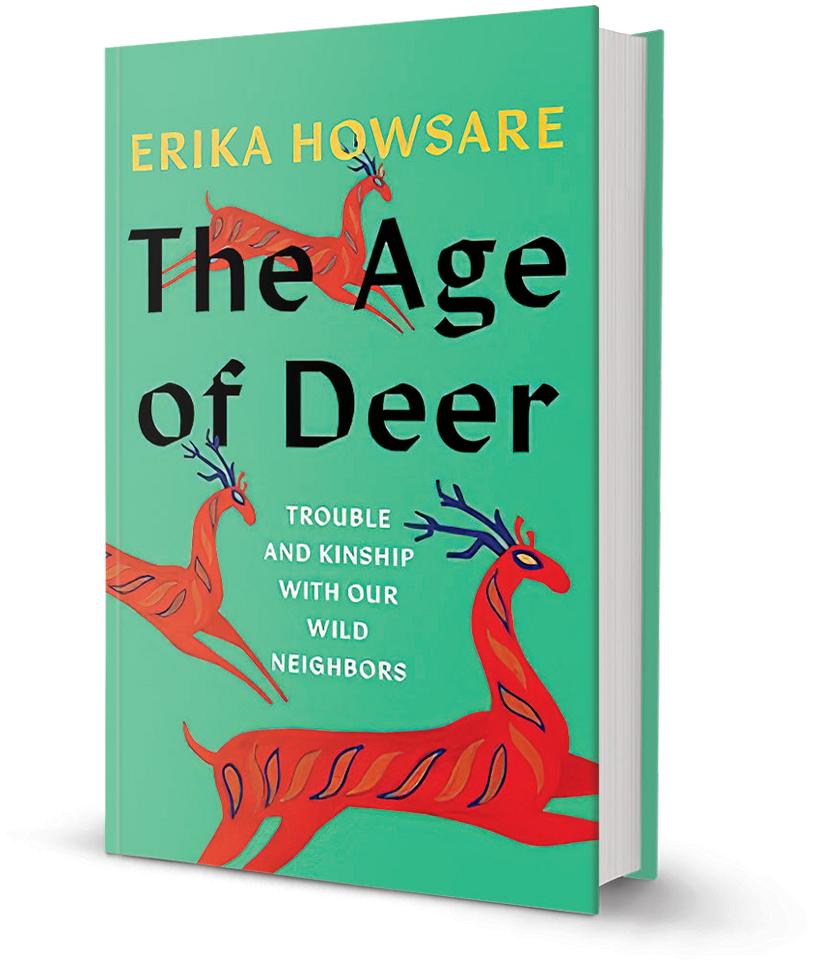
MIXED MEDIA
SPRING 2024 WORTH.COM 118
ALBUM
Carta
BY DAVID VIRELLES
Back in the Birdland heyday, when Charlie and Ella and Stan and Art packed the joint and made a sound for the ages, the inimitable emcee Pee Wee Marquette was known to introduce Thelonious Monk with one of history’s most brilliant mispronunciations: “The Onliest.”
Witnessing David Virelles at the keys sends one searching for a similar malapropism. However you rank yourself on a hepcat scale, it’s likely you have never seen a human do such things to a piano. To comprehend a Virelles performance is to require a new poetic vocabulary, a language custom-made for his fiery athleticism and astonishing precision. Mentioning his Cuban heritage will help. Hat-tipping his tutelage at the feet of Jane Bennett and Henry Threadgill and Chris Potter and Steve Coleman gets
you close. But precedence and categorization will not get you there. One must see Virelles to stand appropriately agape at his talent.
On a recent winter’s night in Zurich, just as the dominant were descending from Davos, 150 souls braved the winter rain to huddle in a moody club in the city’s industrial district. Virelles emerged humbly, ostensibly there for an evening in promotion of his new album “Carta,” an exuberant blend of Afro-Cubano sounds and avant-garde experimentations. Attendees were party to a series of beautiful violations.
Here was Virelles grasping greedily at the keys, pushing, pulling, and rolling the black and whites, melting hardwood and ivorite beneath his blistering fingers. Here he was, a masseuse maneuvering across a muscled back, pushing the tension toward the edge and dragging it to center again. He plays with his elbows, his knuckles, his wrists. With the hair on his forearm? One wouldn’t be surprised. Then suddenly a shift: He is a child pecking playfully at a toy keyboard. Then: a viper striking with

the left hand, landing the bite. Then: a woodpecker, impossibly quick and needle-nosed, penetrating the skin of the surrendered instrument. No, his hands are a pair of ragged claws, scuttling across the floor of roiling seas. He is insistent, obsessed, pounding, and then not touching anything but air—his hands suspended above the keys, sound somehow emitting from a machine now trained to read his mind. At climax, he breaks the wall, keeping his left hand striding, while the right reaches into the piano itself, fingers grazing unhammered strings.
Virelles was drenched with sweat, and the sets were short. Just as well, as the rest of us were out of metaphors anyway. The crowd began trickling out, all smiles and headshakes and gestures of astonishment. Virelles was heading back to New York, his able allies of Eric McPherson on percussion and Ben Street on bass with him, having completed a short run of shows in Paris and Geneva. Some of his students were in attendance, proud of their proximity to the preternatural, whose extreme control masquerades as chaos, whose elegance becomes indistinguishable from brute force, whose manipulation of a grand appears as gentleness. It is a kind of mirage, a form of magic. Pee Wee might call it a Virellusion.

GETTY 119 WORTH.COM SPRING 2024
Tailor Made
Savile Row’s first female master tailor takes Edinburgh.
BY SARAH POWLESS
When one thinks of Savile Row in London, the first image that comes to mind likely consists of an intimate shop run by a cadre of smartly dressed, well-trained men who expertly craft custom garments for a high-profile male clientele. Since the 18th century, male politicians, musicians, royalty, and socialites have flocked to Savile Row to procure made-to-measure pieces from shops helmed by male cutters. Napoleon III, Winston Churchill, Mick Jagger, Elton John, and Prince Harry are just a few of the dozens of notable men who frequent London’s famed tailoring shops.
However, in 2016, Kathryn Sargent moved to change that male-dominated image when she became the first and only female master tailor to open her shop on Savile Row. Before this, Sargent had already established herself as a force to be reckoned with in the bespoke field. With over two decades of experience, she had already become the first woman to reach the post of head cutter in Savile Row history at Gieves & Hawkes, one of the street’s oldest
fashion houses.
Now, not content with running her Savile Row shop, Sargent is taking her incomparable skillset and unique take on custom clothing craftsmanship to Edinburgh. With a new shop on Howe Street, run alongside Scottish-born head cutter Alistair Nimmo, she is expanding the scope of her clientele and her relationship with the traditions of British tailoring.
For instance, as with the London Atelier, Sargent’s customers can order suits, coats, dresses, and skirts. How-

ever, customary Scottish garments, including trews, kilts, and capes, will now also be on offer. Further, since the advent of her business, Sargent has always offered a Kathryn Sargent Harris Tweed, specially woven in the Outer Hebrides, off the west coast of Scotland. To celebrate the opening of the new atelier in Edinburgh, two new colorways of her signature Harris Tweed designs in green and blue have been added to the shop’s repertoire, in addition to a broad selection of tartans. Simply put, Sargent’s Edinburgh location aims to blend traditional Scottish textiles and dress with her unique take on British tailoring to create a sustainable, bespoke experience for a new city.
We recently sat down with Sargent to hear more about her experience climbing to the top of the male-dominated Savile Row, as well as what she hopes to bring to Scotland’s capital with her new shop.
As Savile Row’s first female master tailor to have her own shop, what has your experience been like rising to the top of this traditional, male-dominated industry? Throughout your ascendance, were there times when you were made aware of your gender? And, if so, how exactly did those instances materialize?
When I started in this industry, there were very few women in client-facing roles. There were always women in the industry but behind the scenes. It’s a very unusual industry because we must deal with customers, and we always must be available. It’s just a very hard industry to be in as a woman. However, I have always been encouraged. I have always been interested in cutting and the customer and delivering lovely products and great service. My ambition was not to be behind the scenes, but to be in front. I didn’t want to change the world or anything, but I really wanted to do this. It took people a bit by surprise, but I’ve had great support from the men in the industry who have similar roles. For me, I didn’t think of myself as a woman, I thought of myself as a tailor. There are some fabulous women in the industry,
FASHION
SPRING 2024 WORTH.COM 120
PHOTO BY ROBERTO RICCITUI
but just not many who have gone out and ser up their own businesses. There are a couple more now, but back when I started mine 11 years ago, it was the first time when a master tailor was a woman in this world. It was quite unusual, I suppose.
When I was a young cutter back at Gieves & Hawkes and I was training, that’s when I started seeing customers and started managing the process myself. There was a little bit of resistance from a couple of customers. There was one lady who refused to see me and said that I shouldn’t be doing that job. It was an interesting experience, and I didn’t expect it to come from a woman. And there was one gentleman who also refused to see me. But that was two people in 15 years. Now, I think people will come to my business because they want to meet me and want to work with me. I’m not hiding in the shadows, but I’m making a bold statement that women can do this equally as well as men. I haven’t encountered resistance, but only surprise when I meet people.
Savile Row is and has historically been a bastion for a male dominated clientele, and many houses still only advertise themselves as hubs for men’s tailoring. Over the course of your tenure on Savile Row, have you seen an expansion of the craft to cover women’s or, rather, gender-less tailoring at all?
There are more and more women who are looking for quality tailoring and are seeking out the skills of a tailor to have something made. Tailoring has been incredibly fashionable in recent years. Especially in the postpandemic world, women are dressing up more. Most of my customers are still predominantly male, but the reason I set up my business was because I saw that there was an opportunity to cater to and make things for women. I was trained at No.1 Saville Row, and historically, Saville Row has been male-dominated in terms of its client base. But, women now are in roles that they probably once couldn’t have
even dreamed of being in, and they need clothes for that. And where do you go for those? Not every brand or designer caters to different body shapes or requirements regarding how a garment performs. There’s a huge opportunity for women’s tailoring at the moment, and I wanted to set up my business to make it for everybody. We make for all genders. Understanding the individual and their needs and problem solving for them excites me.
As mentioned, you are currently the only female master tailor on Savile Row, and indeed in its history. Do you see Savile Row and the rest of the bespoke industry more broadly taking steps to even this gender imbalance?
More women are in the industry than when I started, and I think all businesses are actively recruiting women. We just want to keep the talent pool growing and pass our skills on to the next generation. It should be less of an issue. Each company has their policies, of course, but I have many female colleagues in training now. Some are cutters, and some are tailors. I’ve recruited several women for my business, which I’m very proud of.
You are now expanding your business and bringing your skillset to Edinburgh with a formal physical location. How do the Scottish tailoring industry and Scottish tailoring practices distinguish themselves from their English counterparts?
For me, it’s all about the textiles, the ingredients that go into the tailoring. A lot of my materials come from Scotland. I love Harris tweed, Shetland tweed, and tartan. I love all these amazing cloths that are produced in Scotland. I also love
“It’s just a very hard industry to be in as a woman. However, I have always been encouraged.”
the style. People dress up for different occasions, and since it’s a lot colder there, people tend to layer up and wear more tweeds and coats. I just thought, there is a tailoring industry there, and there are tailors based in Scotland, but I just want to bring something different. I want to use the inspiration of these beautiful Scottish textiles and present them in my way. I’m from Yorkshire in the north of England, so I’ve had that influence of Harris tweed throughout my career. So, it was important for me to have my own Harris tweed, which I’ve designed and had since I started my business. There are now new colorways, which are available in Edinburgh. But I do think it’s an interesting industry. There are a lot of people making traditional Scottish dress, which we will do, but I wanted to just bring my craft there and showcase it in a different way.
Finally, what are you hoping to bring to Edinburgh’s bespoke scene with your shop? Conversely, are there any new practices or traditions that you’re looking to explore there or bring back to your clientele in England and across the world?
Scotland is such a source of inspiration for me, and having a presence there is heartwarming. I’ve designed a range of accessories and ready-towear pieces made in our tweed, and we plan to do all sorts of exciting things with the Edinburgh shop. Of course, it will all be inspired by Scottish styles and textiles. For example, there will be many amazing evening wear and our take on country attire. It’s an opportunity to delve into the traditional designs and then present our take on them. We have an atelier there, so we can manage the whole process there, and Alistair, who I trained in London, is Scottish and is heading up the Edinburgh business. He can give great advice on tartans, tweeds, and style. That is a point of difference, because we have that expert knowledge there. Ultimately, I want to provide our customers with something different.
121 WORTH.COM SPRING 2024
M.T. Connolly’s Crusade Against Elder Abuse
From the Justice Department to authoring The Measure of Our Age, Connolly shares insights on tackling elder abuse through intergenerational collaboration.
BY JIM MCCANN
M.T. Connolly has dedicated her life to combating elder abuse. A former lawyer at the Department of Justice, she has authored a recent book, The Measure of Our Age, which investigates the state of elder care, and lack of care, in our society.
Connolly takes us through her transformative journey from addressing legal aspects of elder justice to deeply exploring the structural challenges in elder care. She highlights the changing dynamics of elder circumstances over generations, the alarming prevalence of elder abuse, and the stark reality of age segregation in our society.
This conversation has been edited for length and clarity.
How did you become sensitive to the issue of elder abuse?
At the Department of Justice, we launched something that we called the Nurse Initiative, and then changed the name to the Elder Justice Initiative. It focused on problems in nursing homes, abuse and neglect, and also fraud.
When I learned about the issue and dug into it, I understood it wasn’t a new problem at all. It has been going on for a very long time and is related to all sorts of structural issues. And I initially thought, look to the law for answers. We prosecuted some nursing home chains, and we looked at how we might tweak the law. Then I went over to the Senate and worked with them on something called the “Elder Justice Act” (passed in 2010). Although we made some progress, they were not silver bullets.
So that’s what led me to write the book, because I wanted to understand at a deeper level what was
going on. Why is it that as a society, we tolerate seriously substandard care for some of the most vulnerable citizens? And unlike other issues that divide us, we are all aging. It doesn’t matter who you are, where you are, your race, ethnicity, political affiliation, or geography, we’re all moving through time together. We’re all older people in training—if we’re not there already. So I want to attend at a deeper level to what was going on.
How has the elder care problem, the elder circumstance, changed over the generations?
“The models we have for aging are largely either isolation or age segregation. There’s a loss when we don’t have intergenerational contact. It impoverishes our social environment.”
There are several changes. One is that we’re really, as a society, very segregated by age now. And the models that we have for aging are largely either isolation or age segregation. There’s a loss when we don’t have more intergenerational contact because it impoverishes our social environment and our imagination. And I think that’s an important if sometimes invisible loss. Another thing is that, as a society, we’re living longer. In 1900, we lived an average of 48 years as Americans, and by 2000, and actually still today, we live an average of 78 years. That’s a lot of lengthening of life.
But the healthy life expectancy is 66. And it’s lower for people of color, people who don’t have good healthcare, who are experiencing poverty, or who don’t have an education. About three-quarters of people 85 and older have some sort of functional disability. That means a lot more people need care today than ever before. In a sense, we have this victory of longevity, but we’ve done less well at the quality of care.
What is the abuse situation? How serious is it? How common is it?
Alas, it’s much more common than people want to contemplate. About one in 10 people 60 and older are abused, exploited, or neglected. That can take a lot of different forms. Probably the most common one is financial exploitation.
Another problem that we underestimate is the harm of verbal abuse. There’s a lot of ageism in society. I’m not talking about just an offhand comment here or there, but screaming and yelling. That can be very detrimental to people.
Lastly, neglect. In facilities it is very common and very serious. Many, many care facilities are understaffed, and staffing is the most critical factor in good care. And people can be neglected at home, as well.
So there’s a lot to be concerned about, but nobody wants to think about it or read about it. My book is
ELDER RIGHTS
SPRING 2024 WORTH.COM 122
PHOTO BY FIONA KOHRMAN
to help people understand, what are some of the challenges that are out there, and what are some ways that we can think about protecting ourselves better.
We have these tens of millions of baby boomers hitting retirement age now. And we all think about our life expectancy and all that we’re doing to make sure we live longer and healthier lives.
It’s very appealing to think you’re going to be healthy, healthy, healthy, healthy, and then boom, you die. And no problem. It’s another one of the reasons I wrote the book, because if we pay attention,
There are no silver bullets, obviously, but we can improve our odds by taking certain steps and going into it more knowledgeably, planning better, thinking about who we trust, who we want to make sure we stay in touch with.
And how we plan financially, in terms of staying connected to other people, and what kind of activity we want to fill our days with.
I think we need to not think of caregiving as a burden. That oftentimes it’s an opportunity, it’s a calling, it’s their chance to say thank you and give back.
I totally agree with that, as long as it doesn’t tip over into being too much. Because also, as a society, we’re really not helping caregivers. Sometimes it’s a really beautiful calling. And other times, people are running the equivalent of a pop-up intensive care unit in their living rooms while they’re trying to educate their kids or help their kids go to school.
And so I think we need to honor the work that is part of caregiving, whether it’s child care or elder care, or care for people with disabilities, or just making sure we stay in touch. And part of that is doing a much better job in caring for caregivers, in providing them training and resources and flexibility in terms of time at work.

Just acknowledging the role of the caregiver would mean a lot to a lot of people who probably don’t get recognized as much as they should.
I agree. But also saying, ”What do you need? What can I do to help?”
That’s a really important part, too, because a lot of people go into it by default because of geography, proximity, or they’re not the person with a “complicated work schedule,” even though they’re doing very real and very important work. And so sometimes the entire burden, or the disproportionate quantity of the work, falls on one person. And then that’s just the default, and it becomes invisible in its own way.
And so I think also saying, ”What can we do—I do—to help?” Maybe that’s fighting with insurance companies or arranging for somebody else to come in or figure out a doctor’s appointment. There’s certainly enough work to go around. So I think it needs to be a team sport.
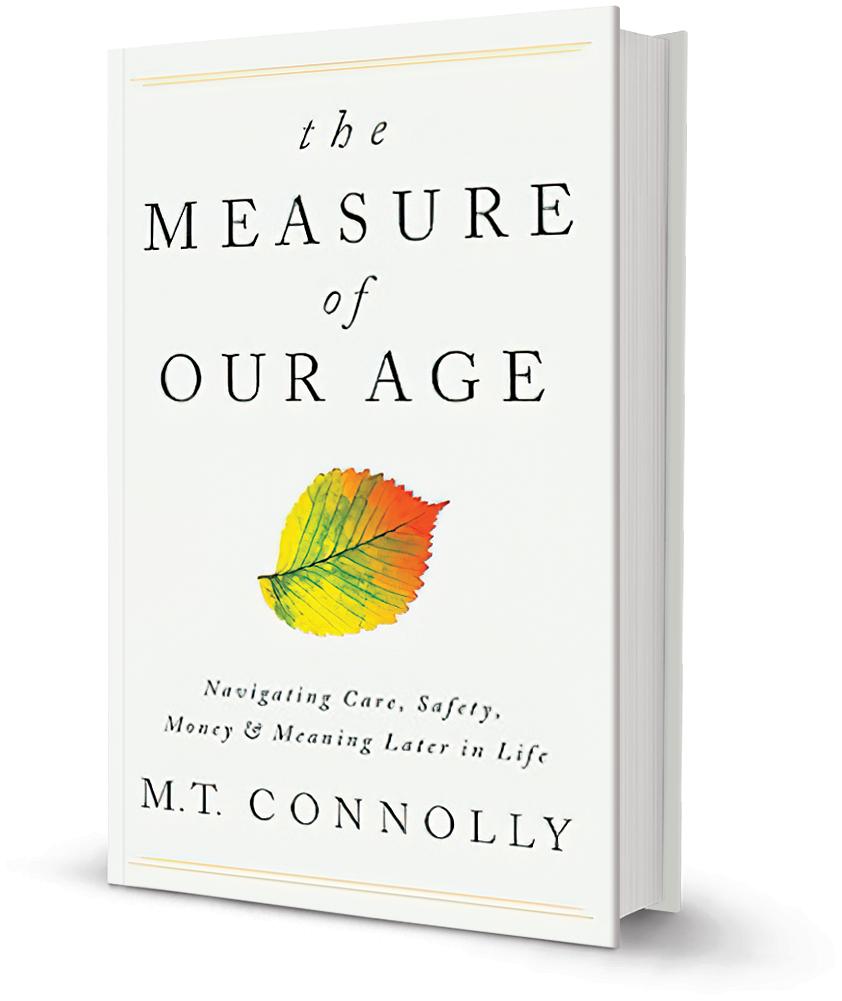
123 WORTH.COM SPRING 2024
EVENTS
WE RECOMMEND THESE EVENTS TO BRIDGE THE WINTER AND SPRING SEASONS. NO MATTER WHERE YOUR INTEREST MAY LIE, WE HAVE SOMETHING FOR YOU.

MARCH
SXSW
MARCH 8-16, AUSTIN, TX
At this SXSW, hear from a global community of creatives to understand the most important breakthroughs in technology, film, culture, and music. This year includes longrange thinking on AI, climate change, civic engagement, and more.
Artexpo New York
APRIL 4-7, NEW YORK, NY
Known as “the world’s original fine art trade show,” the Artexpo New York is a champion of the art world. Enjoy unique, immersive programs and Art Talks with leading gallerists and innovative artists. Experience unique conversations that can only be powered by creative energy.
Palm Beach International Boat Show
MARCH 21-24, WEST PALM BEACH, FL
Experience the latest in boating, yachting, and marine technology at the Palm Beach International Boat Show. See the industry’s electric and hybrid innovations across over 800 vessels on display.
AI in Finance Summit New York
APRIL 18-19, NEW YORK, NY
Understand how AI can be used across the banking, finance, and insurance sectors at the AI in Finance Summit. Hear from speakers such as Mastercard’s AI director and Vanguard’s principal AI and machine learning scientist. Learn about the various applications of the technology, from chatbots to fighting fraud.
Imagine AI Live
MARCH 27-28, LAS VEGAS, NV
Join the world’s top enterprise AI leaders, companies, tools, builders, and creators. At Imagine AI Live, get hands-on experience with the latest technology and understand how to develop an AI strategy for your business.
APRIL
Techonomy Climate
APRIL 3, MOUNTAIN VIEW, CA
Explore the future of climate solutions at Techonomy Climate 2024, where innovation meets urgency. Join experts, industry leaders, entrepreneurs, investors, and tech pioneers as we navigate the complexities of the climate crisis and unprecedented global challenges.
MAY
Groundbreaking Women Summit
MAY 9, NEW YORK, NY
Explore the intersection of wealth, leadership, and impact at the Groundbreaking Women Summit 2024 in NYC this May. Join industry leaders, entrepreneurs, and change-makers for a dynamic day of empowering conversations designed to accelerate equity in business and leadership.
Wealth Management EDGE
MAY 13-16, HOLLYWOOD, FL
Gather exclusive information, experiences, and networking opportunities with three industry-leading brands—Inside ETFs+, WealthStack, and RIA Edge—at Wealth Management Edge. Over a week, discover realworld solutions to improve advisors’ investment management, technology and practice management.
GETTY
SPRING 2024 WORTH.COM 124
Techonomy At Davos 2024
JANUARY 16-17, 2024
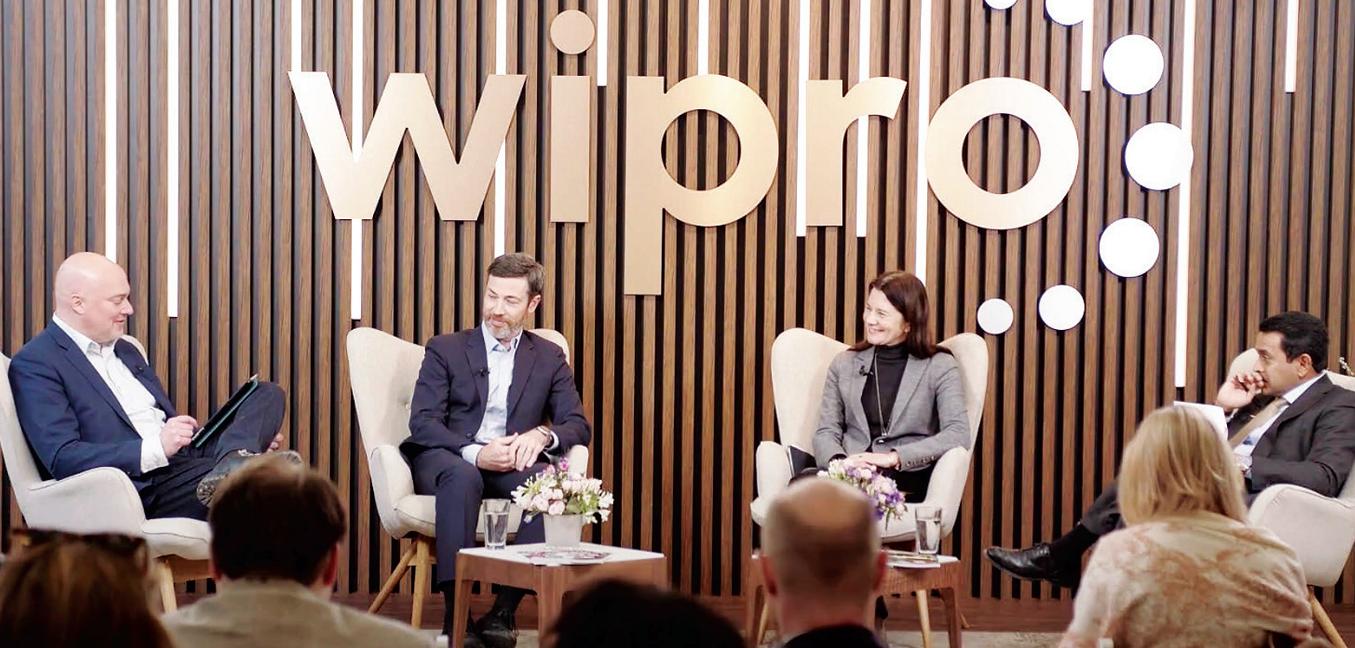


Techonomy returned to Davos with a series of events focused on how Artificial Intelligence is transforming our lives.
Worth presented Techonomy at Davos during The World Economic Forum, with a series of conversations that examined the impact of artificial intelligence on business and society. These events offered a comprehensive exploration of AI’s influence on a wide variety of topics, from marketing and business ethics to the broader landscape of cognitive work, which featured the following guest speakers:
• Alex McMullan: CTO, International, Pure Storage
• Suzanne Dann: CEO Americas, Wipro
• Raja Rajamannar: CMO, Mastercard
• Chris Foster: CEO, Omnicom PRG
• Matt McDonald: Senior Partner, President, Penta
• Ravin Jesuthasan: CFA, FRSA, Senior Partner Global Leader, Transformation Services, Mercer
• Valérie Beaulieu: Chief Sales and Marketing Officer, Adecco Group
WORTHEVENT CONVERSATIONS
1 23
1. Worth’s Dan Costa, Adecco Group’s, Valérie Beaulieu, Penta’s, Matt McDonald, and global thought leader, Ravin Jesuthasan CFA, FRSA. 2. Omnicom PR Group CEO, Chris Foster, and Worth Media Group CEO, Josh Kampel. 3. MasterCard’s Michael Miebach during Navigating the AI Revolution session with attendees.



















































































































































































































































































































 Michael Nathanson
The Colony Group
Morris Nutt Trinity Capital Management
Jason Whitby Stone Point Wealth
Nadine Gordon Lee
The Colony Group
Gary K. Liska SEIA
Tim Flatley Sterling Investment Advisors Ltd.
BY EVA CROUSE & RUTHIE KORNBLATT-STIER
Michael Nathanson
The Colony Group
Morris Nutt Trinity Capital Management
Jason Whitby Stone Point Wealth
Nadine Gordon Lee
The Colony Group
Gary K. Liska SEIA
Tim Flatley Sterling Investment Advisors Ltd.
BY EVA CROUSE & RUTHIE KORNBLATT-STIER



















































 Doug DeMuro
4.79M SUBSCRIBERS
Tyler Csatari
Doug DeMuro
4.79M SUBSCRIBERS
Tyler Csatari

 Jonathan
183K SUBSCRIBERS
Jonathan
183K SUBSCRIBERS






































































